Spring6

1 概述
1.1 Spring是什么?
Spring 是一款主流的 Java EE 轻量级开源框架 ,Spring 由“Spring 之父”Rod Johnson 提出并创立,其目的是用于简化 Java 企业级应用的开发难度和开发周期。Spring的用途不仅限于服务器端的开发。从简单性、可测试性和松耦合的角度而言,任何Java应用都可以从Spring中受益。Spring 框架除了自己提供功能外,还提供整合其他技术和框架的能力。
Spring 自诞生以来备受青睐,一直被广大开发人员作为 Java 企业级应用程序开发的首选。时至今日,Spring 俨然成为了 Java EE 代名词,成为了构建 Java EE 应用的事实标准。
自 2004 年 4 月,Spring 1.0 版本正式发布以来,Spring 已经步入到了第 6 个大版本,也就是 Spring 6。本课程采用Spring当前最新发布的正式版本6.0.2(课程时间为2022年11月)。
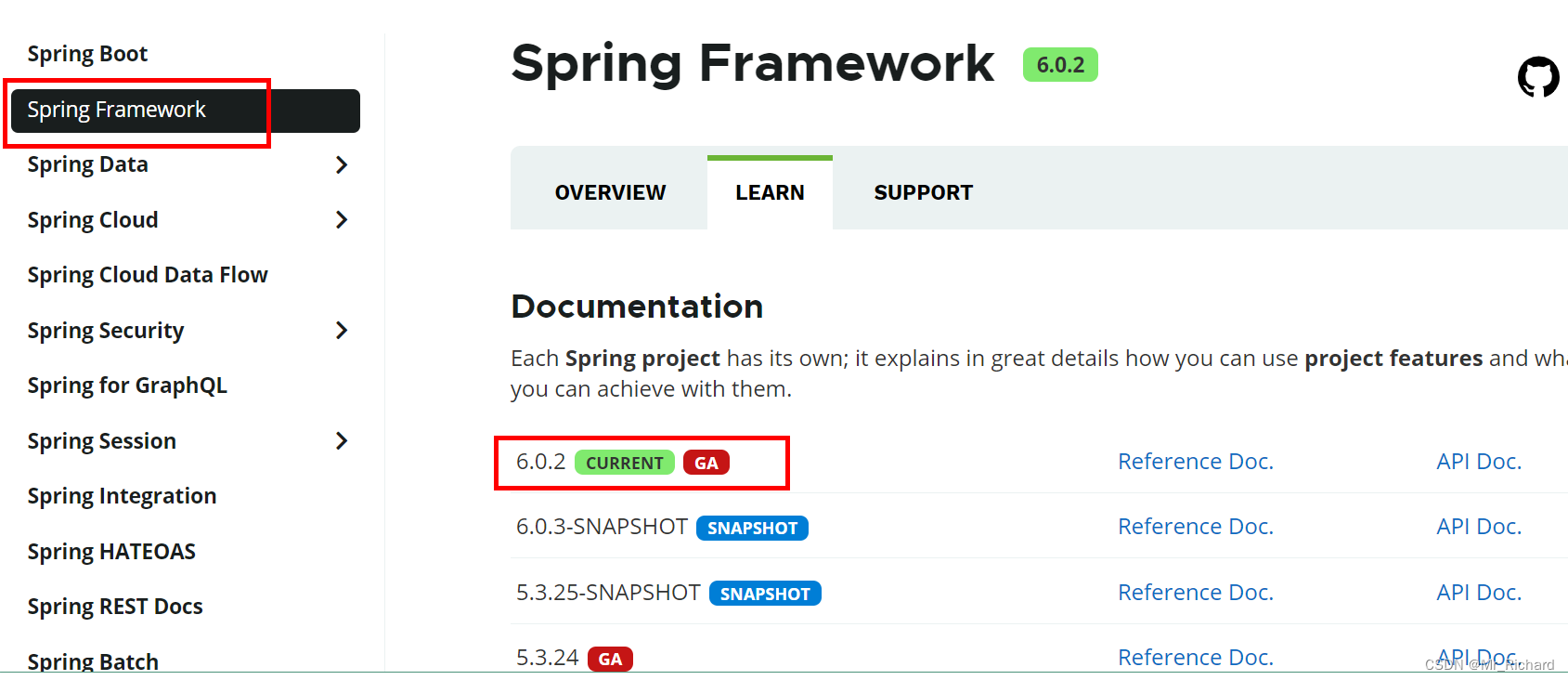
1.2 Spring 的狭义和广义
在不同的语境中,Spring 所代表的含义是不同的。下面我们就分别从“广义”和“狭义”两个角度,对 Spring 进行介绍。
广义的 Spring:Spring 技术栈
广义上的 Spring 泛指以 Spring Framework 为核心的 Spring 技术栈。
经过十多年的发展,Spring 已经不再是一个单纯的应用框架,而是逐渐发展成为一个由多个不同子项目(模块)组成的成熟技术,例如 Spring Framework、Spring MVC、SpringBoot、Spring Cloud、Spring Data、Spring Security 等,其中 Spring Framework 是其他子项目的基础。
这些子项目涵盖了从企业级应用开发到云计算等各方面的内容,能够帮助开发人员解决软件发展过程中不断产生的各种实际问题,给开发人员带来了更好的开发体验。
狭义的 Spring:Spring Framework
狭义的 Spring 特指 Spring Framework,通常我们将它称为 Spring 框架。
Spring 框架是一个分层的、面向切面的 Java 应用程序的一站式轻量级解决方案,它是 Spring 技术栈的核心和基础,是为了解决企业级应用开发的复杂性而创建的。
Spring 有两个最核心模块: IoC 和 AOP。
IoC:Inverse of Control 的简写,译为“控制反转”,指把创建对象过程交给 Spring 进行管理。
AOP:Aspect Oriented Programming 的简写,译为“面向切面编程”。AOP 用来封装多个类的公共行为,将那些与业务无关,却为业务模块所共同调用的逻辑封装起来,减少系统的重复代码,降低模块间的耦合度。另外,AOP 还解决一些系统层面上的问题,比如日志、事务、权限等。
1.3 Spring Framework特点
-
非侵入式:使用 Spring Framework 开发应用程序时,Spring 对应用程序本身的结构影响非常小。对领域模型可以做到零污染;对功能性组件也只需要使用几个简单的注解进行标记,完全不会破坏原有结构,反而能将组件结构进一步简化。这就使得基于 Spring Framework 开发应用程序时结构清晰、简洁优雅。
-
控制反转:IoC——Inversion of Control,翻转资源获取方向。把自己创建资源、向环境索取资源变成环境将资源准备好,我们享受资源注入。 -
面向切面编程:AOP——Aspect Oriented Programming,在不修改源代码的基础上增强代码功能。 -
容器:Spring IoC 是一个容器,因为它包含并且管理组件对象的生命周期。组件享受到了容器化的管理,替程序员屏蔽了组件创建过程中的大量细节,极大的降低了使用门槛,大幅度提高了开发效率。
-
组件化:Spring 实现了使用简单的组件配置组合成一个复杂的应用。在 Spring 中可以使用 XML 和 Java 注解组合这些对象。这使得我们可以基于一个个功能明确、边界清晰的组件有条不紊的搭建超大型复杂应用系统。
-
一站式:在 IoC 和 AOP 的基础上可以整合各种企业应用的开源框架和优秀的第三方类库。而且 Spring 旗下的项目已经覆盖了广泛领域,很多方面的功能性需求可以在 Spring Framework 的基础上全部使用 Spring 来实现。
1.4 Spring模块组成
官网地址:https://spring.io/
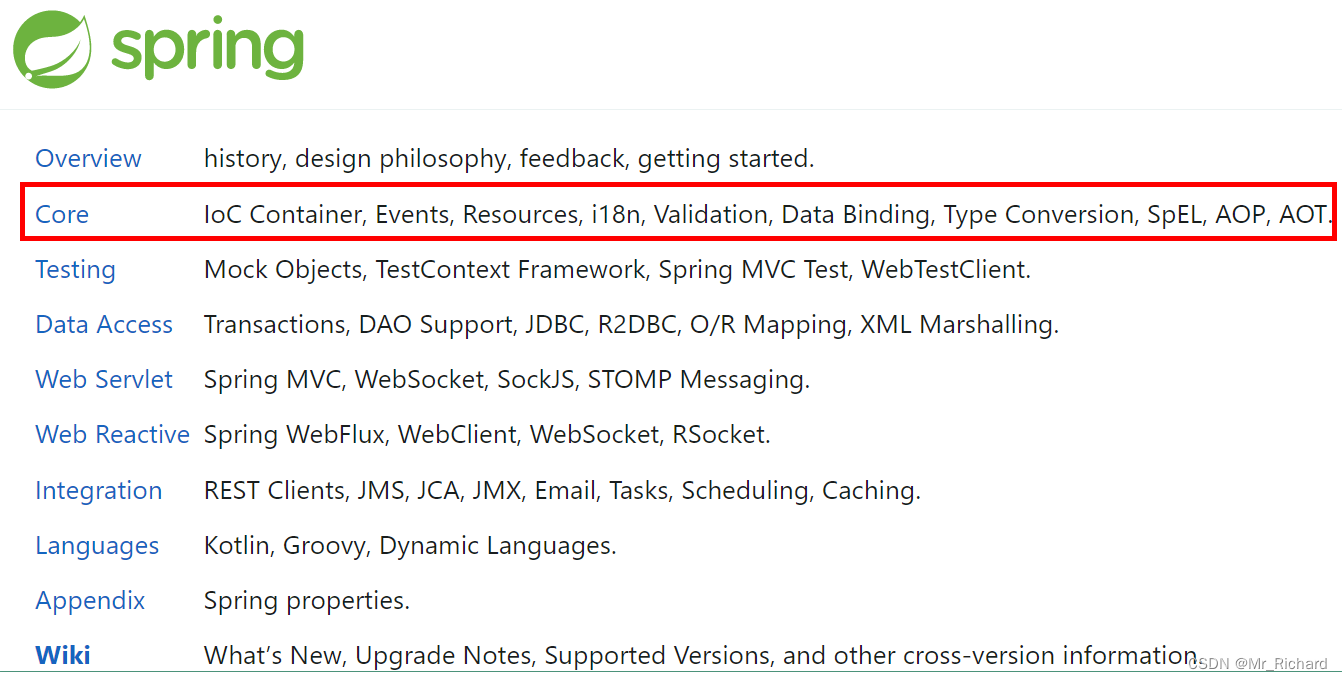

上图中包含了 Spring 框架的所有模块,这些模块可以满足一切企业级应用开发的需求,在开发过程中可以根据需求有选择性地使用所需要的模块。下面分别对这些模块的作用进行简单介绍。
①Spring Core(核心容器)
本课程的内容核心,spring core提供了IOC,DI,Bean配置装载创建的核心实现。核心概念: Beans、BeanFactory、BeanDefinitions、ApplicationContext。
-
spring-core :IOC和DI的基本实现
-
spring-beans:BeanFactory和Bean的装配管理(BeanFactory)
-
spring-context:Spring context上下文,即IOC容器(AppliactionContext)
-
spring-expression:spring表达式语言
②Spring AOP
- spring-aop:面向切面编程的应用模块,整合ASM,CGLib,JDK Proxy
- spring-aspects:集成AspectJ,AOP应用框架
- spring-instrument:动态Class Loading模块
③Spring Data Access
- spring-jdbc:spring对JDBC的封装,用于简化jdbc操作
- spring-orm:java对象与数据库数据的映射框架
- spring-oxm:对象与xml文件的映射框架
- spring-jms: Spring对Java Message Service(java消息服务)的封装,用于服务之间相互通信
- spring-tx:spring jdbc事务管理
④Spring Web
- spring-web:最基础的web支持,建立于spring-context之上,通过servlet或listener来初始化IOC容器
- spring-webmvc:实现web mvc
- spring-websocket:与前端的全双工通信协议
- spring-webflux:Spring 5.0提供的,用于取代传统java servlet,非阻塞式Reactive Web框架,异步,非阻塞,事件驱动的服务
⑤Spring Message
- Spring-messaging:spring 4.0提供的,为Spring集成一些基础的报文传送服务
⑥Spring test
- spring-test:集成测试支持,主要是对junit的封装
1.5 Spring6特点
1.5.1 版本要求
(1)Spring6要求JDK最低版本是JDK17
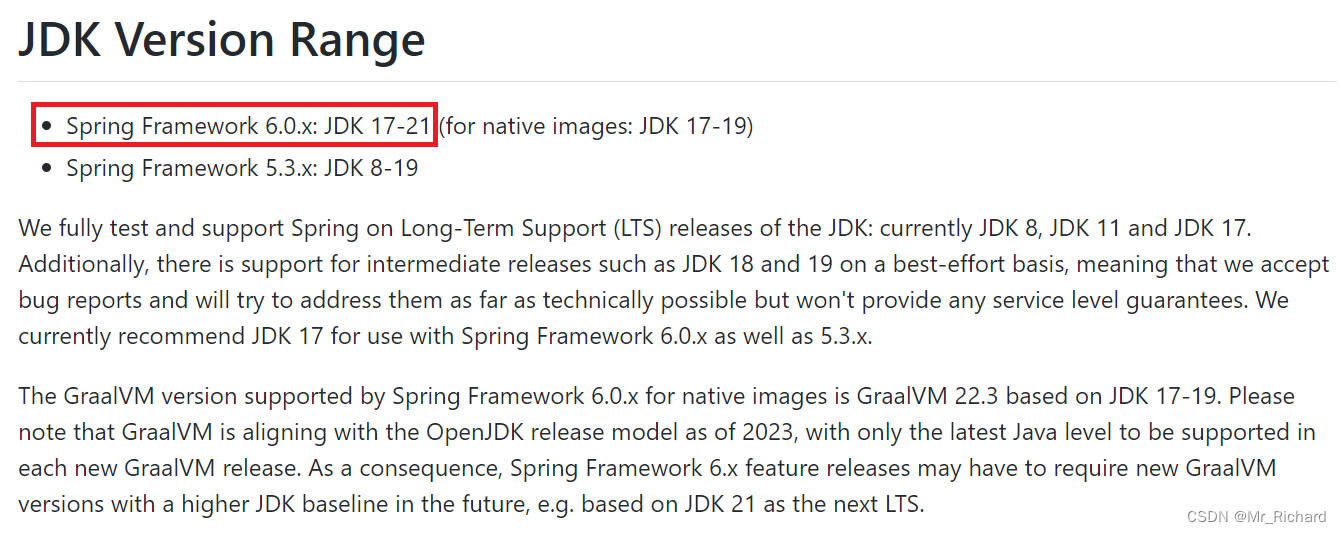
1.5.2 本课程软件版本
(1)IDEA开发工具:2022.1.2
(2)JDK:Java17**(Spring6要求JDK最低版本是Java17)**
(3)Spring:6.0.2
2 入门
2.1 环境要求
-
JDK:Java17+(Spring6要求JDK最低版本是Java17)
-
Maven:3.6+
-
Spring:6.0.2
2.2 构建模块
(1)构建父模块spring6
在idea中,依次单击 File -> New -> Project -> New Project

点击“Create”
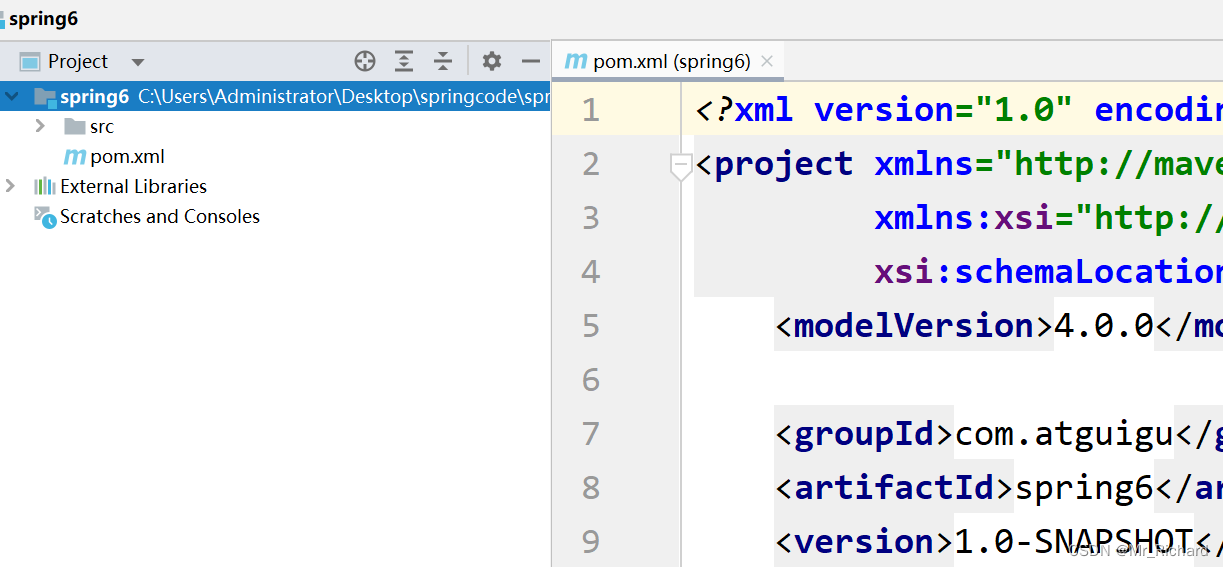
删除src目录
(2)构建子模块spring6-first
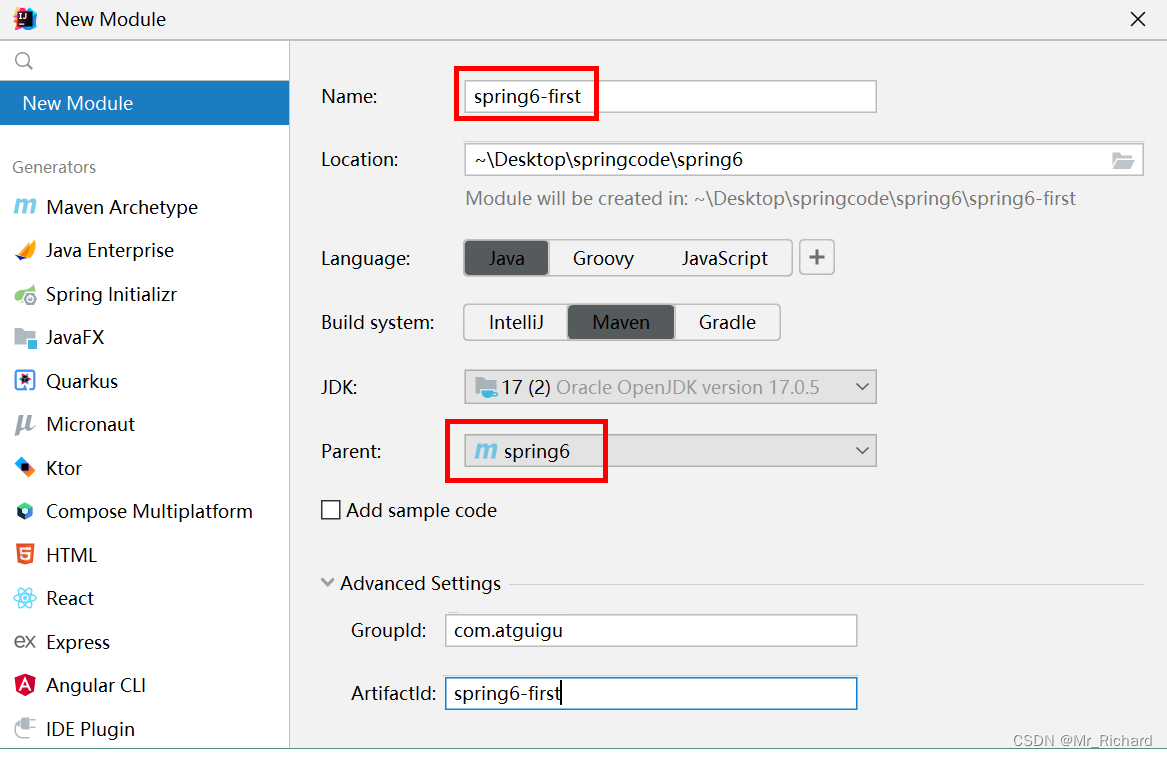
点击 Create 完成
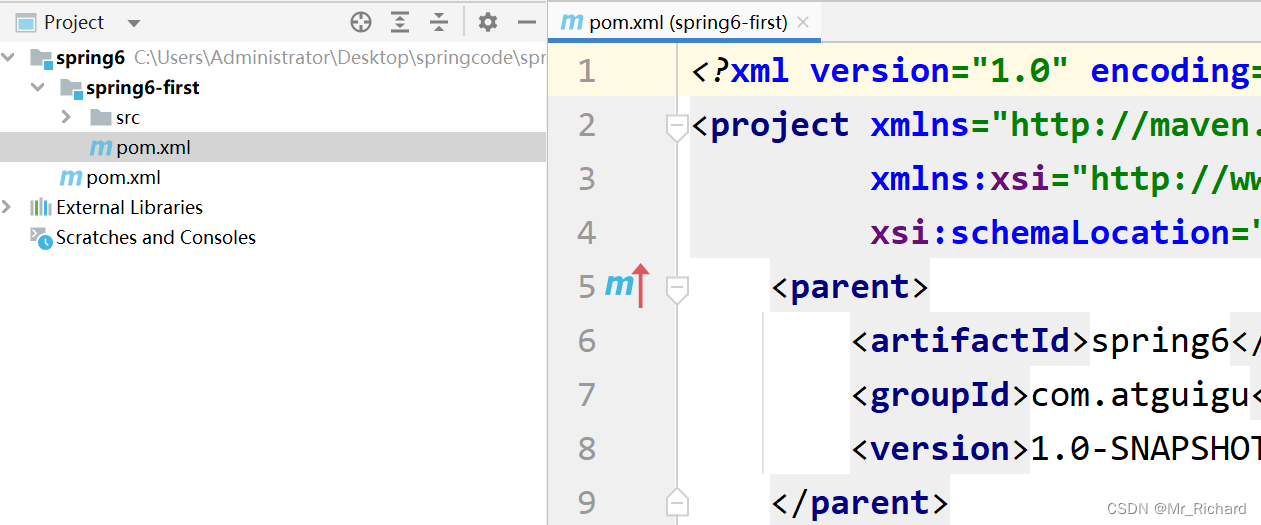
2.3 程序开发
2.3.1 引入依赖
https://spring.io/projects/spring-framework#learn
添加依赖:
<dependencies>
<!--spring context依赖-->
<!--当你引入Spring Context依赖之后,表示将Spring的基础依赖引入了-->
<dependency>
<groupId>org.springframework</groupId>
<artifactId>spring-context</artifactId>
<version>6.0.11</version>
</dependency>
<!--junit5测试-->
<dependency>
<groupId>org.junit.jupiter</groupId>
<artifactId>junit-jupiter-api</artifactId>
<version>5.9.2</version>
</dependency>
</dependencies>
查看依赖:
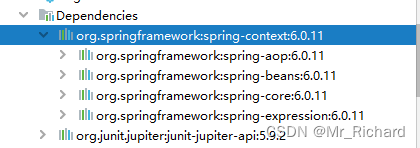
2.3.2 创建java类
package com.atguigu.spring6;
/**
* @author : Sakura
* @className : User
* @description : TODO
* @createTime : 2023-07-19 15:20:07
*/
public class User {
public void add(){
System.out.println("Adding....");
}
}
2.3.3 配置XML配置文件
在resources目录创建一个 Spring 配置文件 beans.xml(配置文件名称可随意命名,如:springs.xm)
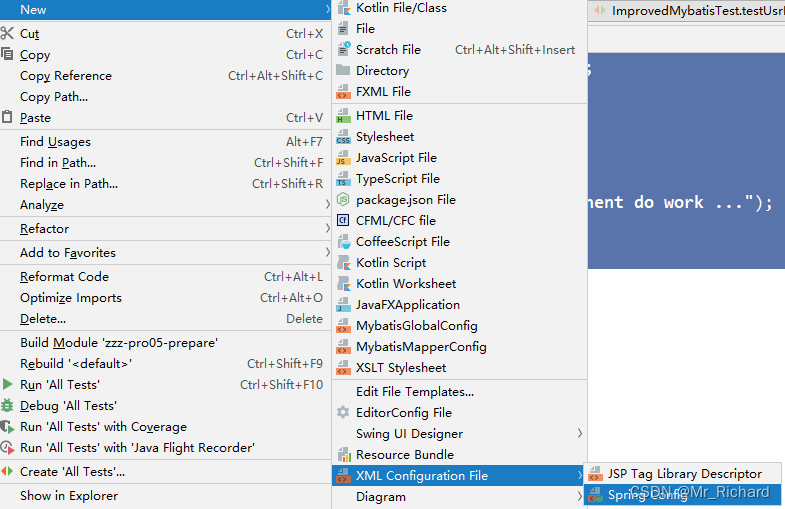
<?xml version="1.0" encoding="UTF-8"?>
<beans xmlns="http://www.springframework.org/schema/beans"
xmlns:xsi="http://www.w3.org/2001/XMLSchema-instance"
xsi:schemaLocation="http://www.springframework.org/schema/beans http://www.springframework.org/schema/beans/spring-beans.xsd">
<!--
配置文件中完成User对象创建:
bean标签
id属性:bean的唯一标识,一般是类名小写
class属性
-->
<bean id="user" class="com.atguigu.spring6.User"/>
</beans>
2.3.4 创建测试类测试
package com.atguigu.spring6;
import org.junit.jupiter.api.Test;
import org.springframework.context.support.ClassPathXmlApplicationContext;
/**
* @author : Sakura
* @className : TestUser
* @description : TODO
* @createTime : 2023-07-19 15:24:20
*/
public class TestUser {
@Test
public void testUser(){
// 1.加载Spring配置文件,默认根路径为resources文件夹
ClassPathXmlApplicationContext applicationContext = new ClassPathXmlApplicationContext("bean.xml");
// 2.获取创建的对象
User user = (User) applicationContext.getBean("user");
System.out.println(user);
// 3.调用对象的方法进行测试
user.add();
}
}
2.3.5 运行测试程序

2.4 程序分析
1. 底层是怎么创建对象的,是通过反射机制调用无参数构造方法吗?
修改User类:
package com.atguigu.spring6;
/**
* @author : Sakura
* @className : User
* @description : TODO
* @createTime : 2023-07-19 15:20:07
*/
public class User {
public User(){
System.out.println("调用了User类的无参构造器...");
}
public void add(){
System.out.println("Adding....");
}
}
执行结果:

测试得知:创建对象时确实调用了User类的无参构造器。
2. Spring是如何创建对象的呢?原理是什么?
// dom4j解析beans.xml文件,从中获取class属性值,类的全类名
// 通过反射机制调用无参数构造方法创建对象
@Test
public void testReflection() throws ClassNotFoundException, NoSuchMethodException, InvocationTargetException, InstantiationException, IllegalAccessException {
// 使用反射根据全类名创建对象
Class<?> clazz = Class.forName("com.atguigu.spring6.User");
// clazz.newInstance() JDk8该方法可用,JDK9之后已过时
User user= (User) clazz.getDeclaredConstructor().newInstance();
System.out.println(user);
}
3. 把创建好的对象存储到一个什么样的数据结构当中了呢?
bean对象最终存储在spring容器中,在spring源码底层就是一个map集合(名为beanDefinitionMap),存储bean的map在DefaultListableBeanFactory类中:
/** Map of bean definition objects, keyed by bean name. */
private final Map<String, BeanDefinition> beanDefinitionMap = new ConcurrentHashMap<>(256);
Spring容器加载到Bean类时 , 会把这个类的描述信息, 以包名加类名的方式存到beanDefinitionMap 中,
Map<String,BeanDefinition> , 其中 String是Key ,作为bean的唯一标识 默认是类名首字母小写 ; BeanDefinition为Value, 表示类的定义(描述信息) , 我们通常叫BeanDefinition接口为 : bean的定义对象。

2.5 启用Log4j2日志框架
2.5.1 Log4j2日志概述
在项目开发中,日志十分的重要,不管是记录运行情况还是定位线上问题,都离不开对日志的分析。日志记录了系统行为的时间、地点、状态等相关信息,能够帮助我们了解并监控系统状态,在发生错误或者接近某种危险状态时能够及时提醒我们处理,同时在系统产生问题时,能够帮助我们快速的定位、诊断并解决问题。
Apache Log4j2是一个开源的日志记录组件,使用非常的广泛。在工程中以易用方便代替了 System.out 等打印语句,它是JAVA下最流行的日志输入工具。
Log4j2主要由几个重要的组件构成:
(1)日志信息的优先级,日志信息的优先级从高到低有TRACE < DEBUG < INFO < WARN < ERROR < FATAL
TRACE:追踪,是最低的日志级别,相当于追踪程序的执行
DEBUG:调试,一般在开发中,都将其设置为最低的日志级别
INFO:信息,输出重要的信息,使用较多
WARN:警告,输出警告的信息
ERROR:错误,输出错误信息
FATAL:严重错误
这些级别分别用来指定这条日志信息的重要程度;级别高的会自动屏蔽级别低的日志 。也就是说,设置了WARN的日志,则INFO、DEBUG的日志级别的日志不会显示
(2)日志信息的输出目的地,日志信息的输出目的地指定了日志将打印到控制台还是文件中;
(3)日志信息的输出格式,而输出格式则控制了日志信息的显示内容。
2.5.2 引入Log4j2依赖
<!--log4j2的依赖-->
<dependency>
<groupId>org.apache.logging.log4j</groupId>
<artifactId>log4j-core</artifactId>
<version>2.19.0</version>
</dependency>
<dependency>
<groupId>org.apache.logging.log4j</groupId>
<artifactId>log4j-slf4j2-impl</artifactId>
<version>2.19.0</version>
</dependency>
2.5.3 加入日志配置文件
在类的根路径下提供log4j2.xml配置文件(文件名固定为:log4j2.xml,文件必须放到类根路径下。)
<?xml version="1.0" encoding="UTF-8"?>
<configuration>
<loggers>
<!--
level指定日志级别,从低到高的优先级:
TRACE < DEBUG < INFO < WARN < ERROR < FATAL
trace:追踪,是最低的日志级别,相当于追踪程序的执行
debug:调试,一般在开发中,都将其设置为最低的日志级别
info:信息,输出重要的信息,使用较多
warn:警告,输出警告的信息
error:错误,输出错误信息
fatal:严重错误
-->
<root level="DEBUG">
<appender-ref ref="spring6log"/>
<appender-ref ref="RollingFile"/>
<appender-ref ref="log"/>
</root>
</loggers>
<appenders>
<!--输出日志信息到控制台-->
<console name="spring6log" target="SYSTEM_OUT">
<!--控制日志输出的格式-->
<PatternLayout pattern="%d{yyyy-MM-dd HH:mm:ss SSS} [%t] %-3level %logger{1024} - %msg%n"/>
</console>
<!--文件会打印出所有信息,这个log每次运行程序会自动清空,由append属性决定,适合临时测试用-->
<File name="log" fileName="d:/spring6_log/test.log" append="false">
<PatternLayout pattern="%d{HH:mm:ss.SSS} %-5level %class{36} %L %M - %msg%xEx%n"/>
</File>
<!-- 这个会打印出所有的信息,
每次大小超过size,
则这size大小的日志会自动存入按年份-月份建立的文件夹下面并进行压缩,
作为存档-->
<RollingFile name="RollingFile" fileName="d:/spring6_log/app.log"
filePattern="log/$${date:yyyy-MM}/app-%d{MM-dd-yyyy}-%i.log.gz">
<PatternLayout pattern="%d{yyyy-MM-dd 'at' HH:mm:ss z} %-5level %class{36} %L %M - %msg%xEx%n"/>
<SizeBasedTriggeringPolicy size="50MB"/>
<!-- DefaultRolloverStrategy属性如不设置,
则默认为最多同一文件夹下7个文件,这里设置了20 -->
<DefaultRolloverStrategy max="20"/>
</RollingFile>
</appenders>
</configuration>
2.5.4 测试
运行原测试程序

运行原测试程序,多了spring打印日志
2023-07-19 16:52:36 538 [main] DEBUG org.springframework.beans.factory.support.DefaultListableBeanFactory - Creating shared instance of singleton bean ‘user’
创建的bean是单例模式的
2.5.5 使用日志
import org.slf4j.Logger;
import org.slf4j.LoggerFactory;
public class TestUser {
// 创建log对象
private Logger logger = LoggerFactory.getLogger(TestUser.class);
@Test
public void testUser(){
// 1.加载Spring配置文件,默认根路径为resources文件夹
ClassPathXmlApplicationContext applicationContext = new ClassPathXmlApplicationContext("bean.xml");
// 2.获取创建的对象
User user = (User) applicationContext.getBean("user");
System.out.println(user);
// 3.调用对象的方法进行测试
user.add();
// 测试日志写入
logger.info("执行info日志写入...");
}
}
控制台:

3 容器:IoC
IoC 是 Inversion of Control 的简写,译为“控制反转”,它不是一门技术,而是一种设计思想,是一个重要的面向对象编程法则,能够指导我们如何设计出松耦合、更优良的程序。
Spring 通过 IoC 容器来管理所有 Java 对象的实例化和初始化,控制对象与对象之间的依赖关系。我们将由 IoC 容器管理的 Java 对象称为 Spring Bean,它与使用关键字 new 创建的 Java 对象没有任何区别。
IoC 容器是 Spring 框架中最重要的核心组件之一,它贯穿了 Spring 从诞生到成长的整个过程。
3.1 IoC容器
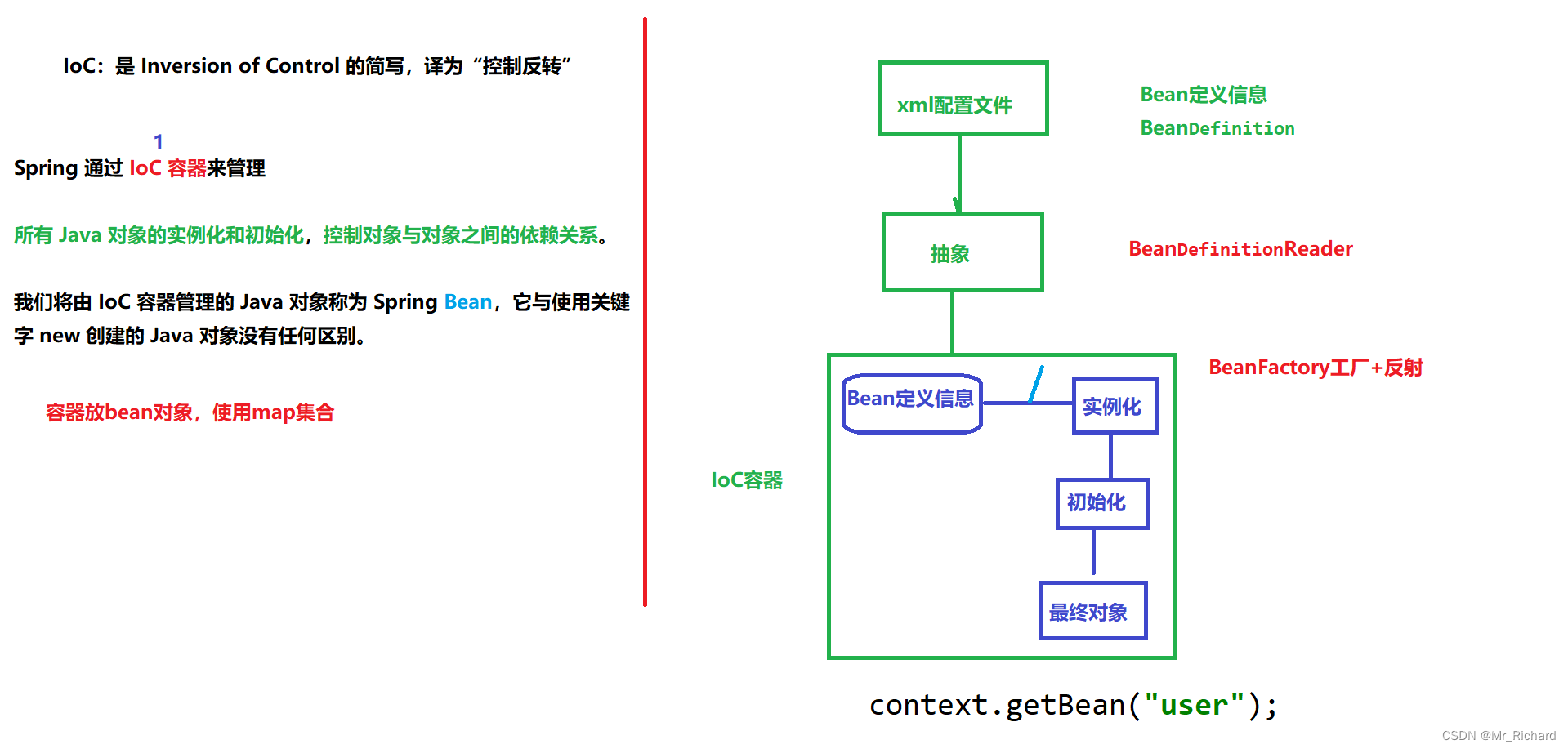
3.1.1 控制反转(IoC)
-
控制反转是一种思想。
-
控制反转是为了
降低程序耦合度,提高程序扩展性。 -
控制反转,反转的是什么?
-
- 将
对象的创建权利交出去,交给第三方容器负责。 - 将
对象和对象之间关系的维护权交出去,交给第三方容器负责。
- 将
-
控制反转这种思想如何实现呢?
-
DI(Dependency Injection):依赖注入
3.1.2 依赖注入(DI)
DI(Dependency Injection):依赖注入,简单理解为配置对象属性,依赖注入实现了控制反转的思想。
依赖注入:
- 指
Spring创建对象的过程中,将对象依赖属性通过配置进行注入
依赖注入常见的实现方式包括两种:
- 第一种:setter注入
- 第二种:构造注入
所以结论是:IOC 就是一种控制反转的思想, 而 DI 是对IoC的一种具体实现。
Bean管理说的是:Bean对象的创建,以及Bean对象中属性的赋值(或者叫做Bean对象之间关系的维护)。
3.1.3 IoC容器在Spring的实现
Spring 的 IoC 容器就是 IoC思想的一个落地的产品实现。IoC容器中管理的组件也叫做 bean。在创建 bean 之前,首先需要创建IoC 容器。Spring 提供了IoC 容器的两种实现方式:
① BeanFactory
这是 IoC 容器的基本实现,是 Spring 内部使用的接口。面向 Spring 本身,不提供给开发人员使用。
② ApplicationContext
BeanFactory 的子接口,提供了更多高级特性。面向 Spring 的使用者,几乎所有场合都使用 ApplicationContext 而不是底层的 BeanFactory。
③ApplicationContext的主要实现类
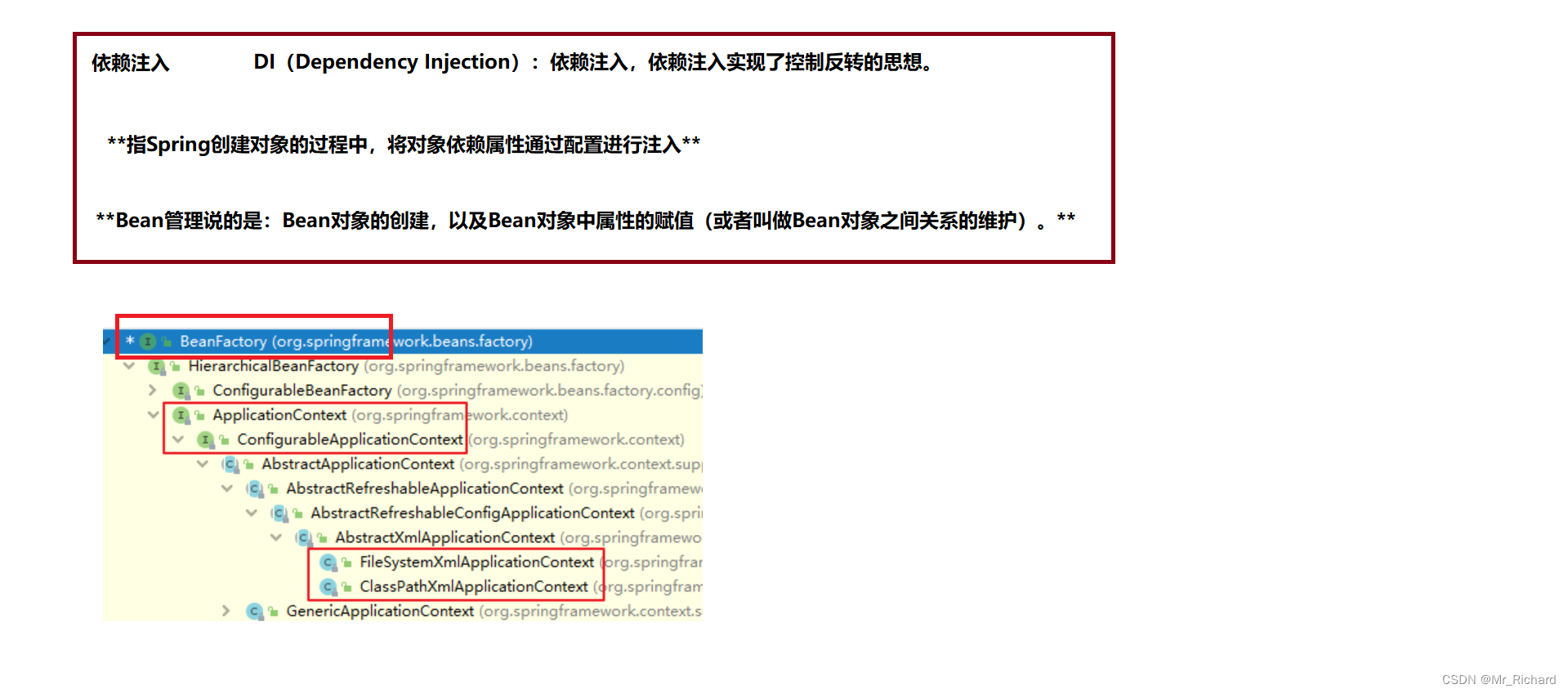
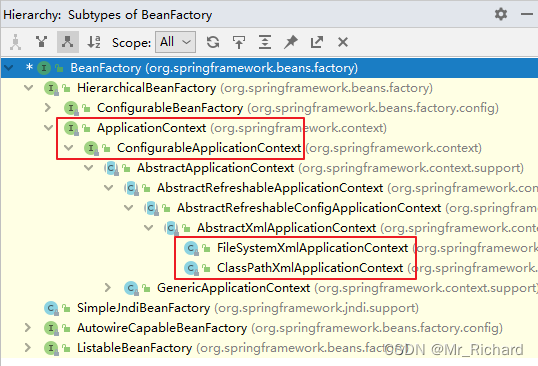
| 类型名 | 简介 |
|---|---|
| ClassPathXmlApplicationContext | 通过读取类路径下的 XML 格式的配置文件创建 IOC 容器对象 |
| FileSystemXmlApplicationContext | 通过文件系统路径读取 XML 格式的配置文件创建 IOC 容器对象 |
| ConfigurableApplicationContext | ApplicationContext 的子接口,包含一些扩展方法 refresh() 和 close() ,让 ApplicationContext 具有启动、关闭和刷新上下文的能力。 |
| WebApplicationContext | 专门为 Web 应用准备,基于 Web 环境创建 IOC 容器对象,并将对象引入存入 ServletContext 域中。 |
3.2 基于XML管理Bean
3.2.1 搭建子模块spring6-ioc-xml
①搭建模块
搭建方式如:spring-first
②引入配置文件
引入spring-first模块配置文件:beans.xml、log4j2.xml
③添加依赖
<dependencies>
<!--spring context依赖-->
<!--当你引入Spring Context依赖之后,表示将Spring的基础依赖引入了-->
<dependency>
<groupId>org.springframework</groupId>
<artifactId>spring-context</artifactId>
<version>6.0.11</version>
</dependency>
<!--junit5测试-->
<dependency>
<groupId>org.junit.jupiter</groupId>
<artifactId>junit-jupiter-api</artifactId>
<version>5.9.2</version>
</dependency>
<!--log4j2的依赖-->
<dependency>
<groupId>org.apache.logging.log4j</groupId>
<artifactId>log4j-core</artifactId>
<version>2.19.0</version>
</dependency>
<dependency>
<groupId>org.apache.logging.log4j</groupId>
<artifactId>log4j-slf4j2-impl</artifactId>
<version>2.19.0</version>
</dependency>
</dependencies>
④创建User实体类
创建User实体类
package com.atguigu.ioc.xml;
/**
* @author : Sakura
* @className : User
* @description : TODO
* @createTime : 2023-07-19 16:38:07
*/
public class User {
private String name;
private Integer age;
public void run(){
System.out.println("run....");
}
@Override
public String toString() {
return "User{" +
"name='" + name + '\'' +
", age=" + age +
'}';
}
}
3.2.2 实验一:获取bean
①方式一:根据id获取
由于 id 属性指定了 bean 的唯一标识,所以根据 bean 标签的 id 属性可以精确获取到一个组件对象。上个实验中我们使用的就是这种方式。
/**
* 根据id获取bean,bean的id属性能唯一标识
*/
@Test
public void testUser1() {
ClassPathXmlApplicationContext context = new ClassPathXmlApplicationContext("bean.xml");
User user = (User) context.getBean("user");
System.out.println("根据id获取bean:" + user);
}
②方式二:根据类型获取
/**
* 根据类型获取bean
*/
@Test
public void testUser2() {
ClassPathXmlApplicationContext context = new ClassPathXmlApplicationContext("bean.xml");
User user = context.getBean(User.class);
System.out.println("根据类型获取bean:" + user);
}
③方式三:根据id和类型
/**
* 根据id和类型获取bean
*/
@Test
public void testUser3() {
ClassPathXmlApplicationContext context = new ClassPathXmlApplicationContext("bean.xml");
User user = context.getBean("user", User.class);
System.out.println("根据id和类型获取bean:" + user);
}
④注意的地方
当根据类型获取bean时,要求IOC容器中指定类型的bean有且只能有一个
当IOC容器中一共配置了两个:
<!-- 创建User对象-->
<bean id="user" class="com.atguigu.ioc.xml.User">
</bean>
<bean id="user2" class="com.atguigu.ioc.xml.User">
</bean>
根据类型获取时会抛出异常:
org.springframework.beans.factory.NoUniqueBeanDefinitionException: No qualifying bean of type ‘com.atguigu.ioc.xml.User’ available: expected single matching bean but found 2: user,user2
⑤扩展知识
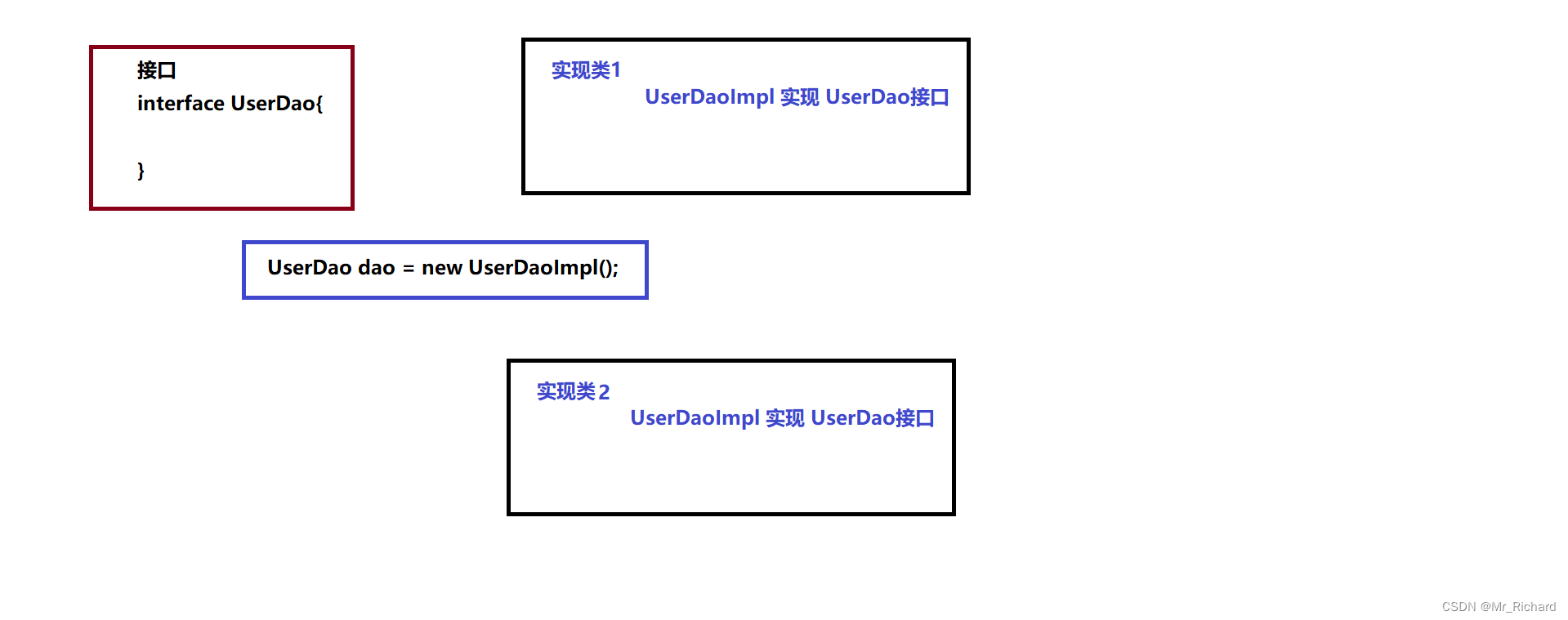
如果组件类实现了接口,根据接口类型可以获取 组件类的bean 吗?
可以,前提是bean唯一
如果一个接口有多个实现类且同时配置了 bean,根据接口类型可以获取 bean 吗?
不行,因为bean不唯一,会报异常:org.springframework.beans.factory.NoUniqueBeanDefinitionException
结论
根据类型来获取bean时,在满足bean唯一性的前提下,其实只是看:『对象 instanceof 指定的类型』的返回结果,只要返回的是true就可以认定为和类型匹配,能够获取到。
java中,instanceof运算符用于判断前面的对象是否是后面的类,或其子类、实现类的实例。如果是返回true,否则返回false。也就是说:用instanceof关键字做判断时, instanceof 操作符的左右操作必须有继承或实现关系
3.2.3 实验二:依赖注入之setter注入
①创建学生类Student
package com.atguigu.ioc.xml.di;
/**
* @author : Sakura
* @className : Book
* @description : TODO
* @createTime : 2023-07-19 17:18:32
*/
public class Book {
private String bookName;
private String author;
// 属性的getter、setter方法
public String getBookName() {
return bookName;
}
public void setBookName(String bookName) {
this.bookName = bookName;
}
public String getAuthor() {
return author;
}
public void setAuthor(String author) {
this.author = author;
}
// 生成构造器
public Book(String bookName, String author) {
this.bookName = bookName;
this.author = author;
}
public Book(){
}
@Override
public String toString() {
return "Book{" +
"bookName='" + bookName + '\'' +
", author='" + author + '\'' +
'}';
}
}
②配置bean时为属性赋值
bean-di.xml
<?xml version="1.0" encoding="UTF-8"?>
<beans xmlns="http://www.springframework.org/schema/beans"
xmlns:xsi="http://www.w3.org/2001/XMLSchema-instance"
xsi:schemaLocation="http://www.springframework.org/schema/beans http://www.springframework.org/schema/beans/spring-beans.xsd">
<!--基于setter方式实现依赖注入-->
<bean id="book" class="com.atguigu.ioc.xml.di.Book">
<!-- property标签:通过组件类的setXxx()方法给组件对象设置属性 -->
<!-- name属性:指定属性名(这个属性名是getXxx()、setXxx()方法定义的,和成员变量无关) -->
<!-- value属性:指定属性值 -->
<property name="bookName" value="Spring6入门教程"/>
<property name="author" value="王泽"/>
</bean>
</beans>
③测试
@Test
public void test(){
ClassPathXmlApplicationContext applicationContext = new ClassPathXmlApplicationContext("bean-di.xml");
Book book = applicationContext.getBean("book", Book.class);
System.out.println(book);
}

3.2.4 实验三:依赖注入之构造器注入
①在Student类中添加有参构造
②配置bean
bean-di.xml
<!--基于构造器方式实现依赖注入-->
<bean id="book2" class="com.atguigu.ioc.xml.di.Book">
<!-- constructor-arg:通过组件类的有参构造器给组件对象设置属性 -->
<!-- name属性:指定属性名 -->
<!-- index属性:指定有参构造器中的参数索引 -->
<!-- value属性:指定属性值 -->
<!-- <constructor-arg index="1" value="王泽"/>-->
<!-- <constructor-arg index="0" value="Spring6入门教程"/>-->
<constructor-arg name="author" value="王泽"/>
<constructor-arg name="bookName" value="Spring6入门教程"/>
</bean>
注意:
constructor-arg标签还有两个属性可以进一步描述构造器参数:
- index属性:指定参数所在位置的索引(从0开始)
- name属性:指定参数名
③测试
@Test
public void test2(){
ClassPathXmlApplicationContext applicationContext = new ClassPathXmlApplicationContext("bean-di.xml");
Book book = applicationContext.getBean("book2", Book.class);
System.out.println(book);
}
3.2.5 实验四:特殊值处理
①字面量赋值
什么是字面量?
int a = 10;
声明一个变量a,初始化为10,此时a就不代表字母a了,而是作为一个变量的名字。当我们引用a的时候,我们实际上拿到的值是10。
而如果a是带引号的:‘a’,那么它现在不是一个变量,它就是代表a这个字母本身,这就是
字面量。所以字面量没有引申含义,就是我们看到的这个数据本身。
<!-- 使用value属性给bean的属性赋值时,Spring会把value属性的值看做字面量 -->
<property name="name" value="张三"/>
②null值
<property name="name">
<null />
</property>
注意:
<property name="name" value="null"></property>以上写法,为name所赋的值是字符串"null"
③xml实体
<!-- 小于号在XML文档中用来定义标签的开始,不能随便使用 -->
<!-- 解决方案一:使用XML实体来代替 -->
<property name="expression" value="a < b"/>
小于 : <
大于 : >
小于等于 : ≤
大于等于 : ≥
④CDATA节
<property name="expression">
<!-- 解决方案二:使用CDATA节 -->
<!-- CDATA中的C代表Character,是文本、字符的含义,CDATA就表示纯文本数据 -->
<!-- XML解析器看到CDATA节就知道这里是纯文本,就不会当作XML标签或属性来解析 -->
<!-- 所以CDATA节中写什么符号都随意 -->
<value><![CDATA[a < b]]></value>
</property>
3.2.6 实验五:为对象类型属性赋值
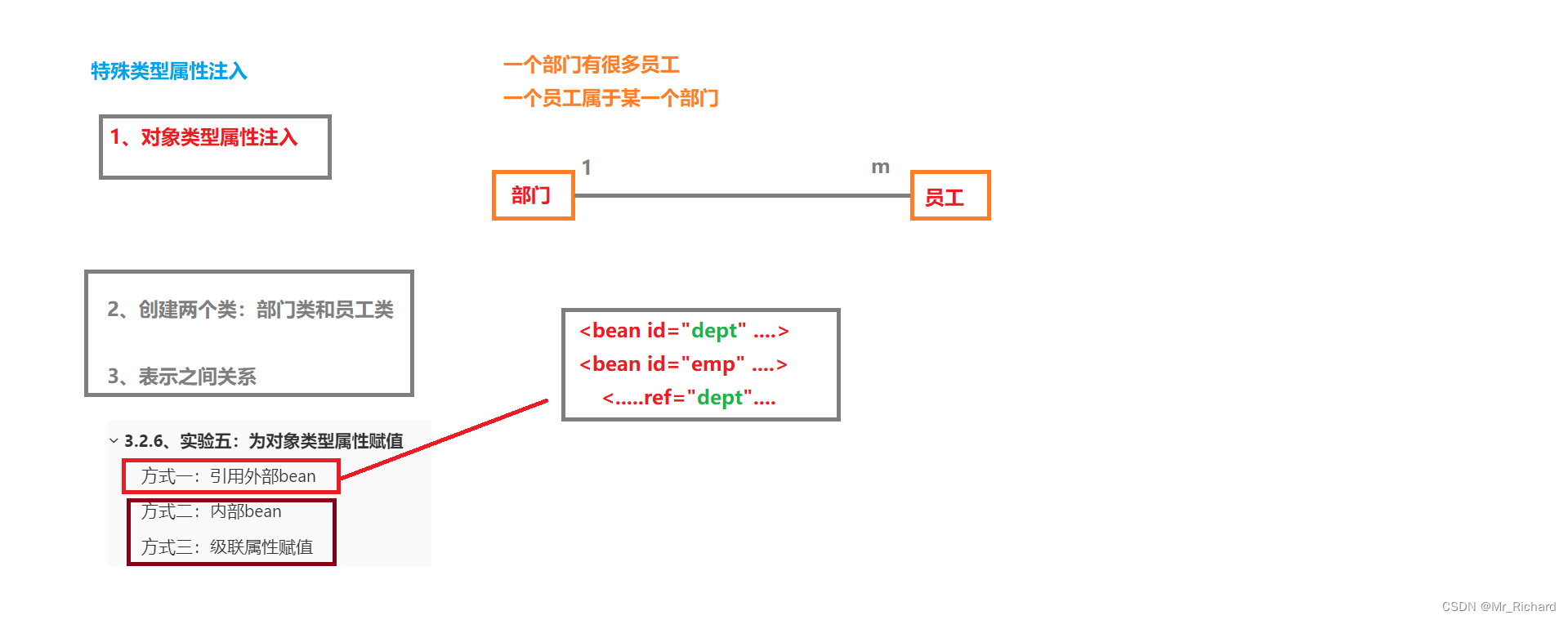
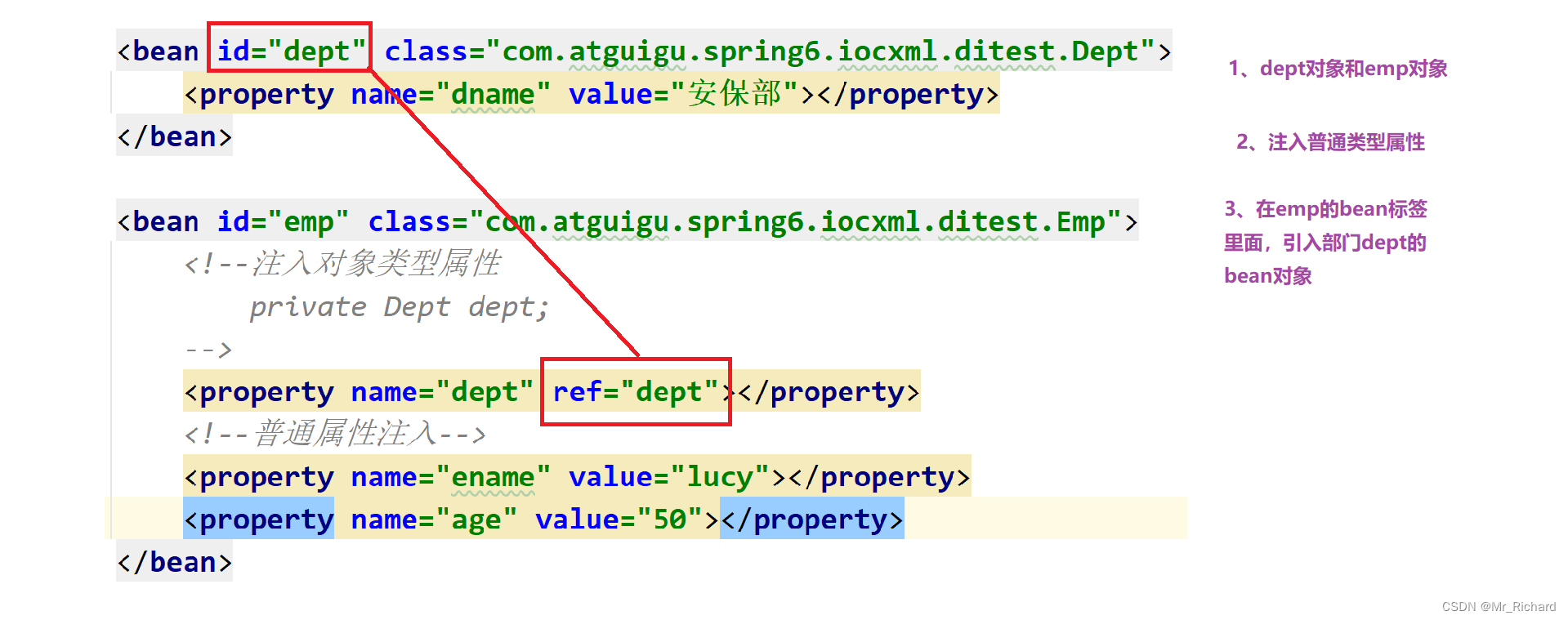
①创建部门类Department
package com.atguigu.ioc.xml.di2;
/**
* @author : Sakura
* @className : Dept
* @description : TODO
* @createTime : 2023-07-19 19:23:17
*/
public class Department {
private String dName;
public String getdName() {
return dName;
}
public void setdName(String dName) {
this.dName = dName;
}
void info() {
System.out.println("部门名称:" + dName);
}
@Override
public String toString() {
return "Department{" +
"dName='" + dName + '\'' +
'}';
}
}
②创建Employee类
package com.atguigu.ioc.xml.di2;
import java.util.Objects;
/**
* @author : Sakura
* @className : Employee
* @description : TODO
* @createTime : 2023-07-19 19:23:26
*/
public class Employee {
private String eName;
private Integer age;
/** 员工所属部门 */
private Department department;
public String geteName() {
return eName;
}
public void seteName(String eName) {
this.eName = eName;
}
public Integer getAge() {
return age;
}
public void setAge(Integer age) {
this.age = age;
}
public Department getDepartment() {
return department;
}
public void setDepartment(Department department) {
this.department = department;
}
public void work() {
System.out.println(eName + "正在工作...age="+age);
department.info();
}
@Override
public int hashCode() {
return Objects.hash(eName, age, department);
}
@Override
public String toString() {
return "Employee{" +
"eName='" + eName + '\'' +
", age=" + age +
", department=" + department +
'}';
}
}
方式一:引用外部bean
配置Department类型的bean:
<bean name="dept" class="com.atguigu.ioc.xml.di2.Department">
<property name="dName" value="财务部"/>
</bean>
为Employee中的department属性赋值:
<!-- 1.引用外部bean -->
<bean name="employee" class="com.atguigu.ioc.xml.di2.Employee">
<!--普通属性注入-->
<property name="age" value="15"/>
<property name="eName" value="张三"/>
<!--对象类型属性注入-->
<property name="department" ref="dept"/>
</bean>
如果错把ref属性写成了value属性,会抛出异常: Caused by: java.lang.IllegalStateException
value标签赋值,ref标签引用
方式二:内部bean
<!-- 2.创建内部bean -->
<bean name="employee2" class="com.atguigu.ioc.xml.di2.Employee">
<!--普通属性注入-->
<property name="age" value="15"/>
<property name="eName" value="张三"/>
<!--对象类型属性注入-->
<property name="department">
<!-- 在一个bean中再声明一个bean就是内部bean -->
<!-- 内部bean只能用于给属性赋值,不能在外部通过IOC容器获取,因此可以省略id属性 -->
<bean id="dept2" class="com.atguigu.ioc.xml.di2.Department">
<property name="dName" value="事业部"/>
</bean>
</property>
</bean>
方式三:级联属性赋值
<!-- 3.级联属性赋值 -->
<bean id="dept3" class="com.atguigu.ioc.xml.di2.Department">
<property name="dName" value="人事部"/>
</bean>
<bean name="employee3" class="com.atguigu.ioc.xml.di2.Employee">
<!--普通属性注入-->
<property name="age" value="15"/>
<property name="eName" value="张三"/>
<!--对象类型属性注入-->
<property name="department" ref="dept3"/>
<!--department属性的dName属性以此处为准-->
<property name="department.dName" value="测试部"/>
</bean>
3.2.7 实验六:为数组类型属性赋值
①修改Employee类
在Employee类中添加以下代码:
private String[] hobbies;
public String[] getHobbies() {
return hobbies;
}
public void setHobbies(String[] hobbies) {
this.hobbies = hobbies;
}
@Override
public String toString() {
return "Employee{" +
"eName='" + eName + '\'' +
", age=" + age +
", hobbiess=" + Arrays.toString(hobbiess) +
", department=" + department +
'}';
}
②配置bean
bean-di-list.xml
<?xml version="1.0" encoding="UTF-8"?>
<beans xmlns="http://www.springframework.org/schema/beans"
xmlns:xsi="http://www.w3.org/2001/XMLSchema-instance"
xsi:schemaLocation="http://www.springframework.org/schema/beans http://www.springframework.org/schema/beans/spring-beans.xsd">
<bean name="dept" class="com.atguigu.ioc.xml.di2.Department">
<property name="dName" value="财务部"/>
</bean>
<!-- 1.引用外部bean -->
<bean name="employee" class="com.atguigu.ioc.xml.di2.Employee">
<!--普通属性注入-->
<property name="age" value="15"/>
<property name="eName" value="张三"/>
<!--对象类型属性注入-->
<property name="department" ref="dept"/>
<!--数组类型属性注入-->
<property name="hobbiess">
<array>
<!-- 元素为基本数据类型,使用value标签 -->
<value>抽烟</value>
<value>喝酒</value>
<value>吃肥肉</value>
<!-- 元素为引用数据类型,使用ref标签 -->
<!-- <ref bean="emp1" />-->
</array>
</property>
</bean>
</beans>
3.2.8 实验七:为集合类型属性赋值
①为List集合类型属性赋值
在Department类中添加以下代码:
private List<Employee> employeeList;
public List<Employee> getEmployeeList() {
return employeeList;
}
public void setEmployeeList(List<Employee> employeeList) {
this.employeeList = employeeList;
}
配置bean:
<!-- 1.引用外部bean -->
<bean name="dept" class="com.atguigu.ioc.xml.di2.Department">
<!--普通属性注入-->
<property name="dName" value="财务部"/>
<!--list类型属性注入-->
<property name="employeeList">
<list>
<!-- 元素为引用数据类型,使用ref标签 -->
<ref bean="emp1" />
<ref bean="emp2" />
<ref bean="emp3" />
</list>
</property>
</bean>
若为Set集合类型属性赋值,只需要将其中的list标签改为set标签即可
②为Map集合类型属性赋值
创建教师类Teacher:
package com.atguigu.ioc.xml.dimap;
/**
* @author : Sakura
* @className : Teacher
* @description : TODO
* @createTime : 2023-07-19 20:16:05
*/
public class Teacher {
private String tid;
private String tname;
public String getTid() {
return tid;
}
public void setTid(String tid) {
this.tid = tid;
}
public String getTname() {
return tname;
}
public void setTname(String tname) {
this.tname = tname;
}
@Override
public String toString() {
return "Teacher{" +
"tid='" + tid + '\'' +
", tname='" + tname + '\'' +
'}';
}
}
Student类:
package com.atguigu.ioc.xml.dimap;
import java.util.Map;
/**
* @author : Sakura
* @className : Student
* @description : TODO
* @createTime : 2023-07-19 20:15:58
*/
public class Student {
private String sid;
private String sname;
private Map<String,Teacher> map;
public Map<String, Teacher> getMap() {
return map;
}
public void setMap(Map<String, Teacher> map) {
this.map = map;
}
public String getSid() {
return sid;
}
public void setSid(String sid) {
this.sid = sid;
}
public String getSname() {
return sname;
}
public void setSname(String sname) {
this.sname = sname;
}
@Override
public String toString() {
return "Student{" +
"sid='" + sid + '\'' +
", sname='" + sname + '\'' +
", map=" + map +
'}';
}
}
配置bean:
<?xml version="1.0" encoding="UTF-8"?>
<beans xmlns="http://www.springframework.org/schema/beans"
xmlns:xsi="http://www.w3.org/2001/XMLSchema-instance"
xsi:schemaLocation="http://www.springframework.org/schema/beans http://www.springframework.org/schema/beans/spring-beans.xsd">
<!--Teacher对象注入-->
<bean id="teacher1" class="com.atguigu.ioc.xml.dimap.Teacher">
<property name="tid" value="t1"/>
<property name="tname" value="t1"/>
</bean>
<bean id="teacher2" class="com.atguigu.ioc.xml.dimap.Teacher">
<property name="tid" value="t2"/>
<property name="tname" value="t2"/>
</bean>
<!--Student对象注入-->
<bean id="student" class="com.atguigu.ioc.xml.dimap.Student">
<!--普通类型属性注入-->
<property name="sid" value="s1"/>
<property name="sname" value="s1"/>
<!--map类型属性注入-->
<property name="map">
<map>
<!--
entry有四个字标签:
key:key标签
key-ref:key引用标签
value:value标签
value-ref:value引用标签
-->
<!--entry类型属性注入:形式1 -->
<entry>
<key>
<value>t1</value>
</key>
<ref bean="teacher1"/>
</entry>
<!--entry类型属性注入:形式2 -->
<entry key="t2" value-ref="teacher2"/>
</map>
</property>
</bean>
</beans>
③引用集合类型的bean
<?xml version="1.0" encoding="UTF-8"?>
<beans xmlns="http://www.springframework.org/schema/beans"
xmlns:xsi="http://www.w3.org/2001/XMLSchema-instance"
xmlns:utl="http://www.springframework.org/schema/util"
xsi:schemaLocation="http://www.springframework.org/schema/beans
http://www.springframework.org/schema/beans/spring-beans.xsd
http://www.springframework.org/schema/util
https://www.springframework.org/schema/util/spring-util.xsd">
<!--Teacher对象注入-->
<bean id="teacher1" class="com.atguigu.ioc.xml.dimap.Teacher">
<property name="tid" value="t1"/>
<property name="tname" value="t1"/>
</bean>
<bean id="teacher2" class="com.atguigu.ioc.xml.dimap.Teacher">
<property name="tid" value="t2"/>
<property name="tname" value="t2"/>
</bean>
<!--Course对象注入-->
<bean id="course1" class="com.atguigu.ioc.xml.dimap.Course">
<property name="courseName" value="c1"/>
</bean>
<bean id="course2" class="com.atguigu.ioc.xml.dimap.Course">
<property name="courseName" value="c2"/>
</bean>
<bean id="course3" class="com.atguigu.ioc.xml.dimap.Course">
<property name="courseName" value="c3"/>
</bean>
<!--list类型数据-->
<utl:list id="courseList">
<ref bean="course1"/>
<ref bean="course2"/>
<ref bean="course3"/>
</utl:list>
<!--map类型数据-->
<utl:map id="teacherMap">
<entry>
<key>
<value>t1</value>
</key>
<ref bean="teacher1"/>
</entry>
<entry key="t2" value-ref="teacher2"/>
</utl:map>
<!--Student对象注入-->
<bean id="student" class="com.atguigu.ioc.xml.dimap.Student">
<!--普通类型属性注入-->
<property name="sid" value="s1"/>
<property name="sname" value="s1"/>
<!--map类型属性注入-->
<property name="map" ref="teacherMap" />
<!--list类型属性注入-->
<property name="courseList" ref="courseList" />
</bean>
</beans>
使用utl:list、utl:map标签必须引入相应的命名空间
xmlns:utl="http://www.springframework.org/schema/util" xsi:schemaLocation=" http://www.springframework.org/schema/util https://www.springframework.org/schema/util/spring-util.xsd"
3.2.9 实验八:p命名空间
引入p命名空间
<?xml version="1.0" encoding="UTF-8"?>
<beans xmlns="http://www.springframework.org/schema/beans"
xmlns:xsi="http://www.w3.org/2001/XMLSchema-instance"
xmlns:utl="http://www.springframework.org/schema/util"
xmlns:p="http://www.springframework.org/schema/p"
xsi:schemaLocation="http://www.springframework.org/schema/beans
http://www.springframework.org/schema/beans/spring-beans.xsd
http://www.springframework.org/schema/util
https://www.springframework.org/schema/util/spring-util.xsd">
引入p命名空间后,可以通过以下方式为bean的各个属性赋值
<!--使用p命名空间实现对象注入-->
<bean id="student_p" class="com.atguigu.ioc.xml.dimap.Student"
p:sid="100" p:sname="mary" p:courseList-ref="courseList" p:map-ref="teacherMap">
</bean>
3.2.10 实验九:引入外部属性文件
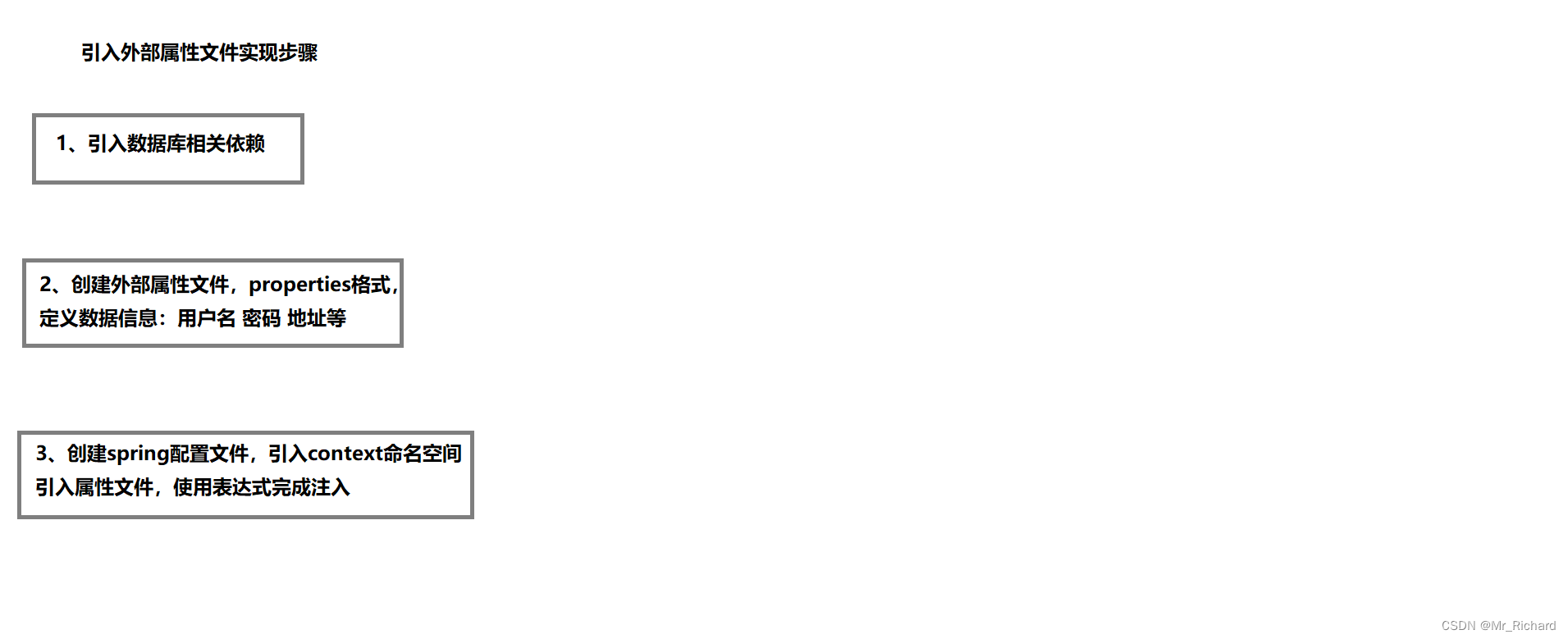
①加入依赖
<!-- MySQL驱动 -->
<dependency>
<groupId>mysql</groupId>
<artifactId>mysql-connector-java</artifactId>
<version>8.0.30</version>
</dependency>
<!-- 数据源 -->
<dependency>
<groupId>com.alibaba</groupId>
<artifactId>druid</artifactId>
<version>1.2.15</version>
</dependency>
②创建外部属性文件
在resources文件夹下创建 jdbc.properties 属性配置文件
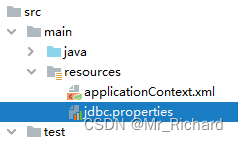
jdbc.user=root
jdbc.password=atguigu
jdbc.url=jdbc:mysql://localhost:3306/ssm?serverTimezone=UTC
jdbc.driver=com.mysql.cj.jdbc.Driver
③引入属性文件并配置bean
引入context 名称空间
<?xml version="1.0" encoding="UTF-8"?>
<beans xmlns="http://www.springframework.org/schema/beans"
xmlns:xsi="http://www.w3.org/2001/XMLSchema-instance"
xmlns:context="http://www.springframework.org/schema/context"
xsi:schemaLocation="http://www.springframework.org/schema/beans
http://www.springframework.org/schema/beans/spring-beans.xsd
http://www.springframework.org/schema/context
http://www.springframework.org/schema/context/spring-context.xsd">
</beans>
<!-- 引入外部属性文件 -->
<context:property-placeholder location="classpath:jdbc.properties"/>
注意:在使用 context:property-placeholder 元素加载外包配置文件功能前,首先需要在 XML 配置的一级标签 中添加 context 相关的约束
bean配置如下:
<?xml version="1.0" encoding="UTF-8"?>
<beans xmlns="http://www.springframework.org/schema/beans"
xmlns:xsi="http://www.w3.org/2001/XMLSchema-instance"
xmlns:context="http://www.springframework.org/schema/context"
xsi:schemaLocation="http://www.springframework.org/schema/beans
http://www.springframework.org/schema/beans/spring-beans.xsd
http://www.springframework.org/schema/context
http://www.springframework.org/schema/context/spring-context.xsd">
<!--引入外部属性文件-->
<context:property-placeholder location="classpath:jdbc.properties"/>
<!--完成数据库信息注入-->
<bean id="druidDataSource" class="com.alibaba.druid.pool.DruidDataSource">
<!--使用形如 ${ xxx}的方式实现注入-->
<property name="url" value="${jdbc.url}"/>
<property name="username" value="${jdbc.user}"/>
<property name="password" value="${jdbc.password}"/>
<property name="driverClassName" value="${jdbc.driver}"/>
</bean>
</beans>
④测试
@Test
public void testJDBC() throws SQLException {
ApplicationContext ac = new ClassPathXmlApplicationContext("bean-di-jdbc.xml");
DataSource dataSource = ac.getBean(DataSource.class);
Connection connection = dataSource.getConnection();
System.out.println(connection);
}
3.2.11 实验十:bean的作用域
①概念
在Spring中可以通过配置bean标签的scope属性来指定bean的作用域范围,各取值含义参加下表:
| 取值 | 含义 | 创建对象的时机 |
|---|---|---|
singleton(默认) | 在IOC容器中,这个bean的对象始终为单实例 | IOC容器初始化时 |
| prototype | 这个bean在IOC容器中有多个实例 | 获取bean时 |
如果是在WebApplicationContext环境下还会有另外几个作用域(但不常用):
| 取值 | 含义 |
|---|---|
| request | 在一个请求范围内有效 |
| session | 在一个会话范围内有效 |
②创建类User
package com.atguigu.spring6.bean;
public class User {
private Integer id;
private String username;
private String password;
private Integer age;
public User() {
}
public User(Integer id, String username, String password, Integer age) {
this.id = id;
this.username = username;
this.password = password;
this.age = age;
}
public Integer getId() {
return id;
}
public void setId(Integer id) {
this.id = id;
}
public String getUsername() {
return username;
}
public void setUsername(String username) {
this.username = username;
}
public String getPassword() {
return password;
}
public void setPassword(String password) {
this.password = password;
}
public Integer getAge() {
return age;
}
public void setAge(Integer age) {
this.age = age;
}
@Override
public String toString() {
return "User{" +
"id=" + id +
", username='" + username + '\'' +
", password='" + password + '\'' +
", age=" + age +
'}';
}
}
③配置bean
<!-- scope属性:取值singleton(默认值),bean在IOC容器中只有一个实例,IOC容器初始化时创建对象 -->
<!-- scope属性:取值prototype,bean在IOC容器中可以有多个实例,getBean()时创建对象 -->
<bean class="com.atguigu.spring6.bean.User" scope="prototype"></bean>
④测试
@Test
public void testBeanScope(){
ApplicationContext ac = new ClassPathXmlApplicationContext("spring-scope.xml");
User user1 = ac.getBean(User.class);
User user2 = ac.getBean(User.class);
System.out.println(user1==user2);
}
3.2.12 实验十一:bean生命周期
①具体的生命周期过程
-
bean对象创建(调用无参构造器)
-
给bean对象设置属性
-
bean的后置处理器(初始化之前)
-
bean对象初始化(需在配置bean时指定初始化方法)
-
bean的后置处理器(初始化之后)
-
bean对象就绪可以使用
-
bean对象销毁(需在配置bean时指定销毁方法)
-
IOC容器关闭
②修改类User
package com.atguigu.ioc.xml.lifecycle;
/**
* @author : Sakura
* @className : User
* @description : TODO
* @createTime : 2023-07-20 14:09:41
*/
public class User {
private String name;
public String getName() {
return name;
}
public void setName(String name) {
System.out.println("2. 给bean对象设置属性值");
this.name = name;
}
public User(){
System.out.println("1. 调用无参构造创建bean对象");
}
/**
* 初始化方法
*/
public void initMethod(){
System.out.println("4. bean对象初始化,调用指定的初始化方法");
}
/**
* 销毁方法
*/
public void destoryMethod(){
System.out.println("7. bean对象销毁,调用指定的销毁方法");
}
@Override
public String toString() {
return "User{" +
"name='" + name + '\'' +
'}';
}
}
注意其中的initMethod()和destroyMethod(),可以通过配置bean指定为初始化和销毁的方法
③配置bean
<!-- init-method:指明bean对象的初始化方法
destroy-method: 指明bean对象的销毁方法
-->
<bean id="user" class="com.atguigu.ioc.xml.lifecycle.User"
init-method="initMethod" destroy-method="destoryMethod">
<property name="name" value="Sakura" />
</bean>
④测试
@Test
public void testLife(){
ClassPathXmlApplicationContext context = new ClassPathXmlApplicationContext("bean-lifecycle.xml");
User user = context.getBean("user", User.class);
System.out.println("6. bean对象创建完成");
System.out.println(user);
// 调用ClassPathXmlApplicationContext 实例的close方法:销毁ioc容器
context.close();
}
⑤bean的后置处理器
bean的后置处理器会在生命周期的初始化前后添加额外的操作,需要实现BeanPostProcessor接口,且配置到IOC容器中,需要注意的是,bean后置处理器不是单独针对某一个bean生效,而是针对IOC容器中所有bean都会执行。
创建bean的后置处理器:
package com.atguigu.ioc.xml.lifecycle;
import org.springframework.beans.BeansException;
import org.springframework.beans.factory.config.BeanPostProcessor;
/**
* @author : Sakura
* @className : MyBeanPost
* @description :
* bean的后置处理器会在生命周期的初始化前后添加额外的操作,
* 需要`实现BeanPostProcessor接口`,且配置到IOC容器中,
* 需要注意的是,bean后置处理器不是单独针对某一个bean生效,
* 而是`针对IOC容器中所有bean`都会执行。
* @createTime : 2023-07-20 14:21:37
*/
public class MyBeanPost implements BeanPostProcessor {
@Override
public Object postProcessBeforeInitialization(Object bean, String beanName) throws BeansException {
System.out.println("3. bean后置处理器,bean对象初始化之前执行");
System.out.println(bean);
return bean;
}
@Override
public Object postProcessAfterInitialization(Object bean, String beanName) throws BeansException {
System.out.println("5. bean后置处理器,bean对象初始化之后执行");
System.out.println(bean);
return bean;
}
}
在IOC容器中配置后置处理器:
<!--
bean的后置处理器要放入IOC容器才能生效:
bean后置处理器不是单独针对某一个bean生效,而是`针对IOC容器中所有bean`都会执行。
-->
<bean id="myBeanPost" class="com.atguigu.ioc.xml.lifecycle.MyBeanPost"/>
3.2.13 实验十二:FactoryBean
①简介
FactoryBean是Spring提供的一种整合第三方框架的常用机制。和普通的bean不同,配置一个FactoryBean类型的bean,在获取bean的时候得到的并不是class属性中配置的这个类的对象,而是getObject()方法的返回值。通过这种机制,Spring可以帮我们把复杂组件创建的详细过程和繁琐细节都屏蔽起来,只把最简洁的使用界面展示给我们。
将来我们整合Mybatis时,Spring就是通过FactoryBean机制来帮我们创建SqlSessionFactory对象的。
/*
* Copyright 2002-2020 the original author or authors.
*
* Licensed under the Apache License, Version 2.0 (the "License");
* you may not use this file except in compliance with the License.
* You may obtain a copy of the License at
*
* https://www.apache.org/licenses/LICENSE-2.0
*
* Unless required by applicable law or agreed to in writing, software
* distributed under the License is distributed on an "AS IS" BASIS,
* WITHOUT WARRANTIES OR CONDITIONS OF ANY KIND, either express or implied.
* See the License for the specific language governing permissions and
* limitations under the License.
*/
package org.springframework.beans.factory;
import org.springframework.lang.Nullable;
/**
* Interface to be implemented by objects used within a {@link BeanFactory} which
* are themselves factories for individual objects. If a bean implements this
* interface, it is used as a factory for an object to expose, not directly as a
* bean instance that will be exposed itself.
*
* <p><b>NB: A bean that implements this interface cannot be used as a normal bean.</b>
* A FactoryBean is defined in a bean style, but the object exposed for bean
* references ({@link #getObject()}) is always the object that it creates.
*
* <p>FactoryBeans can support singletons and prototypes, and can either create
* objects lazily on demand or eagerly on startup. The {@link SmartFactoryBean}
* interface allows for exposing more fine-grained behavioral metadata.
*
* <p>This interface is heavily used within the framework itself, for example for
* the AOP {@link org.springframework.aop.framework.ProxyFactoryBean} or the
* {@link org.springframework.jndi.JndiObjectFactoryBean}. It can be used for
* custom components as well; however, this is only common for infrastructure code.
*
* <p><b>{@code FactoryBean} is a programmatic contract. Implementations are not
* supposed to rely on annotation-driven injection or other reflective facilities.</b>
* {@link #getObjectType()} {@link #getObject()} invocations may arrive early in the
* bootstrap process, even ahead of any post-processor setup. If you need access to
* other beans, implement {@link BeanFactoryAware} and obtain them programmatically.
*
* <p><b>The container is only responsible for managing the lifecycle of the FactoryBean
* instance, not the lifecycle of the objects created by the FactoryBean.</b> Therefore,
* a destroy method on an exposed bean object (such as {@link java.io.Closeable#close()}
* will <i>not</i> be called automatically. Instead, a FactoryBean should implement
* {@link DisposableBean} and delegate any such close call to the underlying object.
*
* <p>Finally, FactoryBean objects participate in the containing BeanFactory's
* synchronization of bean creation. There is usually no need for internal
* synchronization other than for purposes of lazy initialization within the
* FactoryBean itself (or the like).
*
* @author Rod Johnson
* @author Juergen Hoeller
* @since 08.03.2003
* @param <T> the bean type
* @see org.springframework.beans.factory.BeanFactory
* @see org.springframework.aop.framework.ProxyFactoryBean
* @see org.springframework.jndi.JndiObjectFactoryBean
*/
public interface FactoryBean<T> {
/**
* The name of an attribute that can be
* {@link org.springframework.core.AttributeAccessor#setAttribute set} on a
* {@link org.springframework.beans.factory.config.BeanDefinition} so that
* factory beans can signal their object type when it can't be deduced from
* the factory bean class.
* @since 5.2
*/
String OBJECT_TYPE_ATTRIBUTE = "factoryBeanObjectType";
/**
* Return an instance (possibly shared or independent) of the object
* managed by this factory.
* <p>As with a {@link BeanFactory}, this allows support for both the
* Singleton and Prototype design pattern.
* <p>If this FactoryBean is not fully initialized yet at the time of
* the call (for example because it is involved in a circular reference),
* throw a corresponding {@link FactoryBeanNotInitializedException}.
* <p>As of Spring 2.0, FactoryBeans are allowed to return {@code null}
* objects. The factory will consider this as normal value to be used; it
* will not throw a FactoryBeanNotInitializedException in this case anymore.
* FactoryBean implementations are encouraged to throw
* FactoryBeanNotInitializedException themselves now, as appropriate.
* @return an instance of the bean (can be {@code null})
* @throws Exception in case of creation errors
* @see FactoryBeanNotInitializedException
*/
@Nullable
T getObject() throws Exception;
/**
* Return the type of object that this FactoryBean creates,
* or {@code null} if not known in advance.
* <p>This allows one to check for specific types of beans without
* instantiating objects, for example on autowiring.
* <p>In the case of implementations that are creating a singleton object,
* this method should try to avoid singleton creation as far as possible;
* it should rather estimate the type in advance.
* For prototypes, returning a meaningful type here is advisable too.
* <p>This method can be called <i>before</i> this FactoryBean has
* been fully initialized. It must not rely on state created during
* initialization; of course, it can still use such state if available.
* <p><b>NOTE:</b> Autowiring will simply ignore FactoryBeans that return
* {@code null} here. Therefore it is highly recommended to implement
* this method properly, using the current state of the FactoryBean.
* @return the type of object that this FactoryBean creates,
* or {@code null} if not known at the time of the call
* @see ListableBeanFactory#getBeansOfType
*/
@Nullable
Class<?> getObjectType();
/**
* Is the object managed by this factory a singleton? That is,
* will {@link #getObject()} always return the same object
* (a reference that can be cached)?
* <p><b>NOTE:</b> If a FactoryBean indicates to hold a singleton object,
* the object returned from {@code getObject()} might get cached
* by the owning BeanFactory. Hence, do not return {@code true}
* unless the FactoryBean always exposes the same reference.
* <p>The singleton status of the FactoryBean itself will generally
* be provided by the owning BeanFactory; usually, it has to be
* defined as singleton there.
* <p><b>NOTE:</b> This method returning {@code false} does not
* necessarily indicate that returned objects are independent instances.
* An implementation of the extended {@link SmartFactoryBean} interface
* may explicitly indicate independent instances through its
* {@link SmartFactoryBean#isPrototype()} method. Plain {@link FactoryBean}
* implementations which do not implement this extended interface are
* simply assumed to always return independent instances if the
* {@code isSingleton()} implementation returns {@code false}.
* <p>The default implementation returns {@code true}, since a
* {@code FactoryBean} typically manages a singleton instance.
* @return whether the exposed object is a singleton
* @see #getObject()
* @see SmartFactoryBean#isPrototype()
*/
default boolean isSingleton() {
return true;
}
}
②创建类UserFactoryBean
package com.atguigu.spring6.bean;
public class UserFactoryBean implements FactoryBean<User> {
@Override
public User getObject() throws Exception {
return new User();
}
@Override
public Class<?> getObjectType() {
return User.class;
}
}
③配置bean
<bean id="user" class="com.atguigu.spring6.bean.UserFactoryBean"></bean>
④测试
@Test
public void testUserFactoryBean(){
//获取IOC容器
ApplicationContext ac = new ClassPathXmlApplicationContext("spring-factorybean.xml");
User user = (User) ac.getBean("user");
System.out.println(user);
}
3.2.14 实验十三:基于xml自动装配
自动装配:
根据指定的策略,在IOC容器中匹配某一个bean,自动为指定的bean中所依赖的类类型或接口类型属性赋值
①场景模拟
创建类UserController
package com.atguigu.ioc.xml.auto.controller;
import com.atguigu.ioc.xml.auto.service.UserService;
/**
* @author : Sakura
* @className : UserController
* @description : TODO
* @createTime : 2023-07-20 14:46:03
*/
public class UserController {
private UserService userService;
// 需要set方法进行注入
public void setUserService(UserService userService) {
this.userService = userService;
}
public void addUser(){
System.out.println("UserController中的方法执行了");
userService.addUserService();
}
}
创建接口UserService
/**
* @author : Sakura
* @className : UserService
* @description : TODO
* @createTime : 2023-07-20 14:47:14
*/
public interface UserService {
void addUserService();
}
创建类UserServiceImpl实现接口UserService
package com.atguigu.ioc.xml.auto.service;
import com.atguigu.ioc.xml.auto.dao.UserDao;
/**
* @author : Sakura
* @className : UserServiceImpl
* @description : TODO
* @createTime : 2023-07-20 14:47:51
*/
public class UserServiceImpl implements UserService{
private UserDao userDao;
public void setUserDao(UserDao userDao) {
this.userDao = userDao;
}
@Override
public void addUserService() {
System.out.println("UserService方法执行了");
userDao.addUserDao();
}
}
创建接口UserDao
package com.atguigu.ioc.xml.auto.dao;
/**
* @author : Sakura
* @className : UserDao
* @description : TODO
* @createTime : 2023-07-20 14:47:40
*/
public interface UserDao {
void addUserDao();
}
创建类UserDaoImpl实现接口UserDao
package com.atguigu.ioc.xml.auto.dao;
import com.atguigu.ioc.xml.auto.service.UserService;
/**
* @author : Sakura
* @className : UserDaoImpl
* @description : TODO
* @createTime : 2023-07-20 14:48:22
*/
public class UserDaoImpl implements UserDao {
@Override
public void addUserDao() {
System.out.println("UserDao方法执行了");
}
}
②配置bean
使用bean标签的autowire属性设置自动装配,
自动装配方式:byType
byType:根据类型匹配IOC容器中的某个兼容类型的bean,为属性自动赋值
若在IOC中,没有任何一个兼容类型的bean能够为属性赋值,则该属性不装配,即值为默认值null
若在IOC中,有多个兼容类型的bean能够为属性赋值,则抛出异常NoUniqueBeanDefinitionException(详见3.2.2)
<bean id="userController" class="com.atguigu.ioc.xml.auto.controller.UserController"
autowire="byType">
<!-- 引用外部bean-->
<!-- <property name="userService" ref="userService"/>-->
</bean>
<!--
byType:根据类型匹配IOC容器中的某个兼容类型的bean,为属性自动赋值
对于userService接口类型的bean,class要写其实现类的全类名UserServiceImpl
-->
<bean id="userService" class="com.atguigu.ioc.xml.auto.service.UserServiceImpl"
autowire="byType">
</bean>
<bean id="userDao" class="com.atguigu.ioc.xml.auto.dao.UserDaoImpl" >
</bean>
自动装配方式:byName
byName:将自动装配的属性的属性名,作为bean的id(类名首字母小写)在IOC容器中匹配相对应的bean进行赋值
<bean id="userController" class="com.atguigu.spring6.autowire.controller.UserController" autowire="byName"></bean>
<bean id="userService" class="com.atguigu.spring6.autowire.service.impl.UserServiceImpl" autowire="byName"></bean>
<bean id="userServiceImpl" class="com.atguigu.spring6.autowire.service.impl.UserServiceImpl" autowire="byName"></bean>
<bean id="userDao" class="com.atguigu.spring6.autowire.dao.impl.UserDaoImpl"></bean>
<bean id="userDaoImpl" class="com.atguigu.spring6.autowire.dao.impl.UserDaoImpl"></bean>
③测试
@Test
public void test(){
ApplicationContext context = new ClassPathXmlApplicationContext("bean-auto.xml");
UserController userController = context.getBean("userController", UserController.class);
userController.addUser();
}
3.3 基于注解管理Bean(☆)
从 Java 5 开始,Java 增加了对注解(Annotation)的支持,它是代码中的一种特殊标记,可以在编译、类加载和运行时被读取,执行相应的处理。开发人员可以通过注解在不改变原有代码和逻辑的情况下,在源代码中嵌入补充信息。
Spring 从 2.5 版本开始提供了对注解技术的全面支持,我们可以使用注解来实现自动装配,简化 Spring 的 XML 配置。
Spring 通过注解实现自动装配的步骤如下:
- 引入依赖
- 开启组件扫描
- 使用注解定义 Bean
- 依赖注入
3.3.1 搭建子模块spring6-ioc-annotation
①搭建模块
搭建方式如:spring6-ioc-xml
②引入配置文件
引入spring-ioc-xml模块日志log4j2.xml
③添加依赖
<dependencies>
<!--spring context依赖-->
<!--当你引入Spring Context依赖之后,表示将Spring的基础依赖引入了-->
<dependency>
<groupId>org.springframework</groupId>
<artifactId>spring-context</artifactId>
<version>6.0.11</version>
</dependency>
<!--junit5测试-->
<dependency>
<groupId>org.junit.jupiter</groupId>
<artifactId>junit-jupiter-api</artifactId>
<version>5.9.2</version>
</dependency>
<!--log4j2的依赖-->
<dependency>
<groupId>org.apache.logging.log4j</groupId>
<artifactId>log4j-core</artifactId>
<version>2.19.0</version>
</dependency>
<dependency>
<groupId>org.apache.logging.log4j</groupId>
<artifactId>log4j-slf4j2-impl</artifactId>
<version>2.19.0</version>
</dependency>
</dependencies>
3.3.2 开启组件扫描
Spring 默认不使用注解装配 Bean,因此我们需要在 Spring 的 XML 配置中,通过 <context:component-scan> 元素开启 Spring Beans的自动扫描功能。开启此功能后,Spring 会自动从扫描指定的包(base-package 属性设置)及其子包下的所有类,如果类上使用了 @Component 注解,就将该类装配到容器中。
<?xml version="1.0" encoding="UTF-8"?>
<beans xmlns="http://www.springframework.org/schema/beans"
xmlns:xsi="http://www.w3.org/2001/XMLSchema-instance"
xmlns:context="http://www.springframework.org/schema/context"
xsi:schemaLocation="http://www.springframework.org/schema/beans
http://www.springframework.org/schema/beans/spring-beans-3.0.xsd
http://www.springframework.org/schema/context
http://www.springframework.org/schema/context/spring-context.xsd">
<!--开启组件扫描功能-->
<context:component-scan base-package="com.atguigu.spring6"></context:component-scan>
</beans>
注意:在使用 context:component-scan 元素开启自动扫描功能前,首先需要在 XML 配置的一级标签 中添加 context 相关的约束。
情况一:最基本的扫描方式
<context:component-scan base-package="com.atguigu.spring6">
</context:component-scan>
情况二:指定要排除的组件
<context:component-scan base-package="com.atguigu.spring6">
<!-- context:exclude-filter标签:指定排除规则 -->
<!--
type:设置排除或包含的依据
type="annotation",根据注解排除,expression中设置要排除的注解的全类名
type="assignable",根据类型排除,expression中设置要排除的类型的全类名
-->
<context:exclude-filter type="annotation" expression="org.springframework.stereotype.Controller"/>
<!--<context:exclude-filter type="assignable" expression="com.atguigu.spring6.controller.UserController"/>-->
</context:component-scan>
情况三:仅扫描指定组件
<context:component-scan base-package="com.atguigu" use-default-filters="false">
<!-- context:include-filter标签:指定在原有扫描规则的基础上追加的规则 -->
<!-- use-default-filters属性:取值false表示关闭默认扫描规则 -->
<!-- 此时必须设置use-default-filters="false",因为默认规则即扫描指定包下所有类 -->
<!--
type:设置排除或包含的依据
type="annotation",根据注解排除,expression中设置要排除的注解的全类名
type="assignable",根据类型排除,expression中设置要排除的类型的全类名
-->
<context:include-filter type="annotation" expression="org.springframework.stereotype.Controller"/>
<!--<context:include-filter type="assignable" expression="com.atguigu.spring6.controller.UserController"/>-->
</context:component-scan>
3.3.3 使用注解定义 Bean
Spring 提供了以下多个注解,这些注解可以直接标注在 Java 类上,将它们定义成 Spring Bean。
| 注解 | 说明 |
|---|---|
| @Component | 该注解用于描述 Spring 中的 Bean,它是一个泛化的概念,仅仅表示容器中的一个组件(Bean),并且可以作用在应用的任何层次,例如 Service 层、Dao 层等。 使用时只需将该注解标注在相应类上即可。 |
| @Repository | 该注解用于将数据访问层(Dao 层)的类标识为 Spring 中的 Bean,其功能与 @Component 相同。 |
| @Service | 该注解通常作用在业务层(Service 层),用于将业务层的类标识为 Spring 中的 Bean,其功能与 @Component 相同。 |
| @Controller | 该注解通常作用在控制层(如SpringMVC 的 Controller),用于将控制层的类标识为 Spring 中的 Bean,其功能与 @Component 相同。 |
package com.atguigu.spring6.bean;
import org.springframework.stereotype.Component;
/**
* @author : Sakura
* @className : User
* @description : TODO
* @createTime : 2023-07-20 15:27:51
*/
// value默认值为类名首字母小写,效果等于 <bean id ="user" />
@Component(value = "user")
public class User {
}
3.3.4 实验一:@Autowired注入
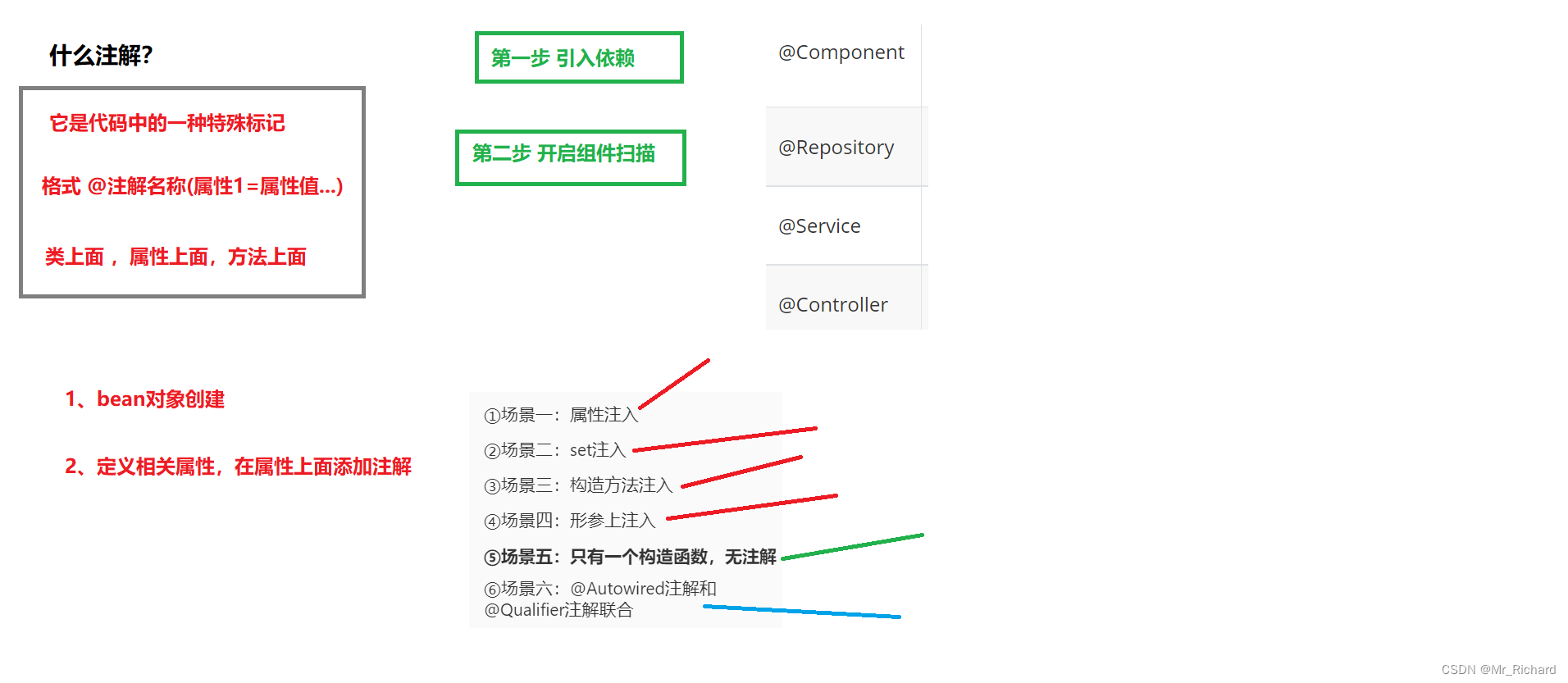
单独使用@Autowired注解,默认根据类型装配。【默认是byType】
查看源码:
package org.springframework.beans.factory.annotation;
import java.lang.annotation.Documented;
import java.lang.annotation.ElementType;
import java.lang.annotation.Retention;
import java.lang.annotation.RetentionPolicy;
import java.lang.annotation.Target;
@Target({ElementType.CONSTRUCTOR, ElementType.METHOD, ElementType.PARAMETER, ElementType.FIELD, ElementType.ANNOTATION_TYPE})
@Retention(RetentionPolicy.RUNTIME)
@Documented
public @interface Autowired {
boolean required() default true;
}
源码中有两处需要注意:
-
第一处:该注解可以标注在哪里?
-
- 构造方法上
- 方法上
- 形参上
- 属性上
- 注解上
-
第二处:该注解有一个required属性,默认值是true,表示在注入的时候要求被注入的Bean必须是存在的,如果不存在则报错。如果required属性设置为false,表示注入的Bean存在或者不存在都没关系,存在的话就注入,不存在的话,也不报错。
①场景一:属性注入
创建UserDao接口
package com.atguigu.spring6.autowired.dao;
/**
* @author : Sakura
* @className : UserDao
* @description : TODO
* @createTime : 2023-07-20 15:37:37
*/
public interface UserDao {
void add();
}
创建UserDaoImpl实现
package com.atguigu.spring6.autowired.dao;
import org.springframework.stereotype.Repository;
/**
* @author : Sakura
* @className : UserDaoImpl
* @description : TODO
* @createTime : 2023-07-20 15:38:26
*/
@Repository
public class UserDaoImpl implements UserDao{
@Override
public void add() {
System.out.println("dao.....");
}
}
创建UserService接口
package com.atguigu.spring6.autowired.service;
/**
* @author : Sakura
* @className : UserService
* @description : TODO
* @createTime : 2023-07-20 15:37:01
*/
public interface UserService {
void add();
}
创建UserServiceImpl实现类
package com.atguigu.spring6.autowired.service;
import com.atguigu.spring6.autowired.dao.UserDao;
import org.springframework.beans.factory.annotation.Autowired;
import org.springframework.stereotype.Service;
/**
* @author : Sakura
* @className : UserServiceImpl
* @description : TODO
* @createTime : 2023-07-20 15:38:44
*/
@Service
public class UserServiceImpl implements UserService{
// 注入dao
@Autowired
private UserDao userDao;
@Override
public void add() {
System.out.println("service");
userDao.add();
}
}
创建UserController类
package com.atguigu.spring6.autowired.controller;
import com.atguigu.spring6.autowired.service.UserService;
import org.springframework.beans.factory.annotation.Autowired;
import org.springframework.stereotype.Controller;
/**
* @author : Sakura
* @className : UserController
* @description : TODO
* @createTime : 2023-07-20 15:36:27
*/
@Controller
public class UserController {
// 注入service: 第一种方式 属性注入
@Autowired
private UserService userService;
public void add(){
System.out.println("controller...");
userService.add();
}
}
测试一
@Test
public void test(){
ApplicationContext context = new ClassPathXmlApplicationContext("bean.xml");
UserController userController = context.getBean(UserController.class);
System.out.println(userController);
userController.add();
}
测试结果:

以上构造方法和setter方法都没有提供,经过测试,仍然可以注入成功。
②场景二:set注入
修改UserServiceImpl类
package com.atguigu.spring6.autowired.service;
import com.atguigu.spring6.autowired.dao.UserDao;
import org.springframework.beans.factory.annotation.Autowired;
import org.springframework.stereotype.Service;
/**
* @author : Sakura
* @className : UserServiceImpl
* @description : TODO
* @createTime : 2023-07-20 15:38:44
*/
@Service
public class UserServiceImpl implements UserService{
// 注入dao
private UserDao userDao;
// 第二种方式:set方法注入
@Autowired
public void setUserDao(UserDao userDao) {
this.userDao = userDao;
}
@Override
public void add() {
System.out.println("service");
userDao.add();
}
}
修改UserController类
package com.atguigu.spring6.autowired.controller;
import com.atguigu.spring6.autowired.service.UserService;
import org.springframework.beans.factory.annotation.Autowired;
import org.springframework.stereotype.Controller;
/**
* @author : Sakura
* @className : UserController
* @description : TODO
* @createTime : 2023-07-20 15:36:27
*/
@Controller
public class UserController {
// 注入service
// @Autowired: 第一种方式 属性注入
// @Autowired
// private UserService userService;
private UserService userService;
// 第二种方式:set方法注入
@Autowired
public void setUserService(UserService userService) {
this.userService = userService;
}
public void add(){
System.out.println("controller...");
userService.add();
}
}
测试:成功调用
③场景三:构造方法注入
修改UserServiceImpl类
package com.atguigu.spring6.autowired.service;
import com.atguigu.spring6.autowired.dao.UserDao;
import org.springframework.beans.factory.annotation.Autowired;
import org.springframework.stereotype.Service;
/**
* @author : Sakura
* @className : UserServiceImpl
* @description : TODO
* @createTime : 2023-07-20 15:38:44
*/
@Service
public class UserServiceImpl implements UserService{
private UserDao userDao;
// 第三种方式: 构造器注入
@Autowired
public UserServiceImpl(UserDao userDao){
this.userDao = userDao;
}
@Override
public void add() {
System.out.println("service");
userDao.add();
}
}
修改UserController类
package com.atguigu.spring6.controller;
import com.atguigu.spring6.service.UserService;
import org.springframework.beans.factory.annotation.Autowired;
import org.springframework.stereotype.Controller;
@Controller
public class UserController {
private UserService userService;
// 第三种方式: 构造器注入
@Autowired
public UserController(UserService userService){
this.userService = userService;
}
public void add(){
System.out.println("controller...");
userService.add();
}
}
测试:成功调用
④场景四:构造器形参注入
修改UserServiceImpl类
package com.atguigu.spring6.service.impl;
import com.atguigu.spring6.dao.UserDao;
import com.atguigu.spring6.service.UserService;
import org.springframework.beans.factory.annotation.Autowired;
import org.springframework.stereotype.Service;
@Service
public class UserServiceImpl implements UserService {
private UserDao userDao;
// 第四种方式: 形参注入
public UserServiceImpl(@Autowired UserDao userDao){
this.userDao = userDao;
}
@Override
public void add() {
System.out.println("service");
userDao.add();
}
}
修改UserController类
package com.atguigu.spring6.controller;
import com.atguigu.spring6.service.UserService;
import org.springframework.beans.factory.annotation.Autowired;
import org.springframework.stereotype.Controller;
@Controller
public class UserController {
private UserService userService;
// 第四种方式:形参上注入
public UserController(@Autowired UserService userService) {
this.userService = userService;
}
public void add() {
System.out.println("controller...");
userService.add();
}
}
测试:成功调用
⑤场景五:只有一个构造函数,无注解
修改UserController类
package com.atguigu.spring6.autowired.controller;
import com.atguigu.spring6.autowired.service.UserService;
import org.springframework.beans.factory.annotation.Autowired;
import org.springframework.stereotype.Controller;
/**
* @author : Sakura
* @className : UserController
* @description : TODO
* @createTime : 2023-07-20 15:36:27
*/
@Controller
public class UserController {
private UserService userService;
// 第五种方式: 只有一个有参构造函数 可以无注解
public UserController( UserService userService) {
this.userService = userService;
}
public void add() {
System.out.println("controller...");
userService.add();
}
}
修改UserServiceImpl类
package com.atguigu.spring6.autowired.service;
import com.atguigu.spring6.autowired.dao.UserDao;
import org.springframework.beans.factory.annotation.Autowired;
import org.springframework.stereotype.Service;
/**
* @author : Sakura
* @className : UserServiceImpl
* @description : TODO
* @createTime : 2023-07-20 15:38:44
*/
@Service
public class UserServiceImpl implements UserService{
private UserDao userDao;
// 第五种方式: 只有一个有参构造函数 可以无注解
public UserServiceImpl( UserDao userDao){
this.userDao = userDao;
}
@Override
public void add() {
System.out.println("service");
userDao.add();
}
}
测试通过
当有参数的构造方法只有一个时,@Autowired注解可以省略。
说明:有多个构造方法时呢?大家可以测试(再添加一个无参构造函数),测试报错
⑥场景六:@Autowired注解和@Qualifier注解联合
添加dao层实现
package com.atguigu.spring6.autowired.dao;
import org.springframework.stereotype.Repository;
/**
* @author : Sakura
* @className : UserDaoImpl2
* @description : TODO
* @createTime : 2023-07-20 16:18:09
*/
@Repository
public class UserDaoImpl2 implements UserDao{
@Override
public void add() {
System.out.println("dao2...");
}
}
测试:测试异常
错误信息中说:不能装配,根据类型进行注入时,UserDao这个Bean的数量等于2
怎么解决这个问题呢?当然要byName,根据名称进行装配了。
修改UserServiceImpl类
package com.atguigu.spring6.autowired.service;
import com.atguigu.spring6.autowired.dao.UserDao;
import org.springframework.beans.factory.annotation.Autowired;
import org.springframework.beans.factory.annotation.Qualifier;
import org.springframework.stereotype.Service;
/**
* @author : Sakura
* @className : UserServiceImpl
* @description : TODO
* @createTime : 2023-07-20 15:38:44
*/
@Service
public class UserServiceImpl implements UserService{
// 第六种方式: @Autowired + @Qualifier:实现根据名称进行注入
// 根据名称进行注入,指定bean的名称,默认为类名首字母小写
@Autowired
@Qualifier("userDaoImpl")
private UserDao userDao;
@Override
public void add() {
System.out.println("service");
userDao.add();
}
}
注意:
- 这种方式不能带有含参构造方法(推测是为了与5进行区分);
- @Autowired注解默认根据类型装配byType,如果想根据名称装配,需要配合@Qualifier注解一起用。
总结
- @Autowired注解可以出现在:属性上、构造方法上、构造方法的参数上、setter方法上。
- 当带参数的构造方法只有一个,@Autowired注解可以省略。()
- @Autowired注解默认根据类型注入。如果要根据名称注入的话,需要配合@Qualifier注解一起使用。
3.3.5 实验二:@Resource注入
@Resource注解也可以完成属性注入。那它和@Autowired注解有什么区别?
- @Resource注解是JDK扩展包中的,也就是说属于JDK的一部分。所以该注解是标准注解,更加具有通用性。(JSR-250标准中制定的注解类型。JSR是Java规范提案。)
- @Autowired注解是Spring框架自己的。
@Resource注解默认根据名称装配byName,未指定name时,使用属性名作为name。通过name找不到的话会自动启动通过类型byType装配。- @Autowired注解默认根据类型装配byType,如果想根据名称装配,需要配合@Qualifier注解一起用。
- @Resource注解用在属性上、setter方法上。
- @Autowired注解用在属性上、setter方法上、构造方法上、构造方法参数上。
@Resource注解属于JDK扩展包,所以不在JDK当中,需要额外引入以下依赖:【如果是JDK8的话不需要额外引入依赖。高于JDK11或低于JDK8需要引入以下依赖。】
<dependency>
<groupId>jakarta.annotation</groupId>
<artifactId>jakarta.annotation-api</artifactId>
<version>2.1.1</version>
</dependency>
源码:
package jakarta.annotation;
import java.lang.annotation.ElementType;
import java.lang.annotation.Repeatable;
import java.lang.annotation.Retention;
import java.lang.annotation.RetentionPolicy;
import java.lang.annotation.Target;
@Target({ElementType.TYPE, ElementType.FIELD, ElementType.METHOD})
@Retention(RetentionPolicy.RUNTIME)
@Repeatable(Resources.class)
public @interface Resource {
String name() default "";
String lookup() default "";
Class<?> type() default Object.class;
Resource.AuthenticationType authenticationType() default Resource.AuthenticationType.CONTAINER;
boolean shareable() default true;
String mappedName() default "";
String description() default "";
public static enum AuthenticationType {
CONTAINER,
APPLICATION;
private AuthenticationType() {
}
}
}
①场景一:根据name注入
修改UserDaoImpl类
package com.atguigu.spring6.dao.impl;
import com.atguigu.spring6.dao.UserDao;
import org.springframework.stereotype.Repository;
@Repository("myUserDao")
public class UserDaoImpl implements UserDao {
@Override
public void print() {
System.out.println("Dao层执行结束");
}
}
修改UserServiceImpl类
package com.atguigu.spring6.service.impl;
import com.atguigu.spring6.dao.UserDao;
import com.atguigu.spring6.service.UserService;
import jakarta.annotation.Resource;
import org.springframework.beans.factory.annotation.Autowired;
import org.springframework.beans.factory.annotation.Qualifier;
import org.springframework.stereotype.Service;
@Service
public class UserServiceImpl implements UserService {
@Resource(name = "myUserDao")
private UserDao myUserDao;
@Override
public void out() {
myUserDao.print();
System.out.println("Service层执行结束");
}
}
测试通过
②场景二:name未知注入
修改UserDaoImpl类
package com.atguigu.spring6.dao.impl;
import com.atguigu.spring6.dao.UserDao;
import org.springframework.stereotype.Repository;
@Repository("myUserDao")
public class UserDaoImpl implements UserDao {
@Override
public void print() {
System.out.println("Dao层执行结束");
}
}
修改UserServiceImpl类
package com.atguigu.spring6.service.impl;
import com.atguigu.spring6.dao.UserDao;
import com.atguigu.spring6.service.UserService;
import jakarta.annotation.Resource;
import org.springframework.beans.factory.annotation.Autowired;
import org.springframework.beans.factory.annotation.Qualifier;
import org.springframework.stereotype.Service;
@Service
public class UserServiceImpl implements UserService {
@Resource
private UserDao myUserDao;
@Override
public void out() {
myUserDao.print();
System.out.println("Service层执行结束");
}
}
测试通过
当@Resource注解使用时没有指定name的时候,还是根据name进行查找,这个name是属性名。
③场景三 其他情况
修改UserServiceImpl类,userDao1属性名不存在
package com.atguigu.spring6.service.impl;
import com.atguigu.spring6.dao.UserDao;
import com.atguigu.spring6.service.UserService;
import jakarta.annotation.Resource;
import org.springframework.beans.factory.annotation.Autowired;
import org.springframework.beans.factory.annotation.Qualifier;
import org.springframework.stereotype.Service;
@Service
public class UserServiceImpl implements UserService {
@Resource
private UserDao userDao1;
@Override
public void out() {
userDao1.print();
System.out.println("Service层执行结束");
}
}
测试异常
根据异常信息得知:显然当通过name找不到的时候,自然会启动byType进行注入,以上的错误是因为UserDao接口下有两个实现类导致的。所以根据类型注入就会报错。
@Resource的set注入可以自行测试
总结:
@Resource注解:默认byName注入,没有指定name时把属性名当做name,根据name找不到时,才会byType注入。byType注入时,某种类型的Bean只能有一个
3.3.6 Spring全注解开发
全注解开发就是不再使用spring配置文件了,写一个配置类来代替配置文件。
package com.atguigu.spring6.config;
import org.springframework.context.annotation.ComponentScan;
import org.springframework.context.annotation.Configuration;
/**
* @author : Sakura
* @className : SpringConfig
* @description : TODO
* @createTime : 2023-07-20 16:58:29
*/
@Configuration //声明这是一个Spring配置类
@ComponentScan("com.atguigu.spring6") //声明组件扫描的包路径
public class SpringConfig {
}
测试类
public static void main(String[] args) {
//加载配置类
ApplicationContext applicationContext = new AnnotationConfigApplicationContext(SpringConfig.class);
UserController bean = applicationContext.getBean(UserController.class);
bean.add();
}
4、原理-手写IoC
我们都知道,Spring框架的IOC是基于Java反射机制实现的,下面我们先回顾一下java反射。
4.1 回顾Java反射
Java反射机制是在运行状态中,对于任意一个类,都能够知道这个类的所有属性和方法;对于任意一个对象,都能够调用它的任意方法和属性;这种动态获取信息以及动态调用对象方法的功能称为Java语言的反射机制。简单来说,反射机制指的是程序在运行时能够获取自身的信息。
要想解剖一个类,必须先要获取到该类的Class对象。而剖析一个类或用反射解决具体的问题就是使用相关API**(1)java.lang.Class(2)java.lang.reflect**,所以,Class对象是反射的根源。
自定义类
package com.atguigu.reflect;
public class Car {
//属性
private String name;
private int age;
private String color;
//无参数构造
public Car() {
}
//有参数构造
public Car(String name, int age, String color) {
this.name = name;
this.age = age;
this.color = color;
}
//普通方法
private void run() {
System.out.println("私有方法-run.....");
}
//get和set方法
public String getName() {
return name;
}
public void setName(String name) {
this.name = name;
}
public int getAge() {
return age;
}
public void setAge(int age) {
this.age = age;
}
public String getColor() {
return color;
}
public void setColor(String color) {
this.color = color;
}
@Override
public String toString() {
return "Car{" +
"name='" + name + '\'' +
", age=" + age +
", color='" + color + '\'' +
'}';
}
}
编写测试类
package com.atguigu.reflect;
import org.junit.jupiter.api.Test;
import java.lang.reflect.Constructor;
import java.lang.reflect.Field;
import java.lang.reflect.Method;
public class TestCar {
//1、获取Class对象多种方式
@Test
public void test01() throws Exception {
//1 类名.class
Class clazz1 = Car.class;
//2 对象.getClass()
Class clazz2 = new Car().getClass();
//3 Class.forName("全路径")
Class clazz3 = Class.forName("com.atguigu.reflect.Car");
//实例化
Car car = (Car)clazz3.getConstructor().newInstance();
System.out.println(car);
}
//2、获取构造方法
@Test
public void test02() throws Exception {
Class clazz = Car.class;
//获取所有构造
// getConstructors()获取所有public的构造方法
// Constructor[] constructors = clazz.getConstructors();
// getDeclaredConstructors()获取所有的构造方法public private
Constructor[] constructors = clazz.getDeclaredConstructors();
for (Constructor c:constructors) {
System.out.println("方法名称:"+c.getName()+" 参数个数:"+c.getParameterCount());
}
//指定有参数构造创建对象
//1 构造public
// Constructor c1 = clazz.getConstructor(String.class, int.class, String.class);
// Car car1 = (Car)c1.newInstance("夏利", 10, "红色");
// System.out.println(car1);
//2 构造private
Constructor c2 = clazz.getDeclaredConstructor(String.class, int.class, String.class);
c2.setAccessible(true);
Car car2 = (Car)c2.newInstance("捷达", 15, "白色");
System.out.println(car2);
}
//3、获取属性
@Test
public void test03() throws Exception {
Class clazz = Car.class;
Car car = (Car)clazz.getDeclaredConstructor().newInstance();
//获取所有public属性
//Field[] fields = clazz.getFields();
//获取所有属性(包含私有属性)
Field[] fields = clazz.getDeclaredFields();
for (Field field:fields) {
if(field.getName().equals("name")) {
//设置允许访问
field.setAccessible(true);
field.set(car,"五菱宏光");
System.out.println(car);
}
System.out.println(field.getName());
}
}
//4、获取方法
@Test
public void test04() throws Exception {
Car car = new Car("奔驰",10,"黑色");
Class clazz = car.getClass();
//1 public方法
Method[] methods = clazz.getMethods();
for (Method m1:methods) {
//System.out.println(m1.getName());
//执行方法 toString
if(m1.getName().equals("toString")) {
String invoke = (String)m1.invoke(car);
//System.out.println("toString执行了:"+invoke);
}
}
//2 private方法
Method[] methodsAll = clazz.getDeclaredMethods();
for (Method m:methodsAll) {
//执行方法 run
if(m.getName().equals("run")) {
m.setAccessible(true);
m.invoke(car);
}
}
}
}
4.2 实现Spring的IoC
我们知道,IoC(控制反转)和DI(依赖注入)是Spring里面核心的东西,那么,我们如何自己手写出这样的代码呢?下面我们就一步一步写出Spring框架最核心的部分。
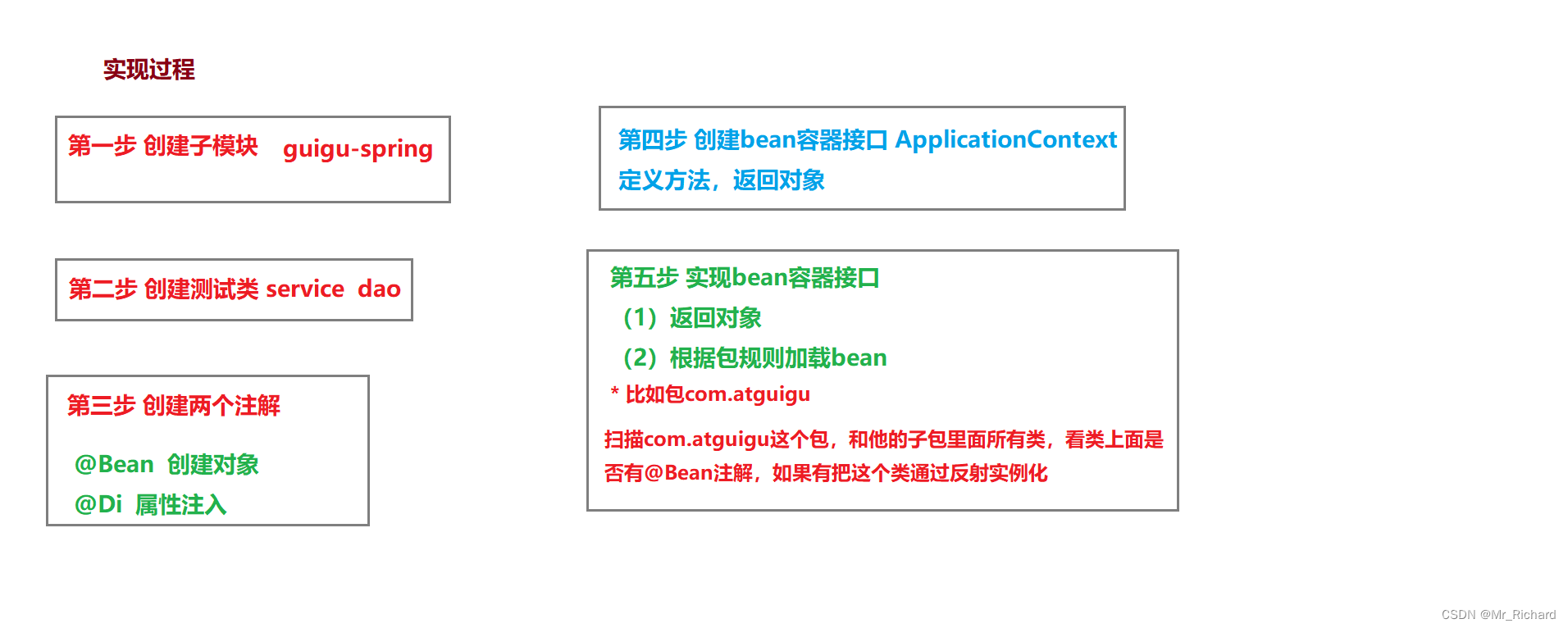
①搭建子模块
搭建模块:guigu-spring,搭建方式如其他spring子模块
②准备测试需要的bean
添加依赖
<dependencies>
<!--junit5测试-->
<dependency>
<groupId>org.junit.jupiter</groupId>
<artifactId>junit-jupiter-api</artifactId>
<version>5.3.1</version>
</dependency>
</dependencies>
创建UserDao接口
package com.atguigu.dao;
/**
* @author : Sakura
* @className : UserDao
* @description : TODO
* @createTime : 2023-07-20 19:33:10
*/
public interface UserDao {
void add();
}
创建UserDaoImpl实现
package com.atguigu.dao.impl;
import com.atguigu.dao.UserDao;
import com.atguigu.dao.annotation.Bean;
/**
* @author : Sakura
* @className : UserDaoImpl
* @description : TODO
* @createTime : 2023-07-20 19:33:21
*/
@Bean
public class UserDaoImpl implements UserDao {
@Override
public void add() {
System.out.println("dao...");
}
}
创建UserService接口
package com.atguigu.service;
/**
* @author : Sakura
* @className : UserService
* @description : TODO
* @createTime : 2023-07-20 19:32:06
*/
public interface UserService {
void add();
}
创建UserServiceImpl实现类
package com.atguigu.service.impl;
import com.atguigu.dao.UserDao;
import com.atguigu.dao.annotation.Bean;
import com.atguigu.dao.annotation.DI;
import com.atguigu.service.UserService;
/**
* @author : Sakura
* @className : UserServiceImpl
* @description : TODO
* @createTime : 2023-07-20 19:32:19
*/
@Bean
public class UserServiceImpl implements UserService {
@DI
private UserDao userDao;
@Override
public void add() {
System.out.println("service...");
userDao.add();
}
}
③定义注解
我们通过注解的形式加载bean与实现依赖注入
bean注解
package com.atguigu.dao.annotation;
import java.lang.annotation.ElementType;
import java.lang.annotation.Retention;
import java.lang.annotation.RetentionPolicy;
import java.lang.annotation.Target;
import static java.lang.annotation.ElementType.*;
/**
* @author : Sakura
* @className : Bean
* @description : TODO
* @createTime : 2023-07-20 19:34:34
*/
@Target(TYPE)
@Retention(RetentionPolicy.RUNTIME)
public @interface Bean {
}
依赖注入注解
package com.atguigu.dao.annotation;
import java.lang.annotation.ElementType;
import java.lang.annotation.Retention;
import java.lang.annotation.RetentionPolicy;
import java.lang.annotation.Target;
import static java.lang.annotation.ElementType.TYPE;
/**
* @author : Sakura
* @className : DI
* @description : TODO
* @createTime : 2023-07-20 19:34:23
*/
@Target({ElementType.FIELD})
@Retention(RetentionPolicy.RUNTIME)
public @interface DI {
}
说明:上面两个注解可以随意取名
④定义bean容器接口
package com.atguigu.dao.bean;
/**
* @author : Sakura
* @className : ApplicationContext
* @description : TODO
* @createTime : 2023-07-20 19:36:39
*/
public interface ApplicationContext {
Object getBean(Class clazz);
}
⑤编写注解bean容器接口实现
AnnotationApplicationContext基于注解扫描bean
package com.atguigu.spring.core;
import java.util.HashMap;
public class AnnotationApplicationContext implements ApplicationContext {
// 创建map集合,放bean对象
private Map<Class, Object> beanMap = new HashMap<>();
private static String rootPath;
/**
* 类似BeanFactory的工厂方法
*
* @param clazz
* @return
*/
@Override
public Object getBean(Class clazz) {
return beanMap.get(clazz);
}
/**
* 根据包扫描加载bean
* @param basePackage
*/
public AnnotationApplicationContext(String basePackage) {
}
}
⑥编写扫描bean逻辑
我们通过构造方法传入包的base路径,扫描被@Bean注解的java对象,完整代码如下:
package com.atguigu.spring.core;
import com.atguigu.spring.core.annotation.Bean;
import java.io.File;
import java.util.HashMap;
public class AnnotationApplicationContext implements ApplicationContext {
//存储bean的容器
private HashMap<Class, Object> beanFactory = new HashMap<>();
private static String rootPath;
@Override
public Object getBean(Class clazz) {
return beanFactory.get(clazz);
}
/**
* 根据包扫描加载bean
* @param basePackage
*/
public AnnotationApplicationContext(String basePackage) {
// 以com.atguigu为例
// 1.把.替换成\
String packagePath = basePackage.replaceAll("\\.", "\\\\");
// 2.获取包绝对路径: 相对-->绝对
try {
Enumeration<URL> resources = Thread.currentThread().getContextClassLoader().getResources(packagePath);
while (resources.hasMoreElements()) {
URL url = resources.nextElement();
String urlPath = URLDecoder.decode(url.getFile(), "utf-8");
// 使用字符串切片,获取包前面路径部分
// 样例:com.atguigu --> /D:/Programming/java/code/Spring6Projects/Spring6/Spring6/guigu-spring/target/classes/
rootPath = urlPath.substring(0, urlPath.length() - packagePath.length());
// 包扫描
this.loadBean(new File(rootPath));
}
} catch (Exception e) {
throw new RuntimeException(e);
}
//依赖注入
this.loadDI();
}
private void loadBean(File file) throws ClassNotFoundException, NoSuchMethodException, InvocationTargetException, InstantiationException, IllegalAccessException {
// 1.判断当前file是否为目录
if (file.isDirectory()) {
// 2.file是目录时,获取目录的所有内容的childrenFiles文件数组
File[] childrenFiles = file.listFiles();
// 3. 如果childrenFiles数组为空,直接返回
if (childrenFiles == null || childrenFiles.length == 0) {
return;
}
// 4.如果childrenFiles数组为不为空,遍历该数组
for (File childrenFile : childrenFiles) {
// 4.1 遍历如果childrenFiles数组为不为空每个File对象,如果还有目录文件,则继续递归
if (childrenFile.isDirectory()) {
// 递归
loadBean(childrenFile);
} else {
// 4.2 如果当前File对象是文件,则获取类路径 形如:com\atguigu\service\UserService.class
String classPath = childrenFile.getAbsolutePath().substring(rootPath.length() - 1);
// 4.3 判断当前文件类型是否为class字节码文件
if (classPath.contains(".class")) {
// 4.4 将 com\atguigu\service\UserService.class -->com.atguigu.service.UserService.class-->com.atguigu.service.UserService
String allClassName = classPath.replaceAll("\\\\", ".").replace(".class", "");
// 4.5 利用反射,判断类是否还有@Bean注解
Class<?> clazz = Class.forName(allClassName);
// 4.6 如果当前类不是接口
if (!clazz.isInterface()) {
// 4.7 判断当前类是否有注解@Bean
Bean annotation = clazz.getAnnotation(Bean.class);
if (annotation != null) {
// 4.8 对有注解@Bean的类进行实例化,调用无参构造器
Object instance = clazz.getConstructor().newInstance();
// 4.9 对象实例化之后,放到bean集合beanMap中
if (clazz.getInterfaces().length > 0) {
// 如果当前类有接口,让接口Class作为key
beanMap.put(clazz.getInterfaces()[0], instance);
} else {
beanMap.put(clazz, instance);
}
}
}
}
}
}
}
}
}
⑦java类标识Bean注解
@Bean
public class UserServiceImpl implements UserService
@Bean
public class UserDaoImpl implements UserDao
⑧测试Bean加载
package com.atguigu.spring;
import com.atguigu.spring.core.AnnotationApplicationContext;
import com.atguigu.spring.core.ApplicationContext;
import com.atguigu.spring.test.service.UserService;
import org.junit.jupiter.api.Test;
public class SpringIocTest {
@Test
public void testIoc() {
ApplicationContext applicationContext = new AnnotationApplicationContext("com.atguigu");
UserService userService = (UserService) applicationContext.getBean(UserService.class);
System.out.println(userService);
userService.add();
}
}
控制台打印测试
⑨依赖注入
只要userDao.print();调用成功,说明就注入成功
package com.atguigu.service.impl;
import com.atguigu.dao.UserDao;
import com.atguigu.dao.annotation.Bean;
import com.atguigu.dao.annotation.DI;
import com.atguigu.service.UserService;
/**
* @author : Sakura
* @className : UserServiceImpl
* @description : TODO
* @createTime : 2023-07-20 19:32:19
*/
@Bean
public class UserServiceImpl implements UserService {
@DI
private UserDao userDao;
@Override
public void add() {
System.out.println("service...");
userDao.add();
}
}
⑩依赖注入实现
package com.atguigu.dao.bean;
import com.atguigu.Main;
import com.atguigu.dao.annotation.Bean;
import com.atguigu.dao.annotation.DI;
import java.io.File;
import java.io.IOException;
import java.lang.reflect.Field;
import java.lang.reflect.InvocationTargetException;
import java.net.URL;
import java.net.URLDecoder;
import java.util.Enumeration;
import java.util.HashMap;
import java.util.Map;
import java.util.Set;
/**
* @author : Sakura
* @className : AnnotationApplicationContext
* @description : TODO
* @createTime : 2023-07-20 19:38:12
*/
public class AnnotationApplicationContext implements ApplicationContext {
// 创建map集合,放bean对象
private Map<Class, Object> beanMap = new HashMap<>();
private static String rootPath;
/**
* 类似BeanFactory的工厂方法
*
* @param clazz
* @return
*/
@Override
public Object getBean(Class clazz) {
return beanMap.get(clazz);
}
// 设置包扫描哦规则
// 当前包及其子包,哪个类有@Bean注解,就把该类通过反射实例化
public AnnotationApplicationContext(String basePackage) {
// 以com.atguigu为例
// 1.把.替换成\
String packagePath = basePackage.replaceAll("\\.", "\\\\");
// 2.获取包绝对路径: 相对-->绝对
try {
Enumeration<URL> resources = Thread.currentThread().getContextClassLoader().getResources(packagePath);
while (resources.hasMoreElements()) {
URL url = resources.nextElement();
String urlPath = URLDecoder.decode(url.getFile(), "utf-8");
// 使用字符串切片,获取包前面路径部分
// 样例:com.atguigu --> /D:/Programming/java/code/Spring6Projects/Spring6/Spring6/guigu-spring/target/classes/
rootPath = urlPath.substring(0, urlPath.length() - packagePath.length());
// 包扫描
this.loadBean(new File(rootPath));
}
} catch (Exception e) {
throw new RuntimeException(e);
}
//依赖注入
this.loadDI();
}
private void loadBean(File file) throws ClassNotFoundException, NoSuchMethodException, InvocationTargetException, InstantiationException, IllegalAccessException {
// 1.判断当前file是否为目录
if (file.isDirectory()) {
// 2.file是目录时,获取目录的所有内容的childrenFiles文件数组
File[] childrenFiles = file.listFiles();
// 3. 如果childrenFiles数组为空,直接返回
if (childrenFiles == null || childrenFiles.length == 0) {
return;
}
// 4.如果childrenFiles数组为不为空,遍历该数组
for (File childrenFile : childrenFiles) {
// 4.1 遍历如果childrenFiles数组为不为空每个File对象,如果还有目录文件,则继续递归
if (childrenFile.isDirectory()) {
// 递归
loadBean(childrenFile);
} else {
// 4.2 如果当前File对象是文件,则获取类路径 形如:com\atguigu\service\UserService.class
String classPath = childrenFile.getAbsolutePath().substring(rootPath.length() - 1);
// 4.3 判断当前文件类型是否为class字节码文件
if (classPath.contains(".class")) {
// 4.4 将 com\atguigu\service\UserService.class -->com.atguigu.service.UserService.class-->com.atguigu.service.UserService
String allClassName = classPath.replaceAll("\\\\", ".").replace(".class", "");
// 4.5 利用反射,判断类是否还有@Bean注解
Class<?> clazz = Class.forName(allClassName);
// 4.6 如果当前类不是接口
if (!clazz.isInterface()) {
// 4.7 判断当前类是否有注解@Bean
Bean annotation = clazz.getAnnotation(Bean.class);
if (annotation != null) {
// 4.8 对有注解@Bean的类进行实例化,调用无参构造器
Object instance = clazz.getConstructor().newInstance();
// 4.9 对象实例化之后,放到bean集合beanMap中
if (clazz.getInterfaces().length > 0) {
// 如果当前类有接口,让接口Class作为key
beanMap.put(clazz.getInterfaces()[0], instance);
} else {
beanMap.put(clazz, instance);
}
}
}
}
}
}
}
}
// 属性注入
private void loadDI() {
// 1.从bean集合beanMap取出实例化对象
Set<Map.Entry<Class, Object>> entries = beanMap.entrySet();
for (Map.Entry<Class, Object> entry : entries) {
// 2.获取实例化对象的属性,得到实例化对象的属性数组
// 取key不取value的原因: 针对父类引用指向子类对象的情况,要获取到真正的实例对象
Object obj = entry.getValue();
Field[] declaredFields = obj.getClass().getDeclaredFields();
// 3.遍历属性数组中的每个属性
for (Field field : declaredFields) {
DI annotation = field.getAnnotation(DI.class);
// 4.如果属性有@DI注解,设置实例化对象的该属性
if (annotation != null){
// 设置可访问权限
field.setAccessible(true);
try {
field.set(obj,beanMap.get(field.getType()));
} catch (IllegalAccessException e) {
throw new RuntimeException(e);
}
}
}
}
}
}
执行第八步:执行成功,依赖注入成功
5 面向切面:AOP
5.1 场景模拟
搭建子模块:spring6-aop
5.1.1 声明接口
声明计算器接口Calculator,包含加减乘除的抽象方法
public interface Calculator {
int add(int i, int j);
int sub(int i, int j);
int mul(int i, int j);
int div(int i, int j);
}
5.1.2 创建实现类

public class CalculatorImpl implements Calculator {
@Override
public int add(int i, int j) {
int result = i + j;
System.out.println("方法内部 result = " + result);
return result;
}
@Override
public int sub(int i, int j) {
int result = i - j;
System.out.println("方法内部 result = " + result);
return result;
}
@Override
public int mul(int i, int j) {
int result = i * j;
System.out.println("方法内部 result = " + result);
return result;
}
@Override
public int div(int i, int j) {
int result = i / j;
System.out.println("方法内部 result = " + result);
return result;
}
}
5.1.3 创建带日志功能的实现类
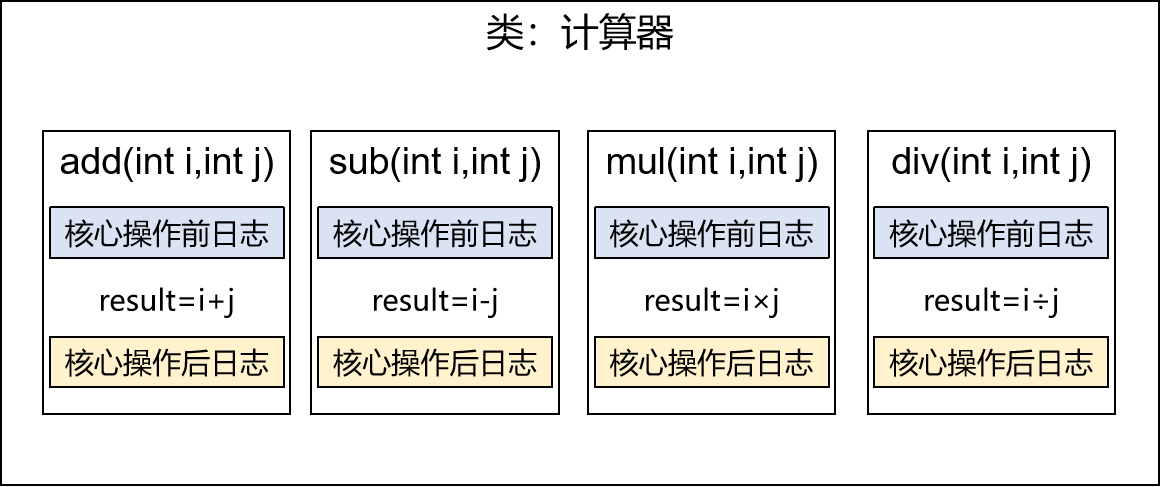
public class CalculatorLogImpl implements Calculator {
@Override
public int add(int i, int j) {
System.out.println("[日志] add 方法开始了,参数是:" + i + "," + j);
int result = i + j;
System.out.println("方法内部 result = " + result);
System.out.println("[日志] add 方法结束了,结果是:" + result);
return result;
}
@Override
public int sub(int i, int j) {
System.out.println("[日志] sub 方法开始了,参数是:" + i + "," + j);
int result = i - j;
System.out.println("方法内部 result = " + result);
System.out.println("[日志] sub 方法结束了,结果是:" + result);
return result;
}
@Override
public int mul(int i, int j) {
System.out.println("[日志] mul 方法开始了,参数是:" + i + "," + j);
int result = i * j;
System.out.println("方法内部 result = " + result);
System.out.println("[日志] mul 方法结束了,结果是:" + result);
return result;
}
@Override
public int div(int i, int j) {
System.out.println("[日志] div 方法开始了,参数是:" + i + "," + j);
int result = i / j;
System.out.println("方法内部 result = " + result);
System.out.println("[日志] div 方法结束了,结果是:" + result);
return result;
}
}
5.1.4 提出问题
①现有代码缺陷
针对带日志功能的实现类,我们发现有如下缺陷:
- 对核心业务功能有干扰,导致程序员在开发核心业务功能时分散了精力
- 附加功能分散在各个业务功能方法中,不利于统一维护
②解决思路
解决这两个问题,核心就是:解耦。我们需要把附加功能从业务功能代码中抽取出来。
③困难
解决问题的困难:要抽取的代码在方法内部,靠以前把子类中的重复代码抽取到父类的方式没法解决。所以需要引入新的技术。
5.2 代理模式
5.2.1 概念
①介绍
二十三种设计模式中的一种,属于结构型模式。它的作用就是通过提供一个代理类,让我们在调用目标方法的时候,不再是直接对目标方法进行调用,而是通过代理类间接调用。让不属于目标方法核心逻辑的代码从目标方法中剥离出来——解耦。调用目标方法时先调用代理对象的方法,减少对目标方法的调用和打扰,同时让附加功能能够集中在一起也有利于统一维护。

使用代理后:

②生活中的代理
- 广告商找大明星拍广告需要经过经纪人
- 合作伙伴找大老板谈合作要约见面时间需要经过秘书
- 房产中介是买卖双方的代理
③相关术语
- 代理:将非核心逻辑剥离出来以后,封装这些非核心逻辑的类、对象、方法。
- 目标:被代理“套用”了非核心逻辑代码的类、对象、方法。
5.2.2 静态代理
创建静态代理类:
静态代理将被代理的目标对象声明为成员变量,以便调用其方法
public class CalculatorStaticProxy implements Calculator {
// 将被代理的目标对象声明为成员变量
private Calculator target;
public CalculatorStaticProxy(Calculator target) {
this.target = target;
}
@Override
public int add(int i, int j) {
// 附加功能由代理类中的代理方法来实现
System.out.println("[日志] add 方法开始了,参数是:" + i + "," + j);
// 通过目标对象来实现核心业务逻辑
int addResult = target.add(i, j);
System.out.println("[日志] add 方法结束了,结果是:" + addResult);
return addResult;
}
}
静态代理确实实现了解耦,但是由于代码都写死了,完全不具备任何的灵活性。就拿日志功能来说,将来其他地方也需要附加日志,那还得再声明更多个静态代理类,那就产生了大量重复的代码,日志功能还是分散的,没有统一管理。
提出进一步的需求:将日志功能集中到一个代理类中,将来有任何日志需求,都通过这一个代理类来实现。这就需要使用动态代理技术了。
5.2.3 动态代理

生产代理对象的工厂类:
package com.atguigu.example;
import java.lang.reflect.InvocationHandler;
import java.lang.reflect.Proxy;
import java.util.Arrays;
/**
* @author : Sakura
* @className : ProxyFactory
* @description : TODO
* @createTime : 2023-07-24 10:09:56
*/
public class ProxyFactory {
// 目标对象
private Object target;
public ProxyFactory(Object target) {
this.target = target;
}
// 返回代理对象
public Object getProxy(){
/**
* newProxyInstance():创建一个代理实例
* 其中有三个参数:
* 1、classLoader:加载动态生成的代理类的类加载器
* 2、interfaces:目标对象实现的所有接口的class对象所组成的数组
* 3、invocationHandler:设置代理对象实现目标对象方法的过程,即代理类中如何重写接口中的抽象方法
* 参考链接: https://docs.oracle.com/en/java/javase/17/docs/api/java.base/java/lang/reflect/Proxy.html#newProxyInstance(java.lang.ClassLoader,java.lang.Class%5B%5D,java.lang.reflect.InvocationHandler)
*/
ClassLoader classLoader = target.getClass().getClassLoader();
Class<?>[] interfaces = target.getClass().getInterfaces();
// 使用lambda函数实现InvocationHandler的invoke方法
InvocationHandler invocationHandler = (proxy,method,args)->{
/**
* proxy:代理对象
* method:代理对象需要实现的方法,即其中需要重写的方法
* args:method所对应方法的参数
*/
Object result = null;
try {
System.out.println("[动态代理][日志] "+method.getName()+",参数:"+ Arrays.toString(args));
// 调用目标的方法
result = method.invoke(target, args);
System.out.println("[动态代理][日志] "+method.getName()+",结果:"+ result);
} catch (Exception e) {
e.printStackTrace();
System.out.println("[动态代理][日志] "+method.getName()+",异常:"+e.getMessage());
} finally {
System.out.println("[动态代理][日志] "+method.getName()+",方法执行完毕");
}
return result;
};
return Proxy.newProxyInstance(classLoader,interfaces,invocationHandler);
}
}
5.2.4 测试
@Test
public void test(){
ProxyFactory proxyFactory = new ProxyFactory(new CalculatorImpl());
Calculator calculator = (Calculator) proxyFactory.getProxy();
calculator.add(1,4);
calculator.mul(2,3);
}
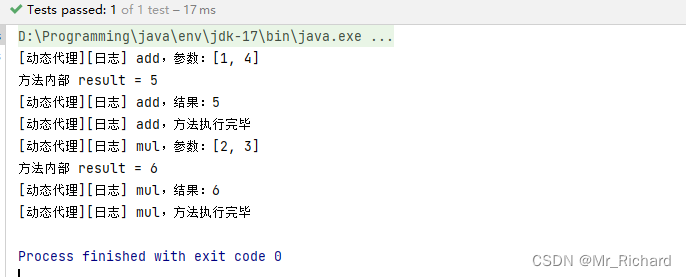
5.3 AOP概念及相关术语
5.3.1 概述
AOP(Aspect Oriented Programming)是一种设计思想,是软件设计领域中的面向切面编程,从而使得业务逻辑各部分之间的耦合度降低,提高程序的可重用性,同时提高了开发的效率。
5.3.2 相关术语
①横切关注点
分散在每个各个模块中解决同一样的问题,如用户验证、日志管理、事务处理、数据缓存都属于横切关注点。
从每个方法中抽取出来的同一类非核心业务。在同一个项目中,我们可以使用多个横切关注点对相关方法进行多个不同方面的增强。
这个概念不是语法层面的,而是根据附加功能的逻辑上的需要:有十个附加功能,就有十个横切关注点。
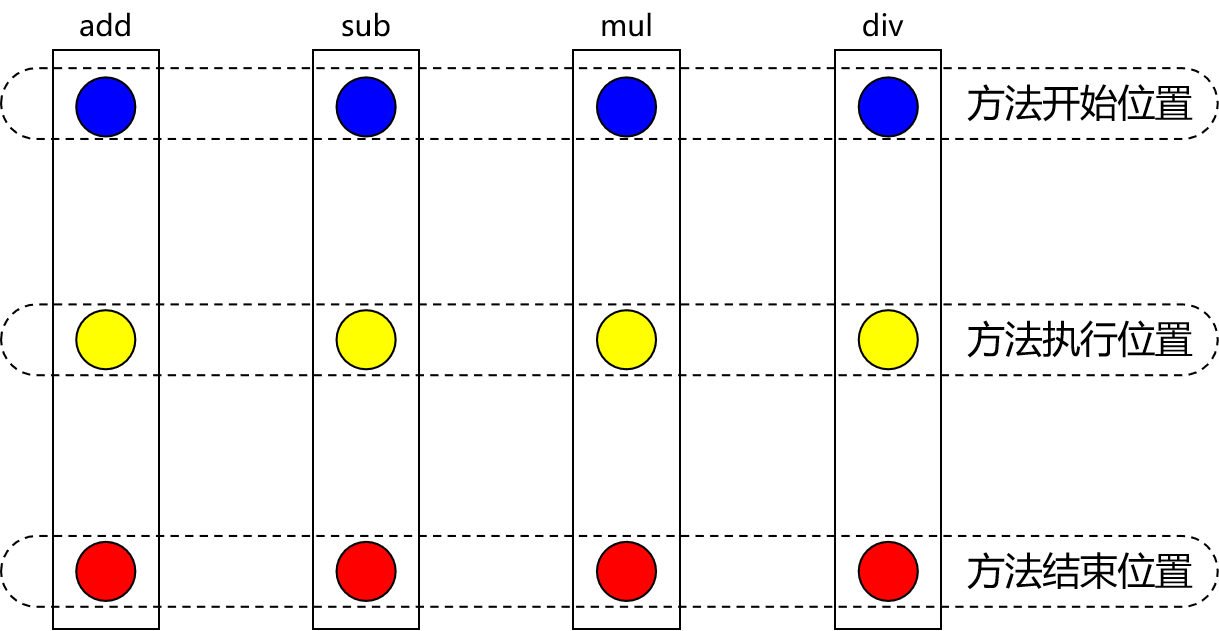
②通知(增强)-Advice
增强,通俗说,就是你想要增强的功能,比如 安全,事务,日志等。
AOP将抽取出来的共性功能称为通知。每一个横切关注点上要做的事情都需要写一个方法来实现,这样的方法就叫通知方法。
- 前置通知:在被代理的目标方法前执行
- 返回通知:在被代理的目标方法成功结束后执行(寿终正寝)
- 异常通知:在被代理的目标方法异常结束后执行(死于非命)
- 后置通知:在被代理的目标方法最终结束后执行(盖棺定论)
- 环绕通知:使用try…catch…finally结构围绕整个被代理的目标方法,包括上面四种通知对应的所有位置
执行顺序:见5.4.4节
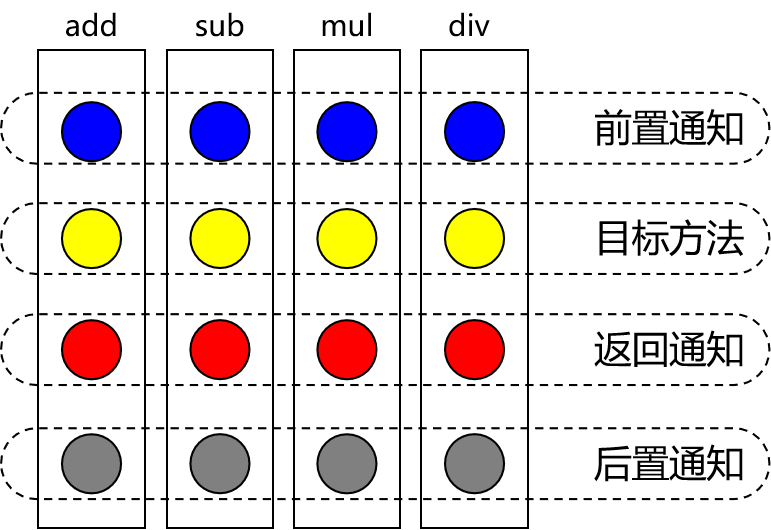
③切面-Aspect
封装通知方法的类。ASP将切入点和通知(也就是被抽取的方法,和抽取出来的共性功能)之间的关系称为切面,切面描述了两者之间的关系。
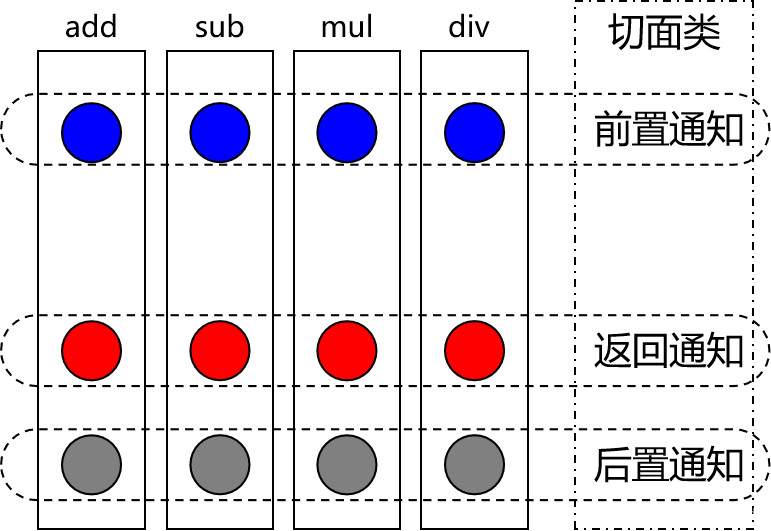
④目标对象-Target
被代理的目标对象。
⑤代理-Proxy
向目标对象应用通知之后创建的代理对象。
⑥连接点-Joinpoint
这也是一个纯逻辑概念,不是语法定义的。AOP将所有的方法都视为连接点,不管是接口里面的抽象方法,还是实现类里面的重写方法,都是连接点。
把方法排成一排,每一个横切位置看成x轴方向,把方法从上到下执行的顺序看成y轴,x轴和y轴的交叉点就是连接点。通俗说,就是spring允许使用通知的地方

⑦切入点-Pointcut
定位连接点的方式。AOP将可能被抽取共性功能的方法称为切入点。切入点是连接点的子集。
每个类的方法中都包含多个连接点,所以连接点是类中客观存在的事物(从逻辑上来说)。
如果把连接点看作数据库中的记录,那么切入点就是查询记录的 SQL 语句。
Spring 的 AOP 技术可以通过切入点定位到特定的连接点。通俗说,要实际去增强的方法
切点通过 org.springframework.aop.Pointcut 接口进行描述,它使用类和方法作为连接点的查询条件。
5.3.3 作用
-
简化代码:把方法中固定位置的重复的代码抽取出来,让被抽取的方法更专注于自己的核心功能,提高内聚性。
-
代码增强:把特定的功能封装到切面类中,看哪里有需要,就往上套,被套用了切面逻辑的方法就被切面给增强了。
5.4 基于注解的AOP
5.4.1 技术说明

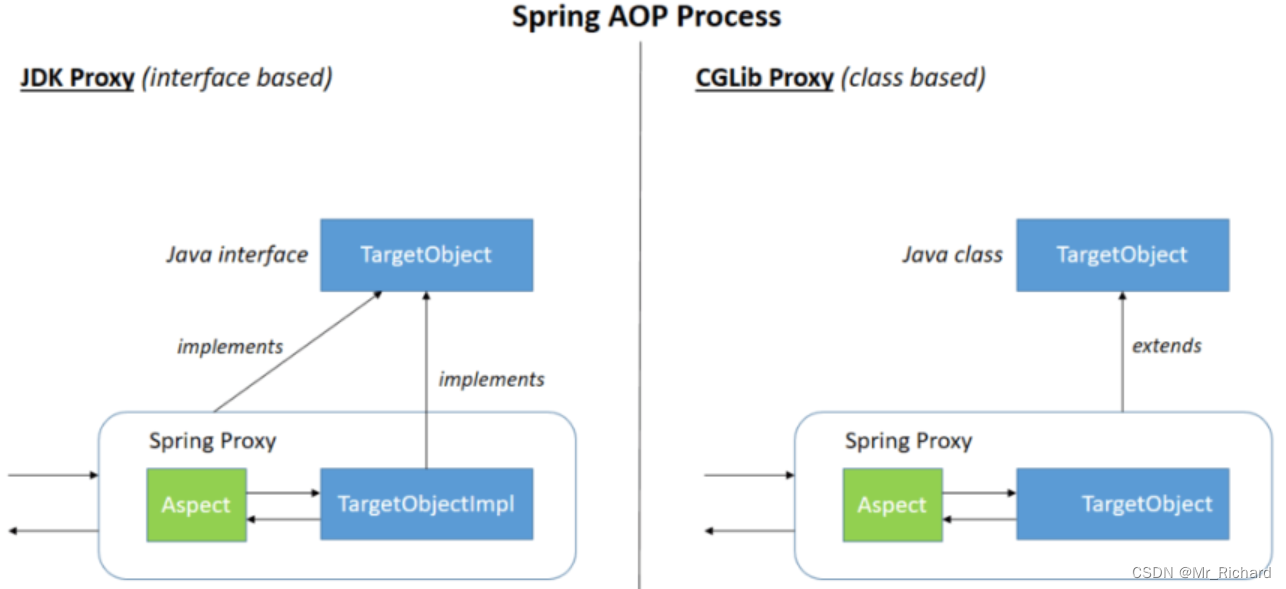
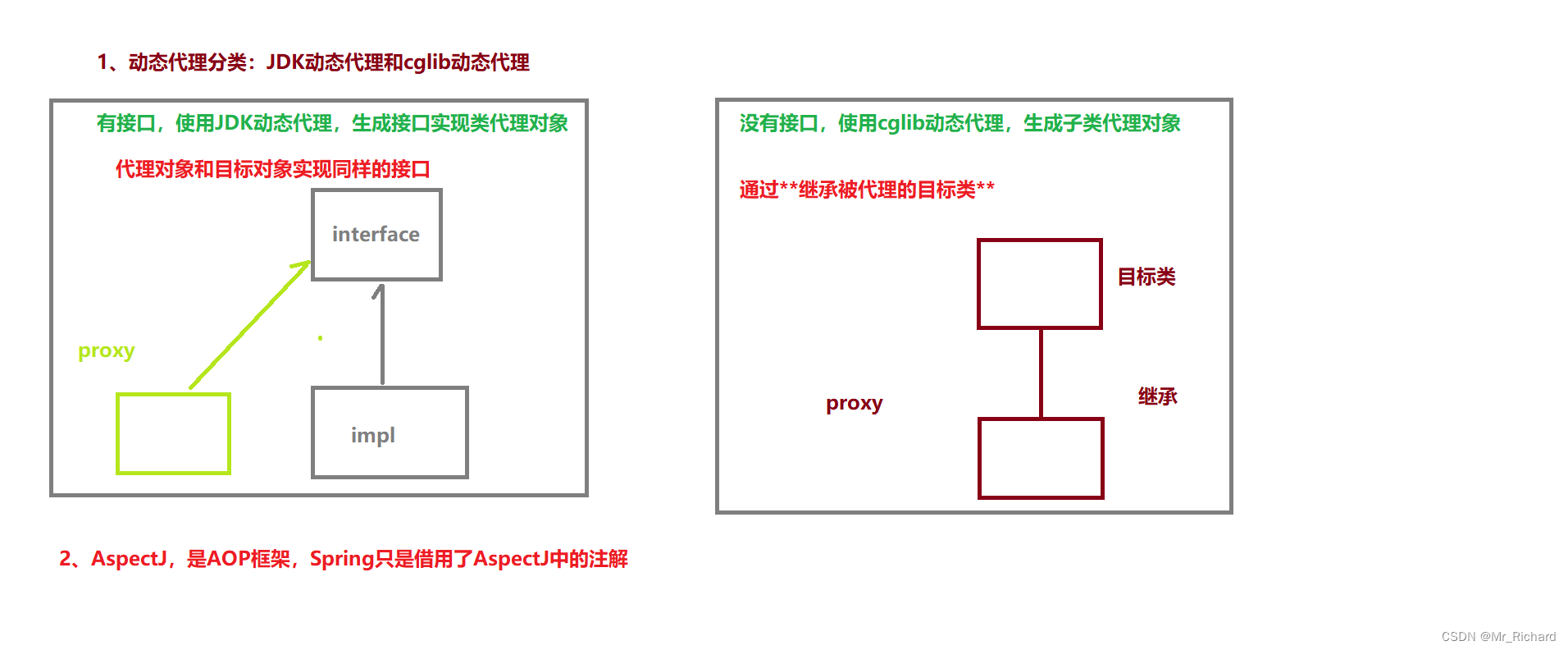
- 动态代理分为JDK动态代理和cglib动态代理
当目标类有接口的情况使用JDK动态代理和cglib动态代理,没有接口时只能使用cglib动态代理- JDK动态代理动态生成的代理类会在com.sun.proxy包下,类名为$proxy1,和目标类实现相同的接口
- cglib动态代理动态生成的代理类会和目标在在相同的包下,会继承目标类
- 动态代理(InvocationHandler):JDK原生的实现方式,需要被代理的目标类必须实现接口。因为这个技术要求**
代理对象和目标对象实现同样的接口**(兄弟两个拜把子模式)。 - cglib:通过**
继承被代理的目标类**(认干爹模式)实现代理,所以不需要目标类实现接口。 AspectJ:是AOP思想的一种实现。本质上是静态代理,将代理逻辑“织入”被代理的目标类编译得到的字节码文件,所以最终效果是动态的。weaver就是织入器。Spring只是借用了AspectJ中的注解。
5.4.2 准备工作
①添加依赖
在IOC所需依赖基础上再加入下面依赖即可:
<dependencies>
<!--spring context依赖-->
<!--当你引入Spring Context依赖之后,表示将Spring的基础依赖引入了-->
<dependency>
<groupId>org.springframework</groupId>
<artifactId>spring-context</artifactId>
<version>6.0.11</version>
</dependency>
<!--spring aop依赖-->
<dependency>
<groupId>org.springframework</groupId>
<artifactId>spring-aop</artifactId>
<version>6.0.11</version>
</dependency>
<!--spring aspects依赖-->
<dependency>
<groupId>org.springframework</groupId>
<artifactId>spring-aspects</artifactId>
<version>6.0.11</version>
</dependency>
<!--junit5测试-->
<dependency>
<groupId>org.junit.jupiter</groupId>
<artifactId>junit-jupiter-api</artifactId>
<version>5.9.2</version>
</dependency>
<!--log4j2的依赖-->
<dependency>
<groupId>org.apache.logging.log4j</groupId>
<artifactId>log4j-core</artifactId>
<version>2.19.0</version>
</dependency>
<dependency>
<groupId>org.apache.logging.log4j</groupId>
<artifactId>log4j-slf4j2-impl</artifactId>
<version>2.19.0</version>
</dependency>
</dependencies>
②准备被代理的目标资源
接口:
public interface Calculator {
int add(int i, int j);
int sub(int i, int j);
int mul(int i, int j);
int div(int i, int j);
}
实现类:
@Component
public class CalculatorImpl implements Calculator {
@Override
public int add(int i, int j) {
int result = i + j;
System.out.println("方法内部 result = " + result);
// 为了测试效果,模拟异常信息
int a = 1/0;
return result;
}
@Override
public int sub(int i, int j) {
int result = i - j;
System.out.println("方法内部 result = " + result);
return result;
}
@Override
public int mul(int i, int j) {
int result = i * j;
System.out.println("方法内部 result = " + result);
return result;
}
@Override
public int div(int i, int j) {
int result = i / j;
System.out.println("方法内部 result = " + result);
return result;
}
}
5.4.3 创建切面类并配置
package com.atguigu.ano;
import org.aspectj.lang.JoinPoint;
import org.aspectj.lang.ProceedingJoinPoint;
import org.aspectj.lang.annotation.*;
import org.springframework.stereotype.Component;
import java.util.Arrays;
/**
* @author : Sakura
* @className : LogAspect
* @description : 切面类
* @createTime : 2023-07-24 11:03:42
*/
@Component // 交由IoC容器进行管理
@Aspect // 声明为切面类
public class LogAspect {
// 设置切入点和通知类型
/**
* 前置通知:在被代理的目标方法前执行
* 设置前置通知 @Before(value = "切入点表达式配置切入点")
* 切入点表达式:详见笔记
* 下面切入点设置为:public int CalculatorImpl 所有方法 任意参数类型
*/
@Before(value = "execution(public int com.atguigu.ano.CalculatorImpl.*(..))")
public void beforeMethod(JoinPoint joinPoint) {
//使用JoinPoint获取方法签名、方法参数等相关信息
// 获取方法名
String methodName = joinPoint.getSignature().getName();
// 获取方法参数
Object[] args = joinPoint.getArgs();
System.out.println("Logger--前置通知,方法名称:" + methodName + ",方法参数:" + Arrays.toString(args));
}
// 设置返回通知
//@AfterReturning
/**
* 返回通知:在被代理的目标方法成功结束后执行
* 设置返回通知: @AfterReturning(value = "切入点表达式配置切入点", returning = "res")
* res: 目标方法的返回结果
*/
@AfterReturning(value = "execution(public int com.atguigu.ano.CalculatorImpl.*(..))", returning = "result")
public void AfterReturningMethod(JoinPoint joinPoint, Object result) {
//使用JoinPoint获取方法签名、方法参数等相关信息
// 获取方法名
String methodName = joinPoint.getSignature().getName();
// 获取方法参数
Object[] args = joinPoint.getArgs();
System.out.println("Logger--返回通知,方法名称:" + methodName + ",返回结果:" + result);
}
/**
* 后置通知:在被代理的目标方法最终结束后执行
* 设置前置通知: @After(value = "切入点表达式配置切入点")
*/
@After(value = "execution(public int com.atguigu.ano.CalculatorImpl.*(..))")
public void afterMethod(JoinPoint joinPoint) {
//使用JoinPoint获取方法签名、方法参数等相关信息
// 获取方法名
String methodName = joinPoint.getSignature().getName();
// 获取方法参数
Object[] args = joinPoint.getArgs();
System.out.println("Logger--后置通知,方法名称:" + methodName);
}
/**
* 异常通知:在被代理的目标方法异常结束后执行
* 设置异常通知: @AfterThrowing(value = "切入点表达式配置切入点", throwing = "ex")
* ex: 代指异常信息
*/
@AfterThrowing(value = "execution(public int com.atguigu.ano.CalculatorImpl.*(..))", throwing = "ex")
public void afterThrowingMethod(JoinPoint joinPoint, Throwable ex) {
//使用JoinPoint获取方法签名、方法参数等相关信息
// 获取方法名
String methodName = joinPoint.getSignature().getName();
System.out.println("Logger--异常通知,方法名称:" + methodName + ",异常信息:" + ex.getMessage());
}
/**
* 环绕通知:使用try...catch...finally结构围绕整个被代理的目标方法,包括上面四种通知对应的所有位置
* 设置异常通知: @Around(value = "切入点表达式配置切入点)
* 注:可以使用JoinPoint的子类 ProceedingJoinPoint 调用目标方法
*/
@Around(value = "execution(public int com.atguigu.ano.CalculatorImpl.*(..))")
public Object aroundMethod(ProceedingJoinPoint joinPoint) {
//使用JoinPoint获取方法签名、方法参数等相关信息
// 获取方法名
String methodName = joinPoint.getSignature().getName();
// 获取方法参数
Object[] args = joinPoint.getArgs();
Object result = null;
try {
System.out.println("环绕通知——目标方法执行之前");
// 使用JoinPoint的子类 ProceedingJoinPoint 调用目标方法
result = joinPoint.proceed();
System.out.println("环绕通知——目标方法返回值之后");
} catch (Throwable e) {
e.printStackTrace();
System.out.println("环绕通知——目标方法出现异常执行");
}finally {
System.out.println("环绕通知——目标方法执行完毕后执行");
}
return result;
}
}
在Spring的配置文件中配置:
<?xml version="1.0" encoding="UTF-8"?>
<beans xmlns="http://www.springframework.org/schema/beans"
xmlns:xsi="http://www.w3.org/2001/XMLSchema-instance"
xmlns:context="http://www.springframework.org/schema/context"
xmlns:aop="http://www.springframework.org/schema/aop"
xsi:schemaLocation="http://www.springframework.org/schema/beans
http://www.springframework.org/schema/beans/spring-beans.xsd
http://www.springframework.org/schema/context
http://www.springframework.org/schema/context/spring-context.xsd
http://www.springframework.org/schema/aop
http://www.springframework.org/schema/aop/spring-aop.xsd">
<!--
基于注解的AOP的实现:
1、将目标对象和切面交给IOC容器管理(注解+扫描)
2、开启AspectJ的自动代理,为目标对象自动生成代理
3、将切面类通过注解@Aspect标识
-->
<context:component-scan base-package="com.atguigu.aop.annotation"></context:component-scan>
<aop:aspectj-autoproxy />
</beans>
或者使用注解配置类
package com.atguigu.ano;
import org.springframework.context.annotation.ComponentScan;
import org.springframework.context.annotation.Configuration;
import org.springframework.context.annotation.EnableAspectJAutoProxy;
import org.springframework.stereotype.Component;
/**
* @author : Sakura
* @className : MyConfig
* @description : TODO
* @createTime : 2023-07-24 11:27:56
*/
@Configuration // 声明为配置类
@ComponentScan("com.atguigu.ano") // 设置包扫描路径
@EnableAspectJAutoProxy // 开启AOP自动代理
public class MyConfig {
}
执行测试:
@Test
public void testAdd(){
// ApplicationContext applicationContext = new ClassPathXmlApplicationContext("bean-ano.xml");
ApplicationContext applicationContext = new AnnotationConfigApplicationContext(MyConfig.class);
Calculator calculator = applicationContext.getBean(Calculator.class);
calculator.add(2,3);
}
执行结果:
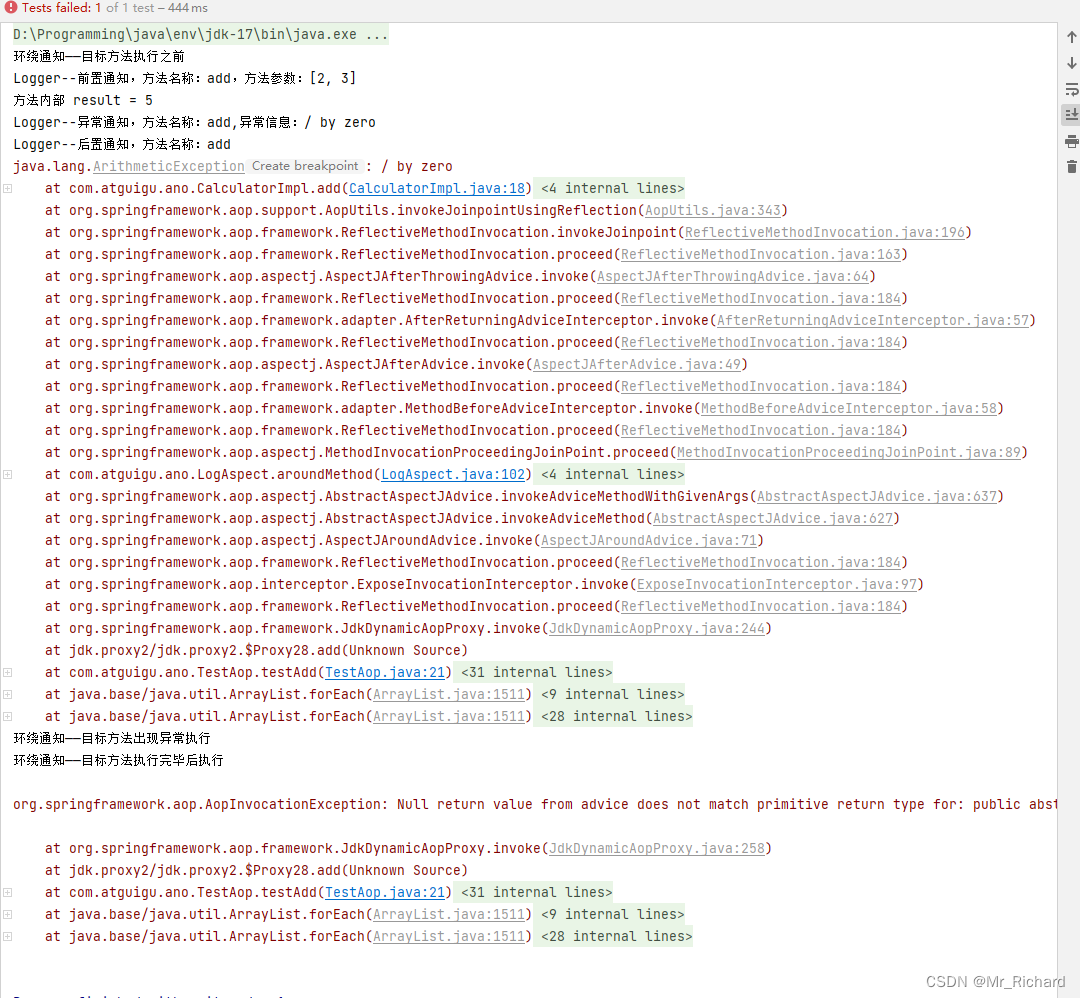
5.4.4 各种通知
- 前置通知:使用@Before注解标识,在被代理的目标方法前执行
- 返回通知:使用@AfterReturning注解标识,在被代理的目标方法成功结束后执行(寿终正寝)
- 异常通知:使用@AfterThrowing注解标识,在被代理的目标方法异常结束后执行(死于非命)
- 后置通知:使用@After注解标识,在被代理的目标方法最终结束后执行(盖棺定论)
- 环绕通知:使用@Around注解标识,使用try…catch…finally结构围绕整个被代理的目标方法,包括上面四种通知对应的所有位置。简言之,
环绕通知就相当于在前置和后置通知的外面再包了一层通知。此外,环绕通知可以使用JoinPoint的子类 ProceedingJoinPoint 调用目标方法。
各种通知的执行顺序:
- Spring版本5.3.x以前:
- 前置通知
- 目标操作
- 后置通知
- 返回通知或异常通知
- Spring版本5.3.x以后:
- 前置通知
- 目标操作
- 返回通知或异常通知
- 后置通知
5.4.5 切入点表达式语法
①作用
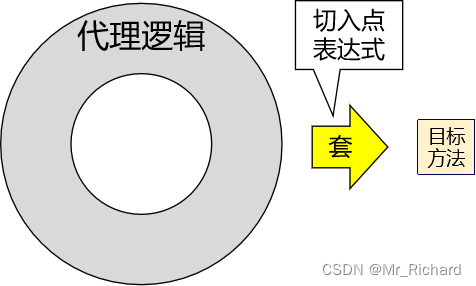
②语法细节
-
用*号代替“权限修饰符”和“返回值”部分表示“权限修饰符”和“返回值”不限
-
在包名的部分,一个“*”号只能代表包的层次结构中的一层,表示这一层是任意的。
- 例如:*.Hello匹配com.Hello,不匹配com.atguigu.Hello
-
在包名的部分,使用“*…”表示包名任意、包的层次深度任意
-
在类名的部分,类名部分整体用*号代替,表示类名任意
-
在类名的部分,可以使用*号代替类名的一部分
- 例如:*Service匹配所有名称以Service结尾的类或接口
-
在方法名部分,可以使用*号表示方法名任意
-
在方法名部分,可以使用*号代替方法名的一部分
- 例如:*Operation匹配所有方法名以Operation结尾的方法
-
在方法参数列表部分,使用(…)表示参数列表任意
-
在方法参数列表部分,使用(int,…)表示参数列表以一个int类型的参数开头
-
在方法参数列表部分,基本数据类型和对应的包装类型是不一样的
- 切入点表达式中使用 int 和实际方法中 Integer 是不匹配的
-
在方法返回值部分,如果想要明确指定一个返回值类型,那么必须同时写明权限修饰符
- 例如:execution(public int …Service.(…, int)) 正确
例如:execution( int *…Service.(…, int)) 错误
- 例如:execution(public int …Service.(…, int)) 正确

5.4.6 切入点表达式复用
①声明
/**
* 复用切入点表达式,使用格式:
* 同一个切面类: @Before(value = "pointCut()") (全类名可以省略不写)
* 不同切面类: @After(value = "com.atguigu.ano.CommonPointCut.pointCut()")
*/
@Pointcut("execution(* com.atguigu.ano.CalculatorImpl.*(..))")
public void pointCut(){}
②在同一个切面类中使用
@Before(value = "pointCut()")
public void beforeMethod(JoinPoint joinPoint) {
//使用JoinPoint获取方法签名、方法参数等相关信息
// 获取方法名
String methodName = joinPoint.getSignature().getName();
// 获取方法参数
Object[] args = joinPoint.getArgs();
System.out.println("Logger--前置通知,方法名称:" + methodName + ",方法参数:" + Arrays.toString(args));
}
③在不同切面类中使用
@After(value = "com.atguigu.ano.CommonPointCut.pointCut()")
public void afterMethod(JoinPoint joinPoint) {
//使用JoinPoint获取方法签名、方法参数等相关信息
// 获取方法名
String methodName = joinPoint.getSignature().getName();
// 获取方法参数
Object[] args = joinPoint.getArgs();
System.out.println("Logger--后置通知,方法名称:" + methodName);
}
5.4.7 获取通知的相关信息
①获取连接点信息
获取连接点信息可以在通知方法的参数位置设置JoinPoint类型的形参
@Before(value = "execution(public int com.atguigu.ano.CalculatorImpl.*(..))")
@Before(value = "pointCut()")
public void beforeMethod(JoinPoint joinPoint) {
//使用JoinPoint获取方法签名、方法参数等相关信息
// 获取方法名
String methodName = joinPoint.getSignature().getName();
// 获取方法参数
Object[] args = joinPoint.getArgs();
System.out.println("Logger--前置通知,方法名称:" + methodName + ",方法参数:" + Arrays.toString(args));
}
②获取目标方法的返回值
@AfterReturning中的属性returning,用来将通知方法的某个形参,接收目标方法的返回值
/**
* 返回通知:在被代理的目标方法成功结束后执行
* 设置返回通知: @AfterReturning(value = "切入点表达式配置切入点", returning = "res")
* res: 目标方法的返回结果
*/
@AfterReturning(value = "execution(public int com.atguigu.ano.CalculatorImpl.*(..))", returning = "result")
public void AfterReturningMethod(JoinPoint joinPoint, Object result) {
//使用JoinPoint获取方法签名、方法参数等相关信息
// 获取方法名
String methodName = joinPoint.getSignature().getName();
// 获取方法参数
Object[] args = joinPoint.getArgs();
System.out.println("Logger--返回通知,方法名称:" + methodName + ",返回结果:" + result);
}
③获取目标方法的异常
@AfterThrowing中的属性throwing,用来将通知方法的某个形参,接收目标方法的异常
/**
* 异常通知:在被代理的目标方法异常结束后执行
* 设置异常通知: @AfterThrowing(value = "切入点表达式配置切入点", throwing = "ex")
* ex: 代指异常信息
*/
@AfterThrowing(value = "execution(public int com.atguigu.ano.CalculatorImpl.*(..))", throwing = "ex")
public void afterThrowingMethod(JoinPoint joinPoint, Throwable ex) {
//使用JoinPoint获取方法签名、方法参数等相关信息
// 获取方法名
String methodName = joinPoint.getSignature().getName();
System.out.println("Logger--异常通知,方法名称:" + methodName + ",异常信息:" + ex.getMessage());
}
5.4.8 环绕通知
/**
* 环绕通知:使用try...catch...finally结构围绕整个被代理的目标方法,包括上面四种通知对应的所有位置
* 设置异常通知: @Around(value = "切入点表达式配置切入点)
* 注:可以使用JoinPoint的子类 ProceedingJoinPoint 调用目标方法
*/
@Around(value = "execution(public int com.atguigu.ano.CalculatorImpl.*(..))")
public Object aroundMethod(ProceedingJoinPoint joinPoint) {
//使用JoinPoint获取方法签名、方法参数等相关信息
// 获取方法名
String methodName = joinPoint.getSignature().getName();
// 获取方法参数
Object[] args = joinPoint.getArgs();
Object result = null;
try {
System.out.println("环绕通知——目标方法执行之前");
// 使用JoinPoint的子类 ProceedingJoinPoint 调用目标方法
result = joinPoint.proceed();
System.out.println("环绕通知——目标方法返回值之后");
} catch (Throwable e) {
e.printStackTrace();
System.out.println("环绕通知——目标方法出现异常执行");
}finally {
System.out.println("环绕通知——目标方法执行完毕后执行");
}
return result;
}
5.4.9 切面的优先级
相同目标方法上同时存在多个切面时,切面的优先级控制切面的内外嵌套顺序。
- 优先级高的切面:外面
- 优先级低的切面:里面
使用@Order注解可以控制切面的优先级:
- @Order(较小的数):优先级高
- @Order(较大的数):优先级低
@Component // 交由IoC容器进行管理
@Aspect // 声明为切面类
@Order(5)
public class LogAspect {
....
}

5.5 基于XML的AOP
5.5.1 准备工作
Calculator和CalculatorImpl类0参考基于注解的AOP环境
LogAspect.java
package com.atguigu.xml;
import org.aspectj.lang.JoinPoint;
import org.aspectj.lang.ProceedingJoinPoint;
import org.aspectj.lang.annotation.*;
import org.springframework.core.annotation.Order;
import org.springframework.stereotype.Component;
import java.util.Arrays;
/**
* @author : Sakura
* @className : LogAspect
* @description : 切面类
* @createTime : 2023-07-24 11:03:42
*/
@Component // 交由IoC容器进行管理
public class LogAspect {
/**
* 前置通知:在被代理的目标方法前执行
* 设置前置通知 @Before(value = "切入点表达式配置切入点")
* 切入点表达式:详见笔记
* 下面切入点设置为:public int CalculatorImpl 所有方法 任意参数类型
*/
public void beforeMethod(JoinPoint joinPoint) {
//使用JoinPoint获取方法签名、方法参数等相关信息
// 获取方法名
String methodName = joinPoint.getSignature().getName();
// 获取方法参数
Object[] args = joinPoint.getArgs();
System.out.println("Logger--前置通知,方法名称:" + methodName + ",方法参数:" + Arrays.toString(args));
}
/**
* 返回通知:在被代理的目标方法成功结束后执行
* 设置返回通知: @AfterReturning(value = "切入点表达式配置切入点", returning = "res")
* res: 目标方法的返回结果
*/
public void AfterReturningMethod(JoinPoint joinPoint, Object result) {
//使用JoinPoint获取方法签名、方法参数等相关信息
// 获取方法名
String methodName = joinPoint.getSignature().getName();
// 获取方法参数
Object[] args = joinPoint.getArgs();
System.out.println("Logger--返回通知,方法名称:" + methodName + ",返回结果:" + result);
}
/**
* 后置通知:在被代理的目标方法最终结束后执行
* 设置前置通知: @After(value = "切入点表达式配置切入点")
*/
public void afterMethod(JoinPoint joinPoint) {
//使用JoinPoint获取方法签名、方法参数等相关信息
// 获取方法名
String methodName = joinPoint.getSignature().getName();
// 获取方法参数
Object[] args = joinPoint.getArgs();
System.out.println("Logger--后置通知,方法名称:" + methodName);
}
/**
* 异常通知:在被代理的目标方法异常结束后执行
* 设置异常通知: @AfterThrowing(value = "切入点表达式配置切入点", throwing = "ex")
* ex: 代指异常信息
*/
public void afterThrowingMethod(JoinPoint joinPoint, Throwable ex) {
//使用JoinPoint获取方法签名、方法参数等相关信息
// 获取方法名
String methodName = joinPoint.getSignature().getName();
System.out.println("Logger--异常通知,方法名称:" + methodName + ",异常信息:" + ex.getMessage());
}
/**
* 环绕通知:使用try...catch...finally结构围绕整个被代理的目标方法,包括上面四种通知对应的所有位置
* 设置异常通知: @Around(value = "切入点表达式配置切入点)
* 注:可以使用JoinPoint的子类 ProceedingJoinPoint 调用目标方法
*/
public Object aroundMethod(ProceedingJoinPoint joinPoint) {
//使用JoinPoint获取方法签名、方法参数等相关信息
// 获取方法名
String methodName = joinPoint.getSignature().getName();
// 获取方法参数
Object[] args = joinPoint.getArgs();
Object result = null;
try {
System.out.println("环绕通知——目标方法执行之前");
// 使用JoinPoint的子类 ProceedingJoinPoint 调用目标方法
result = joinPoint.proceed();
System.out.println("环绕通知——目标方法返回值之后");
} catch (Throwable e) {
e.printStackTrace();
System.out.println("环绕通知——目标方法出现异常执行");
}finally {
System.out.println("环绕通知——目标方法执行完毕后执行");
}
return result;
}
/**
* 复用切入点表达式,使用格式:
* 同一个切面类: @Before(value = "pointCut()") (全类名可以省略不写)
* 不同切面类: @After(value = "com.atguigu.ano.CommonPointCut.pointCut()")
*/
@Pointcut("execution(* com.atguigu.xml.CalculatorImpl.*(..))")
public void pointCut(){}
}
5.5.2 实现
<?xml version="1.0" encoding="UTF-8"?>
<beans xmlns="http://www.springframework.org/schema/beans"
xmlns:xsi="http://www.w3.org/2001/XMLSchema-instance"
xmlns:context="http://www.springframework.org/schema/context"
xmlns:aop="http://www.springframework.org/schema/aop"
xsi:schemaLocation="http://www.springframework.org/schema/beans
http://www.springframework.org/schema/beans/spring-beans.xsd
http://www.springframework.org/schema/context
http://www.springframework.org/schema/context/spring-context.xsd
http://www.springframework.org/schema/aop
http://www.springframework.org/schema/aop/spring-aop.xsd">
<!-- 开启组件扫描-->
<context:component-scan base-package="com.atguigu.xml" />
<!-- 配置AOP的五种通知类型-->
<aop:config>
<!-- 配置切面类-->
<aop:aspect ref="logAspect">
<!-- 配置切入点-->
<aop:pointcut id="pointCut" expression="execution(* com.atguigu.xml.CalculatorImpl.*(..))"/>
<!-- 配置五种通知类型-->
<!-- 使用pointcut-ref引用上面配置的切入点-->
<aop:before method="beforeMethod" pointcut-ref="pointCut"/>
<aop:after method="afterMethod" pointcut-ref="pointCut"/>
<!-- returning配置返回通知的返回值-->
<aop:after-returning method="AfterReturningMethod" pointcut-ref="pointCut" returning="result"/>
<!-- throwing配置异常信息-->
<aop:after-throwing method="afterThrowingMethod" pointcut-ref="pointCut" throwing="ex"/>
<aop:around method="aroundMethod" pointcut-ref="pointCut"/>
</aop:aspect>
</aop:config>
</beans>

6 单元测试:JUnit
在之前的测试方法中,几乎都能看到以下的两行代码:
ApplicationContext context = new ClassPathXmlApplicationContext("xxx.xml");
Xxxx xxx = context.getBean(Xxxx.class);
这两行代码的作用是创建Spring容器,最终获取到对象,但是每次测试都需要重复编写。针对上述问题,我们需要的是程序能自动帮我们创建容器。我们都知道JUnit无法知晓我们是否使用了 Spring 框架,更不用说帮我们创建 Spring 容器了。Spring提供了一个运行器,可以读取配置文件(或注解)来创建容器。我们只需要告诉它配置文件位置就可以了。这样一来,我们通过Spring整合JUnit可以使程序创建spring容器了
6.1 整合JUnit5
6.1.1 搭建子模块
搭建spring-junit模块
6.1.2 引入依赖
<dependencies>
<!--spring context依赖-->
<!--当你引入Spring Context依赖之后,表示将Spring的基础依赖引入了-->
<dependency>
<groupId>org.springframework</groupId>
<artifactId>spring-context</artifactId>
<version>6.0.11</version>
</dependency>
<!--spring对junit的支持相关依赖-->
<dependency>
<groupId>org.springframework</groupId>
<artifactId>spring-test</artifactId>
<version>6.0.11</version>
</dependency>
<!--junit5测试-->
<dependency>
<groupId>org.junit.jupiter</groupId>
<artifactId>junit-jupiter-api</artifactId>
<version>5.9.2</version>
</dependency>
<!--log4j2的依赖-->
<dependency>
<groupId>org.apache.logging.log4j</groupId>
<artifactId>log4j-core</artifactId>
<version>2.19.0</version>
</dependency>
<dependency>
<groupId>org.apache.logging.log4j</groupId>
<artifactId>log4j-slf4j2-impl</artifactId>
<version>2.19.0</version>
</dependency>
</dependencies>
6.1.3 添加配置文件
beans.xml
<?xml version="1.0" encoding="UTF-8"?>
<beans xmlns="http://www.springframework.org/schema/beans"
xmlns:xsi="http://www.w3.org/2001/XMLSchema-instance"
xmlns:context="http://www.springframework.org/schema/context"
xmlns:aop="http://www.springframework.org/schema/aop"
xsi:schemaLocation="http://www.springframework.org/schema/beans
http://www.springframework.org/schema/beans/spring-beans.xsd
http://www.springframework.org/schema/context
http://www.springframework.org/schema/context/spring-context.xsd
http://www.springframework.org/schema/aop
http://www.springframework.org/schema/aop/spring-aop.xsd">
<!-- 开启组件扫描-->
<context:component-scan base-package="com.atguigu.junit"/>
</beans>
copy日志文件:log4j2.xml
6.1.4 添加java类
package com.atguigu.junit.junit5;
import org.springframework.stereotype.Component;
/**
* @author : Sakura
* @className : User
* @description : TODO
* @createTime : 2023-07-24 15:49:50
*/
@Component
public class User {
public void run(){
System.out.println("user...");
}
}
6.1.5 测试
package com.atguigu.junit.junit5;
import org.junit.jupiter.api.Test;
import org.junit.jupiter.api.extension.ExtendWith;
import org.springframework.beans.factory.annotation.Autowired;
import org.springframework.test.context.ContextConfiguration;
import org.springframework.test.context.junit.jupiter.SpringExtension;
/**
* @author : Sakura
* @className : Junit5Test
* @description : TODO
* @createTime : 2023-07-24 15:50:40
*/
// 方式一
@ExtendWith(SpringExtension.class)
@ContextConfiguration("classpath:spring-junit.xml")
// 方式二
//@SpringJUnitConfig(locations = "classpath:spring-junit.xml")
public class Junit5Test {
// bean注入
@Autowired
private User user;
// 测试方法
@Test
public void test(){
System.out.println(user);
user.run();
}
}
6.2 整合JUnit4
JUnit4在公司也会经常用到,在此也学习一下
6.2.1 添加依赖
<!-- junit测试 -->
<dependency>
<groupId>junit</groupId>
<artifactId>junit</artifactId>
<version>4.13.2</version>
</dependency>
6.2.2 测试
package com.atguigu.junit.junit4;
import com.atguigu.junit.junit5.User;
import org.junit.jupiter.api.Test;
import org.junit.jupiter.api.extension.ExtendWith;
import org.junit.runner.RunWith;
import org.springframework.beans.factory.annotation.Autowired;
import org.springframework.test.context.ContextConfiguration;
import org.springframework.test.context.junit.jupiter.SpringExtension;
import org.springframework.test.context.junit4.SpringJUnit4ClassRunner;
/**
* @author : Sakura
* @className : Junit5Test
* @description : TODO
* @createTime : 2023-07-24 15:50:40
*/
@RunWith(SpringJUnit4ClassRunner.class)
@ContextConfiguration("classpath:spring-junit.xml")
public class Junit4Test {
// bean注入
@Autowired
private User user;
// 测试方法
@Test
public void test(){
System.out.println(user);
user.run();
}
}
7 事务
7.1 JdbcTemplate
7.1.1 简介

Spring 框架对 JDBC 进行封装,使用 JdbcTemplate 方便实现对数据库操作
7.1.2 准备工作
①搭建子模块
搭建子模块:spring-jdbc-tx
②加入依赖
<dependencies>
<!--spring jdbc Spring 持久化层支持jar包-->
<dependency>
<groupId>org.springframework</groupId>
<artifactId>spring-jdbc</artifactId>
<version>6.0.2</version>
</dependency>
<!-- MySQL驱动 -->
<dependency>
<groupId>mysql</groupId>
<artifactId>mysql-connector-java</artifactId>
<version>8.0.30</version>
</dependency>
<!-- 数据源 -->
<dependency>
<groupId>com.alibaba</groupId>
<artifactId>druid</artifactId>
<version>1.2.15</version>
</dependency>
</dependencies>
③创建jdbc.properties
jdbc.user=root
jdbc.password=root
jdbc.url=jdbc:mysql://localhost:3306/springtest?characterEncoding=utf8&useSSL=false
jdbc.driver=com.mysql.cj.jdbc.Driver
④配置Spring的配置文件
beans.xml
<?xml version="1.0" encoding="UTF-8"?>
<beans xmlns="http://www.springframework.org/schema/beans"
xmlns:xsi="http://www.w3.org/2001/XMLSchema-instance"
xmlns:context="http://www.springframework.org/schema/context"
xsi:schemaLocation="http://www.springframework.org/schema/beans
http://www.springframework.org/schema/beans/spring-beans.xsd
http://www.springframework.org/schema/context
http://www.springframework.org/schema/context/spring-context.xsd">
<!-- 导入外部属性文件 -->
<context:property-placeholder location="classpath:jdbc.properties" />
<!-- 配置数据源 -->
<bean id="druidDataSource" class="com.alibaba.druid.pool.DruidDataSource">
<property name="url" value="${jdbc.url}"/>
<property name="driverClassName" value="${jdbc.driver}"/>
<property name="username" value="${jdbc.user}"/>
<property name="password" value="${jdbc.password}"/>
</bean>
<!-- 配置 JdbcTemplate -->
<bean id="jdbcTemplate" class="org.springframework.jdbc.core.JdbcTemplate">
<!-- 装配数据源 -->
<property name="dataSource" ref="druidDataSource"/>
</bean>
</beans>
⑤准备数据库与测试表
use `springtest`;
CREATE TABLE `t_emp` (
`id` int(11) NOT NULL AUTO_INCREMENT,
`name` varchar(20) DEFAULT NULL COMMENT '姓名',
`age` int(11) DEFAULT NULL COMMENT '年龄',
`sex` varchar(2) DEFAULT NULL COMMENT '性别',
PRIMARY KEY (`id`)
) ENGINE=InnoDB DEFAULT CHARSET=utf8mb4;
Emp实体类:
package com.atguigu.jdbc;
public class Emp {
private Integer id;
private String name;
private Integer age;
private String sex;
public Emp(Integer id, String name, Integer age, String sex) {
this.id = id;
this.name = name;
this.age = age;
this.sex = sex;
}
public Emp() {
}
//生成get和set方法
public Integer getId() {
return id;
}
public void setId(Integer id) {
this.id = id;
}
public String getName() {
return name;
}
public void setName(String name) {
this.name = name;
}
public Integer getAge() {
return age;
}
public void setAge(Integer age) {
this.age = age;
}
public String getSex() {
return sex;
}
public void setSex(String sex) {
this.sex = sex;
}
@Override
public String toString() {
return "Emp{" +
"id=" + id +
", name='" + name + '\'' +
", age=" + age +
", sex='" + sex + '\'' +
'}';
}
}
7.1.3 实现CURD
①装配 JdbcTemplate
创建测试类,整合JUnit,注入JdbcTemplate
package com.atguigu.jdbc;
import org.junit.jupiter.api.Test;
import org.springframework.beans.factory.annotation.Autowired;
import org.springframework.jdbc.core.BeanPropertyRowMapper;
import org.springframework.jdbc.core.JdbcTemplate;
import org.springframework.test.context.junit.jupiter.SpringJUnitConfig;
import java.util.List;
/**
* @author : Sakura
* @className : JdbcTemplateTest
* @description : TODO
* @createTime : 2023-07-24 16:16:10
*/
@SpringJUnitConfig(locations = "classpath:spring-jdbc.xml")
public class JdbcTemplateTest {
@Autowired
private JdbcTemplate jdbcTemplate;
}
②测试增删改功能
在JdbcTemplateTest.java进行单元测试
/**
* 使用JdbcTemplate实现 添加 操作
*/
@Test
public void testAdd() {
// 写sql语句
String sql = " insert into t_emp values(NULL, ?, ?, ?);";
// Object[] params = {"令狐冲", 21, "男"};
Object[] params = {"林平之", 20, "男"};
// 调用JdbcTemplate的方法并传入参数, 返回值表示影响行数
int rows = jdbcTemplate.update(sql, params);
System.out.println(rows);
}
/**
* 使用JdbcTemplate实现 修改 操作
*/
@Test
public void testUpdate() {
// 写sql语句
String sql = " update t_emp set age = ? where id = ?;";
Object[] params = {35, 1};
// 调用JdbcTemplate的方法并传入参数, 返回值表示影响行数
int rows = jdbcTemplate.update(sql, params);
System.out.println(rows);
}
/**
* 使用JdbcTemplate实现 删除 操作
*/
@Test
public void testDelete() {
// 写sql语句
String sql = " delete from t_emp where id = ?;";
Object[] params = {1};
// 调用JdbcTemplate的方法并传入参数, 返回值表示影响行数
int rows = jdbcTemplate.update(sql, params);
System.out.println(rows);
}
③查询数据返回对象
/**
* 使用JdbcTemplate实现 查询 操作:返回单个对象
*/
@Test
public void testQuery() {
// // 写法一: 自已封装
// // 写sql语句
// String sql = "select * from t_emp where id = ?;";
// // 调用JdbcTemplate的方法并传入参数
// // 第二个参数为RowMapper的实现类
// Emp e = jdbcTemplate.queryForObject(sql, ((rs, rowNum) -> {
// Emp emp = new Emp();
// emp.setName(rs.getString("name"));
// emp.setId(rs.getInt("id"));
// emp.setAge(rs.getInt("age"));
// emp.setSex(rs.getString("sex"));
// return emp;
// }), 2);
// System.out.println(e);
// 写法二: 使用RowMapper的实现类BeanPropertyRowMapper
// 写sql语句
String sql = "select * from t_emp where id = ?;";
// 调用JdbcTemplate的方法并传入参数
// 第二个参数为RowMapper的实现类
Emp e = jdbcTemplate.queryForObject(sql, new BeanPropertyRowMapper<>(Emp.class), 2);
System.out.println(e);
}
④查询数据返回list集合
/**
* 使用JdbcTemplate实现 查询 操作:返回list集合
*/
@Test
public void testQuery2() {
String sql = "select * from t_emp;";
List<Emp> empList = jdbcTemplate.query(sql, new BeanPropertyRowMapper<>(Emp.class));
System.out.println(empList);
}
⑤查询返回单个的值
/**
* 使用JdbcTemplate实现 查询 操作:返回单个值
*/
@Test
public void testQuery3() {
String sql = "select count(*) from t_emp;";
// 参数依次为:sql语句,返回值类型,sql语句参数(可省略)
Integer i = jdbcTemplate.queryForObject(sql, Integer.class);
System.out.println(i);
}
7.2 声明式事务概念
7.2.1 事务基本概念
①什么是事务
数据库事务( transaction)是访问并可能操作各种数据项的一个数据库操作序列,这些操作要么全部执行,要么全部不执行,是一个不可分割的工作单位。事务由事务开始与事务结束之间执行的全部数据库操作组成。
②事务的特性
A:原子性(Atomicity)
一个事务(transaction)中的所有操作,要么全部完成,要么全部不完成,不会结束在中间某个环节。事务在执行过程中发生错误,会被回滚(Rollback)到事务开始前的状态,就像这个事务从来没有执行过一样。
C:一致性(Consistency)
事务的一致性指的是在一个事务执行之前和执行之后数据库都必须处于一致性状态。
如果事务成功地完成,那么系统中所有变化将正确地应用,系统处于有效状态。
如果在事务中出现错误,那么系统中的所有变化将自动地回滚,系统返回到原始状态。
I:隔离性(Isolation)
指的是在并发环境中,当不同的事务同时操纵相同的数据时,每个事务都有各自的完整数据空间。由并发事务所做的修改必须与任何其他并发事务所做的修改隔离。事务查看数据更新时,数据所处的状态要么是另一事务修改它之前的状态,要么是另一事务修改它之后的状态,事务不会查看到中间状态的数据。
D:持久性(Durability)
指的是只要事务成功结束,它对数据库所做的更新就必须保存下来。即使发生系统崩溃,重新启动数据库系统后,数据库还能恢复到事务成功结束时的状态。
7.2.2 编程式事务
事务功能的相关操作全部通过自己编写代码来实现:
Connection conn = ...;
try {
// 开启事务:关闭事务的自动提交
conn.setAutoCommit(false);
// 核心操作
// 提交事务
conn.commit();
}catch(Exception e){
// 回滚事务
conn.rollBack();
}finally{
// 释放数据库连接
conn.close();
}
编程式的实现方式存在缺陷:
- 细节没有被屏蔽:具体操作过程中,所有细节都需要程序员自己来完成,比较繁琐。
- 代码复用性不高:如果没有有效抽取出来,每次实现功能都需要自己编写代码,代码就没有得到复用。
7.2.3 声明式事务
既然事务控制的代码有规律可循,代码的结构基本是确定的,所以框架就可以将固定模式的代码抽取出来,进行相关的封装。
封装起来后,我们只需要在配置文件中进行简单的配置即可完成操作。
- 好处1:提高开发效率
- 好处2:消除了冗余的代码
- 好处3:框架会综合考虑相关领域中在实际开发环境下有可能遇到的各种问题,进行了健壮性、性能等各个方面的优化
所以,我们可以总结下面两个概念:
- 编程式:自己写代码实现功能
- 声明式:通过配置让框架实现功能
7.3 基于注解的声明式事务
案例分析:
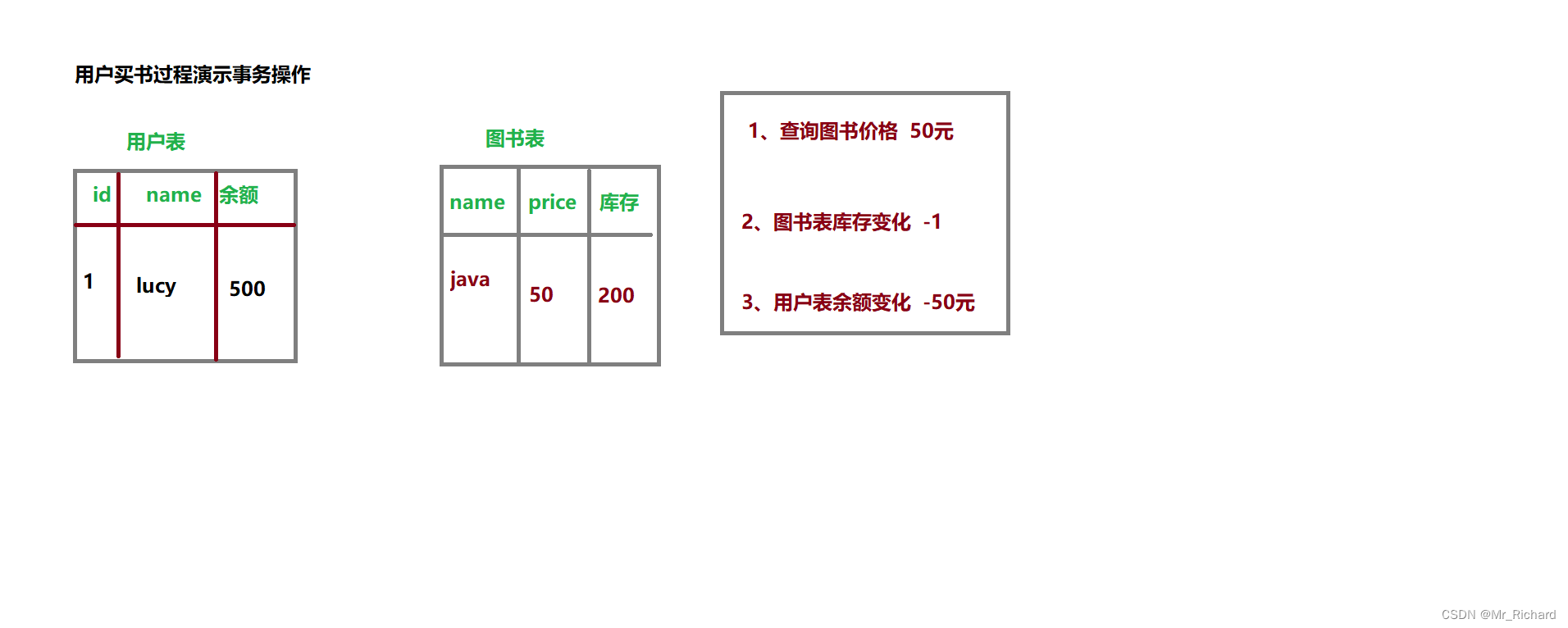
7.3.1 准备工作
①添加配置
在beans.xml添加配置
<!-- 开启组件扫描-->
<context:component-scan base-package="com.atguigu" />
②创建表
CREATE TABLE `t_book` (
`book_id` int(11) NOT NULL AUTO_INCREMENT COMMENT '主键',
`book_name` varchar(20) DEFAULT NULL COMMENT '图书名称',
`price` int(11) DEFAULT NULL COMMENT '价格',
`stock` int(10) unsigned DEFAULT NULL COMMENT '库存(无符号)',
PRIMARY KEY (`book_id`)
) ENGINE=InnoDB AUTO_INCREMENT=3 DEFAULT CHARSET=utf8;
insert into `t_book`(`book_id`,`book_name`,`price`,`stock`) values (1,'斗破苍穹',80,100),(2,'斗罗大陆',50,100);
CREATE TABLE `t_user` (
`user_id` int(11) NOT NULL AUTO_INCREMENT COMMENT '主键',
`username` varchar(20) DEFAULT NULL COMMENT '用户名',
`balance` int(10) unsigned DEFAULT NULL COMMENT '余额(无符号)',
PRIMARY KEY (`user_id`)
) ENGINE=InnoDB AUTO_INCREMENT=2 DEFAULT CHARSET=utf8;
insert into `t_user`(`user_id`,`username`,`balance`) values (1,'admin',500);
③创建组件
创建BookController:
package com.atguigu.tx.controller;
import com.atguigu.tx.service.BookService;
import org.springframework.beans.factory.annotation.Autowired;
import org.springframework.stereotype.Controller;
/**
* @author : Sakura
* @className : BookController
* @description : TODO
* @createTime : 2023-07-24 17:32:27
*/
@Controller
public class BookController {
@Autowired
private BookService bookService;
/**
* 买书方法:传递图书id和用户id
* @param bookId
* @param userId
*/
public void buyBook(Integer bookId, Integer userId){
bookService.buyBook(bookId,userId);
}
}
创建接口BookService:
package com.atguigu.tx.service;
/**
* @author : Sakura
* @className : BookService
* @description : TODO
* @createTime : 2023-07-24 17:32:54
*/
public interface BookService {
void buyBook(Integer bookId, Integer userId);
}
创建实现类BookServiceImpl:
package com.atguigu.tx.service;
import com.atguigu.tx.dao.BookDao;
import org.springframework.beans.factory.annotation.Autowired;
import org.springframework.stereotype.Service;
/**
* @author : Sakura
* @className : BookServiceImpl
* @description : TODO
* @createTime : 2023-07-24 17:33:51
*/
@Service
public class BookServiceImpl implements BookService{
@Autowired
private BookDao bookDao;
@Override
public void buyBook(Integer bookId, Integer userId) {
// 根据图书id查询图书价格
Integer price = bookDao.getBookPriceById(bookId);
// 图书库存量改动:-1
bookDao.updateStock(bookId);
// 更新用户表用户余额
bookDao.updateUserById(userId, price);
}
}
创建接口BookDao:
package com.atguigu.tx.dao;
/**
* @author : Sakura
* @className : BookDao
* @description : TODO
* @createTime : 2023-07-24 17:33:08
*/
public interface BookDao {
Integer getBookPriceById(Integer bookId);
void updateStock(Integer bookId);
void updateUserById(Integer userId, Integer price);
}
创建实现类BookDaoImpl:
package com.atguigu.tx.dao;
import org.springframework.beans.factory.annotation.Autowired;
import org.springframework.jdbc.core.JdbcTemplate;
import org.springframework.stereotype.Repository;
/**
* @author : Sakura
* @className : BookDaoImpl
* @description : TODO
* @createTime : 2023-07-24 17:33:35
*/
@Repository
public class BookDaoImpl implements BookDao{
@Autowired
private JdbcTemplate jdbcTemplate;
/**
* 根据图书id查询图书价格
* @param bookId
* @return
*/
@Override
public Integer getBookPriceById(Integer bookId) {
String sql = "select price from t_book where book_id = ?;";
Integer price = jdbcTemplate.queryForObject(sql, Integer.class, bookId);
return price;
}
/**
* 更新图书库存
* @param bookId
*/
@Override
public void updateStock(Integer bookId) {
String sql = "update t_book set stock = stock -1 where book_id = ?;";
jdbcTemplate.update(sql,bookId);
}
/**
* 更新用户余额
* @param userId
* @param price
*/
@Override
public void updateUserById(Integer userId, Integer price) {
String sql = "update t_user set balance = balance - ? where user_id = ?;";
jdbcTemplate.update(sql,price,userId);
}
}
7.3.2 测试无事务情况
①创建测试类
package com.atguigu.tx;
import com.atguigu.tx.controller.BookController;
import org.junit.jupiter.api.Test;
import org.springframework.beans.factory.annotation.Autowired;
import org.springframework.test.context.junit.jupiter.SpringJUnitConfig;
/**
* @author : Sakura
* @className : TestBookTx
* @description : TODO
* @createTime : 2023-07-24 17:46:41
*/
@SpringJUnitConfig(locations = "classpath:spring-jdbc-tx.xml")
public class TestBookTx {
@Autowired
private BookController bookController;
@Test
public void test(){
bookController.buyBook(1,1);
}
}
②模拟场景
用户购买图书,先查询图书的价格,再更新图书的库存和用户的余额
假设用户id为1的用户,购买id为1的图书
用户余额为50,而图书价格为80
购买图书之后,用户的余额为-30,数据库中余额字段设置了无符号,因此无法将-30插入到余额字段
此时执行sql语句会抛出SQLException
org.springframework.dao.DataIntegrityViolationException: PreparedStatementCallback; SQL [update t_user set balance = balance - ? where user_id = ?;]; Data truncation: BIGINT UNSIGNED value is out of range in '(`springtest`.`t_user`.`balance` - 30)'
③观察结果
因为没有添加事务,图书的库存更新了,但是用户的余额没有更新
显然这样的结果是错误的,购买图书是一个完整的功能,更新库存和更新余额要么都成功要么都失败
7.3.3 加入事务
①添加事务配置
在spring配置文件中引入tx命名空间
<?xml version="1.0" encoding="UTF-8"?>
<beans xmlns="http://www.springframework.org/schema/beans"
xmlns:xsi="http://www.w3.org/2001/XMLSchema-instance"
xmlns:context="http://www.springframework.org/schema/context"
xmlns:tx="http://www.springframework.org/schema/tx"
xsi:schemaLocation="http://www.springframework.org/schema/beans
http://www.springframework.org/schema/beans/spring-beans.xsd
http://www.springframework.org/schema/context
http://www.springframework.org/schema/context/spring-context.xsd
http://www.springframework.org/schema/tx
http://www.springframework.org/schema/tx/spring-tx.xsd">
在Spring的配置文件中添加配置:
<bean id="transactionManager" class="org.springframework.jdbc.datasource.DataSourceTransactionManager">
<property name="dataSource" ref="druidDataSource"></property>
</bean>
<!--
开启事务的注解驱动
通过注解@Transactional所标识的方法或标识的类中所有的方法,都会被事务管理器管理事务
-->
<!-- transaction-manager属性的默认值是transactionManager,如果事务管理器bean的id正好就是这个默认值,则可以省略这个属性 -->
<tx:annotation-driven transaction-manager="transactionManager" />
②添加事务注解
因为service层表示业务逻辑层,一个方法表示一个完成的功能,因此处理事务一般在service层处理
在BookServiceImpl的buybook()添加注解@Transactional
③观察结果
用户余额不足,修改用户余额的操作失败。由于使用了Spring的声明式事务,会进行事务回滚。因此,更新库存和更新余额都没有执行。
7.3.4 @Transactional注解标识的位置
@Transactional标识在方法上,则只会影响该方法
@Transactional标识的类上,则会影响类中所有的方法
7.3.5 事务属性:只读
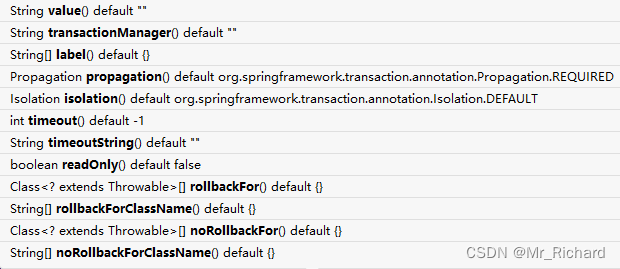
①介绍
对一个查询操作来说,如果我们把它设置成只读,就能够明确告诉数据库,当前执行的操作不涉及写操作。这样数据库就能够针对查询操作来进行优化,其默认值为 false 。
②使用方式
@Transactional(readOnly = true)
public void buyBook(Integer bookId, Integer userId) {
//查询图书的价格
Integer price = bookDao.getPriceByBookId(bookId);
//更新图书的库存
bookDao.updateStock(bookId);
//更新用户的余额
bookDao.updateBalance(userId, price);
//System.out.println(1/0);
}
③注意
对增删改操作设置只读会抛出下面异常:
org.springframework.dao.TransientDataAccessResourceException: PreparedStatementCallback; SQL [update t_book set stock = stock -1 where book_id = ?;]; Connection is read-only. Queries leading to data modification are not allowed
7.3.6 事务属性:超时
①介绍
事务在执行过程中,有可能因为遇到某些问题,导致程序卡住,从而长时间占用数据库资源。而长时间占用资源,大概率是因为程序运行出现了问题(可能是Java程序或MySQL数据库或网络连接等等)。此时这个很可能出问题的程序应该被回滚,撤销它已做的操作,事务结束,把资源让出来,让其他正常程序可以执行。
概括来说就是一句话:超时回滚,释放资源。
②使用方式
//超时时间单位秒
@Transactional(timeout = 3)
public void buyBook(Integer bookId, Integer userId) {
try {
TimeUnit.SECONDS.sleep(5);
} catch (InterruptedException e) {
e.printStackTrace();
}
//查询图书的价格
Integer price = bookDao.getPriceByBookId(bookId);
//更新图书的库存
bookDao.updateStock(bookId);
//更新用户的余额
bookDao.updateBalance(userId, price);
//System.out.println(1/0);
}
③观察结果
执行过程中抛出异常:
org.springframework.transaction.TransactionTimedOutException: Transaction timed out: deadline was Mon Jul 24 19:31:55 CST 2023
7.3.7 事务属性:回滚策略
①介绍
声明式事务默认只针对运行时异常回滚,编译时异常不回滚。
可以通过@Transactional中相关属性设置回滚策略,借此设置某个异常是否回滚,比如设置编译时异常也需要回滚。
-
rollbackFor属性:需要设置一个Class类型的对象
-
rollbackForClassName属性:需要设置一个字符串类型的全类名
-
noRollbackFor属性:需要设置一个Class类型的对象
-
rollbackFor属性:需要设置一个字符串类型的全类名
②使用方式
@Transactional(noRollbackFor = ArithmeticException.class)
//@Transactional(noRollbackForClassName = "java.lang.ArithmeticException")
public void buyBook(Integer bookId, Integer userId) {
//查询图书的价格
Integer price = bookDao.getPriceByBookId(bookId);
//更新图书的库存
bookDao.updateStock(bookId);
//更新用户的余额
bookDao.updateBalance(userId, price);
System.out.println(1/0);
}
③观察结果
虽然购买图书功能中出现了数学运算异常(ArithmeticException),但是我们设置的回滚策略是,当出现ArithmeticException不发生回滚,因此购买图书的操作正常执行
7.3.8 事务属性:隔离级别
①介绍
数据库系统必须具有隔离并发运行各个事务的能力,使它们不会相互影响,避免各种并发问题。一个事务与其他事务隔离的程度称为隔离级别。SQL标准中规定了多种事务隔离级别,不同隔离级别对应不同的干扰程度,隔离级别越高,数据一致性就越好,但并发性越弱。
隔离级别一共有四种:
-
读未提交:READ UNCOMMITTED
允许Transaction01读取Transaction02未提交的修改。
-
读已提交:READ COMMITTED、
要求Transaction01只能读取Transaction02已提交的修改。
-
可重复读:REPEATABLE READ
确保Transaction01可以多次从一个字段中读取到相同的值,即Transaction01执行期间禁止其它事务对这个字段进行更新。
-
串行化:SERIALIZABLE
确保Transaction01可以多次从一个表中读取到相同的行,在Transaction01执行期间,禁止其它事务对这个表进行添加、更新、删除操作。可以避免任何并发问题,但性能十分低下。
各个隔离级别解决并发问题的能力见下表:
| 隔离级别 | 脏读 | 不可重复读 | 幻读 |
|---|---|---|---|
| READ UNCOMMITTED | 有 | 有 | 有 |
| READ COMMITTED | 无 | 有 | 有 |
| REPEATABLE READ | 无 | 无 | 有 |
| SERIALIZABLE | 无 | 无 | 无 |
- 脏读:事务A查询数据后进行了一次修改且未提交,而事务B这个时候去查询,然后使用了这个数据,因为这个数据还没有被事务A 提交到数据库中,所以事务B的得到数据就是脏数据,对脏数据进行操作可能是不正确的。
- 不可重复读: 事务A访问了两次数据,但是这访问第二次之间事务B进行一次并进行了修改,导致事务A访问第二次的时候得到的数据与第一次不同,导致一个事务访问两次数据得到的数据不相同。因此叫做不可重复读
- 幻读: 与不可重复读有点相似,只是这次是事务B在事务A访问第二次的之前做了一个新增,导致事务A第二次读取的时候发现了多的记录,这就是幻读。
各种数据库产品对事务隔离级别的支持程度:
| 隔离级别 | Oracle | MySQL |
|---|---|---|
| READ UNCOMMITTED | × | √ |
| READ COMMITTED | √(默认) | √ |
| REPEATABLE READ | × | √(默认) |
| SERIALIZABLE | √ | √ |
②使用方式
@Transactional(isolation = Isolation.DEFAULT)//使用数据库默认的隔离级别
@Transactional(isolation = Isolation.READ_UNCOMMITTED)//读未提交
@Transactional(isolation = Isolation.READ_COMMITTED)//读已提交
@Transactional(isolation = Isolation.REPEATABLE_READ)//可重复读
@Transactional(isolation = Isolation.SERIALIZABLE)//串行化
7.3.9 事务属性:传播行为
①介绍
什么是事务的传播行为?
在service类中有a()方法和b()方法,a()方法上有事务,b()方法上也有事务,当a()方法执行过程中调用了b()方法,事务是如何传递的?合并到一个事务里?还是开启一个新的事务?这就是事务传播行为。
一共有七种传播行为:
- REQUIRED:支持当前事务,如果不存在就新建一个(默认)【没有就新建,有就加入】
- SUPPORTS:支持当前事务,如果当前没有事务,就以非事务方式执行**【有就加入,没有就不管了】**
- MANDATORY:必须运行在一个事务中,如果当前没有事务正在发生,将抛出一个异常**【有就加入,没有就抛异常】**
- REQUIRES_NEW:开启一个新的事务,如果一个事务已经存在,则将这个存在的事务挂起**【不管有没有,直接开启一个新事务,开启的新事务和之前的事务不存在嵌套关系,之前事务被挂起】**
- NOT_SUPPORTED:以非事务方式运行,如果有事务存在,挂起当前事务**【不支持事务,存在就挂起】**
- NEVER:以非事务方式运行,如果有事务存在,抛出异常**【不支持事务,存在就抛异常】**
- NESTED:如果当前正有一个事务在进行中,则该方法应当运行在一个嵌套式事务中。被嵌套的事务可以独立于外层事务进行提交或回滚。如果外层事务不存在,行为就像REQUIRED一样。【有事务的话,就在这个事务里再嵌套一个完全独立的事务,嵌套的事务可以独立的提交和回滚。没有事务就和REQUIRED一样。】
②测试
创建接口CheckoutService:
package com.atguigu.tx.service;
public interface CheckoutService {
/**
* 买多本书的方法
* @param bookIds
* @param userId
*/
void checkout(Integer[] bookIds, Integer userId);
}
创建实现类CheckoutServiceImpl:
package com.atguigu.tx.service;
import org.springframework.beans.factory.annotation.Autowired;
import org.springframework.stereotype.Service;
import org.springframework.transaction.annotation.Transactional;
/**
* @author : Sakura
* @className : CheckoutServiceImpl
* @description : TODO
* @createTime : 2023-07-24 19:57:48
*/
@Service
public class CheckoutServiceImpl implements CheckoutService{
@Autowired
private BookService bookService;
@Transactional
@Override
public void checkout(Integer[] bookIds, Integer userId) {
for (Integer bookId: bookIds){
bookService.buyBook(bookId,userId);
}
}
}
在BookController中添加方法:
@Autowired
private CheckoutService checkoutService;
/**
* 买多本书方法:传递图书id和用户id
*
* @param bookIds
* @param userId
*/
public void buyBook(Integer[] bookIds, Integer userId) {
checkoutService.checkout(bookIds, userId);
}
单元测试:
@Test
public void test2(){
Integer[] bookIds = new Integer[]{1,2};
bookController.buyBook(bookIds, 1);
}
在数据库中将用户的余额修改为100元
③观察结果
可以通过@Transactional中的propagation属性设置事务传播行为
修改BookServiceImpl中buyBook()上,注解@Transactional的propagation属性
@Transactional(propagation = Propagation.REQUIRED),默认情况,表示如果当前线程上有已经开启的事务可用,那么就在这个事务中运行。经过观察,购买图书的方法buyBook()在checkout()中被调用,checkout()上有事务注解,因此在此事务中执行。所购买的两本图书的价格为80和50,而用户的余额为100,因此在购买第二本图书时余额不足失败,导致整个checkout()回滚,即只要有一本书买不了,就都买不了。
@Transactional(propagation = Propagation.REQUIRES_NEW),表示不管当前线程上是否有已经开启的事务,都要开启新事务。同样的场景,每次购买图书都是在buyBook()的事务中执行,因此第一本图书购买成功,事务结束,第二本图书购买失败,只在第二次的buyBook()中回滚,购买第一本图书不受影响,即能买几本就买几本。因此,再次执行单元测试,用户余额变为20。
7.3.10 全注解配置事务
①添加配置类
package com.atguigu.tx.config;
import com.alibaba.druid.pool.DruidDataSource;
import org.springframework.context.annotation.Bean;
import org.springframework.context.annotation.ComponentScan;
import org.springframework.context.annotation.Configuration;
import org.springframework.jdbc.core.JdbcTemplate;
import org.springframework.jdbc.datasource.DataSourceTransactionManager;
import org.springframework.transaction.annotation.EnableTransactionManagement;
import javax.sql.DataSource;
import java.io.FileInputStream;
import java.io.IOException;
import java.util.Properties;
/**
* @author : Sakura
* @className : SpringConfig
* @description : TODO
* @createTime : 2023-07-24 20:12:16
*/
@Configuration
@ComponentScan("com.atguigu")
@EnableTransactionManagement // 开启事务管理
public class SpringConfig {
/**
* 配置DruidDataSource, 默认bean的id为方法名
* @return
*/
@Bean(name = "druidDataSource")
public DataSource getDataSource(){
Properties properties = new Properties();
try {
properties.load(new FileInputStream("src/main/resources/jdbc.properties"));
} catch (IOException e) {
throw new RuntimeException(e);
}
DruidDataSource druidDataSource = new DruidDataSource();
druidDataSource.setUrl(properties.getProperty("jdbc.url"));
druidDataSource.setUsername(properties.getProperty("jdbc.user"));
druidDataSource.setPassword(properties.getProperty("jdbc.password"));
druidDataSource.setDriverClassName(properties.getProperty("jdbc.driver"));
return druidDataSource;
}
/**
* 配置JdbcTemplate, 默认bean的id为方法名
* @param dataSource
* @return
*/
@Bean(name = "jdbcTemplate")
public JdbcTemplate getJdbcTemplate(DataSource dataSource){
JdbcTemplate jdbcTemplate = new JdbcTemplate();
jdbcTemplate.setDataSource(dataSource);
return jdbcTemplate;
}
/***
* 配置事务管理器, 默认bean的id为方法名
* @param dataSource
* @return
*/
@Bean
public DataSourceTransactionManager dataSourceTransactionManager(DataSource dataSource){
DataSourceTransactionManager manager = new DataSourceTransactionManager();
manager.setDataSource(dataSource);
return manager;
}
}
②测试
package com.atguigu.tx;
import com.atguigu.tx.config.SpringConfig;
import com.atguigu.tx.controller.BookController;
import org.junit.jupiter.api.Test;
import org.springframework.context.ApplicationContext;
import org.springframework.context.annotation.AnnotationConfigApplicationContext;
/**
* @author : Sakura
* @className : TestSpringConfig
* @description : TODO
* @createTime : 2023-07-24 20:25:56
*/
public class TestSpringConfig {
@Test
public void test3() {
ApplicationContext context = new AnnotationConfigApplicationContext(SpringConfig.class);
BookController bc = context.getBean(BookController.class);
bc.buyBook(1,1);
}
}
7.4 基于XML的声明式事务
7.4.1 场景模拟

参考基于注解的声明式事务
7.4.2 修改Spring配置文件
将Spring配置文件中去掉tx:annotation-driven 标签,并添加配置:
<aop:config>
<!-- 配置事务通知和切入点表达式 -->
<aop:advisor advice-ref="txAdvice" pointcut="execution(* com.atguigu.spring.tx.xml.service.impl.*.*(..))"></aop:advisor>
</aop:config>
<!-- tx:advice标签:配置事务通知 -->
<!-- id属性:给事务通知标签设置唯一标识,便于引用 -->
<!-- transaction-manager属性:关联事务管理器 -->
<tx:advice id="txAdvice" transaction-manager="transactionManager">
<tx:attributes>
<!-- tx:method标签:配置具体的事务方法 -->
<!-- name属性:指定方法名,可以使用星号代表多个字符 -->
<tx:method name="get*" read-only="true"/>
<tx:method name="query*" read-only="true"/>
<tx:method name="find*" read-only="true"/>
<!-- read-only属性:设置只读属性 -->
<!-- rollback-for属性:设置回滚的异常 -->
<!-- no-rollback-for属性:设置不回滚的异常 -->
<!-- isolation属性:设置事务的隔离级别 -->
<!-- timeout属性:设置事务的超时属性 -->
<!-- propagation属性:设置事务的传播行为 -->
<tx:method name="save*" read-only="false" rollback-for="java.lang.Exception" propagation="REQUIRES_NEW"/>
<tx:method name="update*" read-only="false" rollback-for="java.lang.Exception" propagation="REQUIRES_NEW"/>
<tx:method name="delete*" read-only="false" rollback-for="java.lang.Exception" propagation="REQUIRES_NEW"/>
</tx:attributes>
</tx:advice>
注意:基于xml实现的声明式事务,必须引入aspectJ的依赖
<dependency> <groupId>org.springframework</groupId> <artifactId>spring-aspects</artifactId> <version>6.0.11</version> </dependency>
8 资源操作:Resources
8.1 Spring Resources概述


Java的标准java.net.URL类和各种URL前缀的标准处理程序无法满足所有对low-level资源的访问,比如:没有标准化的 URL 实现可用于访问需要从类路径或相对于 ServletContext 获取的资源。并且缺少某些Spring所需要的功能,例如检测某资源是否存在等。而Spring的Resource声明了访问low-level资源的能力。
8.2 Resource接口
Spring 的 Resource 接口位于 org.springframework.core.io 中。 旨在成为一个更强大的接口,用于抽象对低级资源的访问。以下显示了Resource接口定义的方法
public interface Resource extends InputStreamSource {
boolean exists();
boolean isReadable();
boolean isOpen();
boolean isFile();
URL getURL() throws IOException;
URI getURI() throws IOException;
File getFile() throws IOException;
ReadableByteChannel readableChannel() throws IOException;
long contentLength() throws IOException;
long lastModified() throws IOException;
Resource createRelative(String relativePath) throws IOException;
String getFilename();
String getDescription();
}
Resource接口继承了InputStreamSource接口,提供了很多InputStreamSource所没有的方法。InputStreamSource接口,只有一个方法:
public interface InputStreamSource {
InputStream getInputStream() throws IOException;
}
其中一些重要的方法:
getInputStream(): 找到并打开资源,返回一个InputStream以从资源中读取。预计每次调用都会返回一个新的InputStream(),调用者有责任关闭每个流
exists(): 返回一个布尔值,表明某个资源是否以物理形式存在
isOpen: 返回一个布尔值,指示此资源是否具有开放流的句柄。如果为true,InputStream就不能够多次读取,只能够读取一次并且及时关闭以避免内存泄漏。对于所有常规资源实现,返回false,但是InputStreamResource除外。
getDescription(): 返回资源的描述,用来输出错误的日志。这通常是完全限定的文件名或资源的实际URL。
其他方法:
isReadable(): 表明资源的目录读取是否通过getInputStream()进行读取。
isFile(): 表明这个资源是否代表了一个文件系统的文件。
getURL(): 返回一个URL句柄,如果资源不能够被解析为URL,将抛出IOException
getURI(): 返回一个资源的URI句柄
getFile(): 返回某个文件,如果资源不能够被解析称为绝对路径,将会抛出FileNotFoundException
lastModified(): 资源最后一次修改的时间戳
createRelative(): 创建此资源的相关资源
getFilename(): 资源的文件名是什么 例如:最后一部分的文件名 myfile.txt
8.3 Resource的实现类
Resource 接口是 Spring 资源访问策略的抽象,它本身并不提供任何资源访问实现,具体的资源访问由该接口的实现类完成——每个实现类代表一种资源访问策略。Resource一般包括这些实现类:UrlResource、ClassPathResource、FileSystemResource、ServletContextResource、InputStreamResource、ByteArrayResource
8.3.1 UrlResource访问网络资源
Resource的一个实现类,用来访问网络资源,它支持URL的绝对路径。
http:------该前缀用于访问基于HTTP协议的网络资源。
ftp:------该前缀用于访问基于FTP协议的网络资源
file: ------该前缀用于从文件系统中读取资源
实验:访问基于HTTP协议的网络资源
创建一个maven子模块spring6-resources,配置Spring依赖(参考前面)
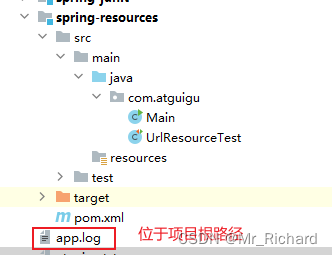
package com.atguigu;
import org.junit.jupiter.api.Test;
import org.springframework.core.io.UrlResource;
import java.io.IOException;
import java.net.MalformedURLException;
/**
* @author : Sakura
* @className : UrlResourceTest
* @description : 演示UrlResource
* @createTime : 2023-07-24 21:16:20
*/
public class UrlResourceTest {
/**
* 访问http等资源
*/
@Test
public void testUrlResourc(){
String path = "http://www.baidu.com";
try {
// 创建Resources接口的实现类
UrlResource urlResource = new UrlResource(path);
// 获取资源信息
System.out.println(urlResource.getURL());
System.out.println(urlResource.getFilename());
System.out.println(urlResource.getDescription());
System.out.println(urlResource.getInputStream().read());
} catch (IOException e) {
throw new RuntimeException(e);
}
}
}
实验二:在项目根路径下创建文件,从文件系统中读取资源
方法不变,修改调用传递路径
@Test
public void testUrlResourc(){
String path = "file:../app.log";
try {
// 创建Resources接口的实现类
UrlResource urlResource = new UrlResource(path);
// 获取资源信息
System.out.println(urlResource.getURL());
System.out.println(urlResource.getFilename());
System.out.println(urlResource.getDescription());
System.out.println(urlResource.getInputStream().read());
} catch (IOException e) {
throw new RuntimeException(e);
}
}
**相对路径:**相对于
项目目录的路径,这是一个便捷的路径,开发中经常使用。
- IDEA中,main中的文件的相对路径,是相对于"
当前工程"- IDEA中,单元测试方法中的文件的相对路径,是相对于"
当前module"
8.3.2 ClassPathResource 访问类路径下资源
ClassPathResource 用来访问类加载路径下的资源,相对于其他的 Resource 实现类,其主要优势是方便访问类加载路径里的资源,尤其对于 Web 应用,ClassPathResource 可自动搜索位于 classes 下的资源文件,无须使用绝对路径访问。
实验:在类路径下创建文件atguigu.txt,使用ClassPathResource 访问
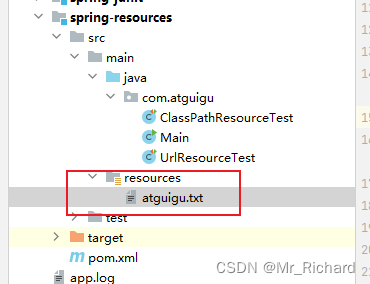
package com.atguigu;
import org.junit.jupiter.api.Test;
import org.springframework.core.io.ClassPathResource;
import java.io.IOException;
import java.io.InputStream;
/**
* @author : Sakura
* @className : ClassPathResourceTest
* @description : TODO
* @createTime : 2023-07-24 21:30:17
*/
public class ClassPathResourceTest {
@Test
public void test() {
String path = "atguigu.txt";
try {
ClassPathResource classPathResource = new ClassPathResource(path);
// 获取资源信息
System.out.println(classPathResource.getFilename());
System.out.println(classPathResource.getDescription());
InputStream inputStream = classPathResource.getInputStream();
byte[] bytes = new byte[1024];
int len;
while ((len = inputStream.read(bytes)) != -1) {
System.out.print(new String(bytes, 0, len));
}
} catch (IOException e) {
throw new RuntimeException(e);
}
}
}
ClassPathResource实例可使用ClassPathResource构造器显式地创建,但更多的时候它都是隐式地创建的。当执行Spring的某个方法时,该方法接受一个代表资源路径的字符串参数,当Spring识别该字符串参数中包含classpath:前缀后,系统会自动创建ClassPathResource对象。
8.3.3 FileSystemResource 访问文件系统资源
Spring 提供的 FileSystemResource 类用于访问文件系统资源,使用 FileSystemResource 来访问文件系统资源并没有太大的优势,因为 Java 提供的 File 类也可用于访问文件系统资源。
实验:使用FileSystemResource 访问文件系统资源
package com.atguigu;
import org.junit.jupiter.api.Test;
import org.springframework.core.io.FileSystemResource;
import java.io.IOException;
import java.io.InputStream;
/**
* @author : Sakura
* @className : FileSystemResource
* @description : TODO
* @createTime : 2023-07-24 21:39:56
*/
public class FileSystemResourceTest {
/**
* 访问文件系统中的资源
*/
@Test
public void test() {
// 绝对路径
// String path = "D:\Programming\java\code\Spring6Projects\Spring6\Spring6\spring-resources\target\classes\atguigu.txt";
// 相对路径: 单元测试时在当前module下
String path = "src/main/resources/atguigu.txt";
try {
FileSystemResource resource = new FileSystemResource(path);
// 获取资源信息
System.out.println(resource.getFilename());
System.out.println(resource.getDescription());
InputStream inputStream = resource.getInputStream();
byte[] bytes = new byte[1024];
int len;
while ((len = inputStream.read(bytes)) != -1) {
System.out.print(new String(bytes, 0, len));
}
} catch (IOException e) {
throw new RuntimeException(e);
}
}
}
FileSystemResource实例可使用FileSystemResource构造器显示地创建,但更多的时候它都是隐式创建。执行Spring的某个方法时,该方法接受一个代表资源路径的字符串参数,当Spring识别该字符串参数中包含file:前缀后,系统将会自动创建FileSystemResource对象。
8.3.4 ServletContextResource
这是ServletContext资源的Resource实现,它解释相关Web应用程序根目录中的相对路径。它始终支持流(stream)访问和URL访问,但只有在扩展Web应用程序存档且资源实际位于文件系统上时才允许java.io.File访问。无论它是在文件系统上扩展还是直接从JAR或其他地方(如数据库)访问,实际上都依赖于Servlet容器。
8.3.5 InputStreamResource
InputStreamResource 是给定的输入流(InputStream)的Resource实现。它的使用场景在没有特定的资源实现的时候使用(感觉和@Component 的适用场景很相似)。与其他Resource实现相比,这是已打开资源的描述符。 因此,它的isOpen()方法返回true。如果需要将资源描述符保留在某处或者需要多次读取流,请不要使用它。
8.3.6 ByteArrayResource
字节数组的Resource实现类。通过给定的数组创建了一个ByteArrayInputStream。它对于从任何给定的字节数组加载内容非常有用,而无需求助于单次使用的InputStreamResource。
8.4 Resource类图
上述Resource实现类与Resource顶级接口之间的关系可以用下面的UML关系模型来表示

8.5 ResourceLoader 接口
8.5.1 ResourceLoader 概述
Spring 提供如下两个标志性接口:
(1)ResourceLoader : 该接口实现类的实例可以获得一个Resource实例。
(2) ResourceLoaderAware : 该接口实现类的实例将获得一个ResourceLoader的引用。
在ResourceLoader接口里有如下方法:
(1)Resource getResource(String location) : 该接口仅有这个方法,用于返回一个Resource实例。ApplicationContext实现类都实现ResourceLoader接口,因此ApplicationContext可直接获取Resource实例。
8.5.2 使用演示
实验一:ClassPathXmlApplicationContext获取Resource实例
@Test
public void test(){
/**
* 通过ApplicationContext访问资源ApplicationContext实例获取Resource实例时,
* 默认采用与ApplicationContext相同的资源访问策略
*/
ApplicationContext applicationContext = new ClassPathXmlApplicationContext();
Resource resource = applicationContext.getResource("atguigu.txt");
System.out.println(resource.getFilename());
System.out.println(resource);
}
实验二:FileSystemApplicationContext获取Resource实例
@Test
public void test2(){
ApplicationContext ctx = new FileSystemXmlApplicationContext();
Resource res = ctx.getResource("atguigu.txt");
System.out.println(res.getFilename());
System.out.println(res);
}
8.5.3 ResourceLoader 总结
Spring将采用和ApplicationContext相同的策略来访问资源。也就是说,如果ApplicationContext是FileSystemXmlApplicationContext,res就是FileSystemResource实例;如果ApplicationContext是ClassPathXmlApplicationContext,res就是ClassPathResource实例
当Spring应用需要进行资源访问时,实际上并不需要直接使用Resource实现类,而是调用ResourceLoader实例的getResource()方法来获得资源,ReosurceLoader将会负责选择Reosurce实现类,也就是确定具体的资源访问策略,从而将应用程序和具体的资源访问策略分离开来
另外,使用ApplicationContext访问资源时,可通过不同前缀指定强制使用指定的ClassPathResource、FileSystemResource等实现类
Resource res = ctx.getResource("calsspath:bean.xml");
Resrouce res = ctx.getResource("file:bean.xml");
Resource res = ctx.getResource("http://localhost:8080/beans.xml");
8.6 ResourceLoaderAware 接口
ResourceLoaderAware接口实现类的实例将获得一个ResourceLoader的引用,ResourceLoaderAware接口也提供了一个setResourceLoader()方法,该方法将由Spring容器负责调用,Spring容器会将一个ResourceLoader对象作为该方法的参数传入。
如果把实现ResourceLoaderAware接口的Bean类部署在Spring容器中,Spring容器会将自身当成ResourceLoader作为setResourceLoader()方法的参数传入。由于ApplicationContext的实现类都实现了ResourceLoader接口,Spring容器自身完全可作为ResorceLoader使用。也就是说,Spring容器既是一个ApplicationContext,又是一个ResourceLoader,这可以使我们通过借助实现ResourceLoaderAware接口实现对文件的读取。
实验:演示ResourceLoaderAware使用
第一步 创建类,实现ResourceLoaderAware接口
package com.atguigu.resourceloaderaware;
import org.springframework.context.ResourceLoaderAware;
import org.springframework.core.io.ResourceLoader;
/**
* @author : Sakura
* @className : MyResourceLoaderAware
* @description : 创建类,实现ResourceLoaderAware接口
* @createTime : 2023-07-25 10:29:29
*/
public class MyResourceLoaderAware implements ResourceLoaderAware {
private ResourceLoader resourceLoader;
@Override
public void setResourceLoader(ResourceLoader resourceLoader) {
this.resourceLoader = resourceLoader;
}
public ResourceLoader getResourceLoader() {
return resourceLoader;
}
}
第二步 创建bean.xml文件,配置myResourceLoaderAware
<?xml version="1.0" encoding="UTF-8"?>
<beans xmlns="http://www.springframework.org/schema/beans"
xmlns:xsi="http://www.w3.org/2001/XMLSchema-instance"
xsi:schemaLocation="http://www.springframework.org/schema/beans http://www.springframework.org/schema/beans/spring-beans.xsd">
<bean id="myResourceLoaderAware" class="com.atguigu.resourceloaderaware.MyResourceLoaderAware" />
</beans>
第三步 测试
package com.atguigu.resourceloaderaware;
import org.springframework.context.ApplicationContext;
import org.springframework.context.support.ClassPathXmlApplicationContext;
import org.springframework.core.io.ResourceLoader;
/**
* @author : Sakura
* @className : Test
* @description : TODO
* @createTime : 2023-07-25 10:31:45
*/
public class Test
{
public static void main(String[] args) {
// Spring容器会将一个ResourceLoader对象作为该方法的参数传入
ApplicationContext context = new ClassPathXmlApplicationContext("bean.xml");
MyResourceLoaderAware myResourceLoaderAware = context.getBean("myResourceLoaderAware", MyResourceLoaderAware.class);
// 获取ResourceLoader对象
ResourceLoader resourceLoader = myResourceLoaderAware.getResourceLoader();
System.out.println(context == resourceLoader); // true
}
}
8.7 使用Resource 作为属性
前面介绍了 Spring 提供的资源访问策略,但这些依赖访问策略要么需要使用 Resource 实现类,要么需要使用 ApplicationContext 来获取资源。实际上,当应用程序中的 Bean 实例需要访问资源时,Spring 有更好的解决方法:直接利用依赖注入。从这个意义上来看,Spring 框架不仅充分利用了策略模式来简化资源访问,而且还将策略模式和 IoC 进行充分地结合,最大程度地简化了 Spring 资源访问。
归纳起来,如果 Bean 实例需要访问资源,有如下两种解决方案:
- 代码中获取 Resource 实例。
- 使用依赖注入。
对于第一种方式,当程序获取 Resource 实例时,总需要提供 Resource 所在的位置,不管通过 FileSystemResource 创建实例,还是通过 ClassPathResource 创建实例,或者通过 ApplicationContext 的 getResource() 方法获取实例,都需要提供资源位置。这意味着:资源所在的物理位置将被耦合到代码中,如果资源位置发生改变,则必须改写程序。因此,通常建议采用第二种方法,让 Spring 为 Bean 实例依赖注入资源,来达到解耦的目的。
实验:让Spring为Bean实例依赖注入资源
第一步 创建依赖注入类,定义属性和方法
package com.atguigu.di;
import org.springframework.core.io.Resource;
/**
* @author : Sakura
* @className : ResourceBean
* @description : 使用xml方式实现Resource的依赖注入
* @createTime : 2023-07-25 10:40:52
*/
public class ResourceBean {
private Resource resource;
public Resource getResource() {
return resource;
}
public void setResource(Resource resource) {
this.resource = resource;
}
public void parse() {
System.out.println(resource.getFilename() + ", " + resource.getDescription());
}
}
第二步 创建spring配置文件,配置依赖注入
测试的atguigu.txt防止resources文件夹下
<?xml version="1.0" encoding="UTF-8"?>
<beans xmlns="http://www.springframework.org/schema/beans"
xmlns:xsi="http://www.w3.org/2001/XMLSchema-instance"
xsi:schemaLocation="http://www.springframework.org/schema/beans http://www.springframework.org/schema/beans/spring-beans.xsd">
<bean class="com.atguigu.di.ResourceBean" id="resourceBean">
<!-- 可以使用file:、http:、ftp:等前缀强制Spring采用对应的资源访问策略 -->
<!-- 如果不采用任何前缀,则Spring将采用与该ApplicationContext相同的资源访问策略来访问资源 -->
<property name="resource" value="classpath:atguigu.txt"/>
</bean>
</beans>
第三步 测试
package com.atguigu.di;
import org.springframework.context.ApplicationContext;
import org.springframework.context.support.ClassPathXmlApplicationContext;
/**
* @author : Sakura
* @className : TestResourceBean
* @description : TODO
* @createTime : 2023-07-25 10:44:06
*/
public class TestResourceBean {
public static void main(String[] args) {
ApplicationContext context = new ClassPathXmlApplicationContext("bean-di.xml");
ResourceBean bean = context.getBean(ResourceBean.class);
bean.parse(); // atguigu.txt, class path resource [atguigu.txt]
}
}
8.8 应用程序上下文和资源路径
8.8.1 概述
不管以怎样的方式创建ApplicationContext实例,都需要为ApplicationContext指定配置文件,Spring允许使用一份或多分XML配置文件。当程序创建ApplicationContext实例时,通常也是以Resource的方式来访问配置文件的,所以ApplicationContext完全支持ClassPathResource、FileSystemResource、ServletContextResource等资源访问方式。
ApplicationContext确定资源访问策略通常有两种方法:
(1)使用ApplicationContext实现类指定访问策略。
(2)使用前缀指定访问策略。
8.8.2 ApplicationContext实现类指定访问策略
创建ApplicationContext对象时,通常可以使用如下实现类:
(1) ClassPathXMLApplicationContext : 对应使用ClassPathResource进行资源访问。
(2)FileSystemXmlApplicationContext : 对应使用FileSystemResource进行资源访问。
(3)XmlWebApplicationContext : 对应使用ServletContextResource进行资源访问。
当使用ApplicationContext的不同实现类时,就意味着Spring使用响应的资源访问策略。
效果前面8.5.2节已经演示
8.8.3 使用前缀指定访问策略
实验一:classpath前缀使用
当使用classpath:前缀来指定XML配置文件时,系统将搜索类加载路径,找到第一个匹配的文件
package com.atguigu.spring6.context;
import org.springframework.context.ApplicationContext;
import org.springframework.context.support.FileSystemXmlApplicationContext;
import org.springframework.core.io.Resource;
public class Demo1 {
public static void main(String[] args) {
/*
* 通过搜索文件系统路径下的xml文件创建ApplicationContext,
* 但通过指定classpath:前缀强制搜索类加载路径
* classpath:bean.xml
* */
ApplicationContext ctx =
new ClassPathXmlApplicationContext("classpath:bean.xml");
System.out.println(ctx);
Resource resource = ctx.getResource("atguigu.txt");
System.out.println(resource.getFilename());
System.out.println(resource.getDescription());
}
}
实验二:classpath通配符使用
classpath * :前缀提供了加载多个XML配置文件的能力,当使用classpath*:前缀来指定XML配置文件时,系统将搜索类加载路径,找到所有与文件名匹配的文件,分别加载文件中的配置定义,最后合并成一个ApplicationContext。
ApplicationContext ctx = new ClassPathXmlApplicationContext("classpath*:bean.xml");
System.out.println(ctx);
当使用classpath * :前缀时,Spring将会搜索类加载路径下所有满足该规则的配置文件。
如果不是采用classpath * :前缀,而是改为使用classpath:前缀,Spring则只加载第一个符合条件的XML文件
注意 :
classpath * : 前缀仅对ApplicationContext有效。实际情况是,创建ApplicationContext时,分别访问多个配置文件(通过ClassLoader的getResource方法实现)。因此,classpath * :前缀不可用于Resource。
使用三:通配符其他使用
一次性加载多个配置文件的方式:指定配置文件时使用通配符
ApplicationContext ctx = new ClassPathXmlApplicationContext("classpath:bean*.xml");
Spring允许将classpath*:前缀和通配符结合使用:
ApplicationContext ctx = new ClassPathXmlApplicationContext("classpath*:bean*.xml");
9 国际化:i18n

9.1 i18n概述
国际化也称作i18n,其来源是英文单词 internationalization的首末字符i和n,18为中间的字符数。由于软件发行可能面向多个国家,对于不同国家的用户,软件显示不同语言的过程就是国际化。通常来讲,软件中的国际化是通过配置文件来实现的,假设要支撑两种语言,那么就需要两个版本的配置文件。
9.2 Java国际化
(1)Java自身是支持国际化的,java.util.Locale用于指定当前用户所属的语言环境等信息,java.util.ResourceBundle用于查找绑定对应的资源文件。Locale包含了language信息和country信息,Locale创建默认locale对象时使用的静态方法:
/**
* This method must be called only for creating the Locale.*
* constants due to making shortcuts.
*/
private static Locale createConstant(String lang, String country) {
BaseLocale base = BaseLocale.createInstance(lang, country);
return getInstance(base, null);
}
(2)配置文件命名规则:
basename_language_country.properties
必须遵循以上的命名规则,java才会识别。其中,basename是必须的,语言和国家是可选的。这里存在一个优先级概念,如果同时提供了messages.properties和messages_zh_CN.propertes两个配置文件,如果提供的locale符合en_CN,那么优先查找messages_en_CN.propertes配置文件,如果没查找到,再查找messages.properties配置文件。最后,提示下,所有的配置文件必须放在classpath中,一般放在resources目录下
(3)实验:演示Java国际化
第一步 创建子模块spring6-i18n,引入spring依赖
第二步 在resource目录下创建两个配置文件:messages_zh_CN.propertes和messages_en_GB.propertes
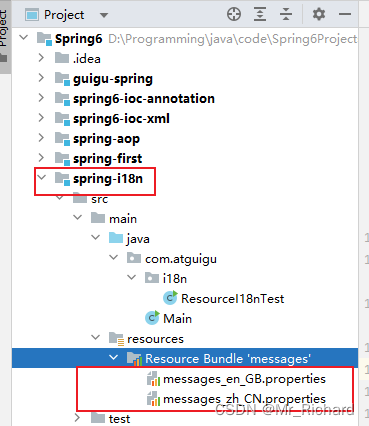
第三步 测试
package com.atguigu.i18n;
import java.util.Locale;
import java.util.ResourceBundle;
/**
* @author : Sakura
* @className : ResourceI18nTest
* @description : TODO
* @createTime : 2023-07-25 11:02:41
*/
public class ResourceI18nTest {
public static void main(String[] args) {
/**
* java.util.Locale用于指定当前用户所属的语言环境等信息,java.util.ResourceBundle用于查找绑定对应的资源文件。
*/
ResourceBundle bundle = ResourceBundle.getBundle("messages", new Locale("zh", "CN"));
String val1 = bundle.getString("test");
System.out.println(val1);
ResourceBundle bundle2 = ResourceBundle.getBundle("messages", new Locale("en", "GB"));
String val2 = bundle2.getString("test");
System.out.println(val2);
}
}
9.3 Spring6国际化
9.3.1 MessageSource接口
spring中国际化是通过MessageSource这个接口来支持的
常见实现类
ResourceBundleMessageSource
这个是基于Java的ResourceBundle基础类实现,允许仅通过资源名加载国际化资源
ReloadableResourceBundleMessageSource
这个功能和第一个类的功能类似,多了定时刷新功能,允许在不重启系统的情况下,更新资源的信息
StaticMessageSource
它允许通过编程的方式提供国际化信息,一会我们可以通过这个来实现db中存储国际化信息的功能。
9.3.2 使用Spring6国际化
第一步 创建资源文件
国际化文件命名格式:基本名称 _ 语言 _ 国家.properties
{0},{1}这样内容,就是动态参数

(1)创建atguigu_en_US.properties
wwww.atguigu.com=welcome {0}, at {1}
(2)创建atguigu_zh_CN.properties
www.atguigu.com=欢迎 {0},时间:{1}
第二步 创建spring配置文件,配置MessageSource
<?xml version="1.0" encoding="UTF-8"?>
<beans xmlns="http://www.springframework.org/schema/beans"
xmlns:xsi="http://www.w3.org/2001/XMLSchema-instance"
xsi:schemaLocation="http://www.springframework.org/schema/beans http://www.springframework.org/schema/beans/spring-beans.xsd">
<bean id="messageSource"
class="org.springframework.context.support.ResourceBundleMessageSource">
<property name="basenames">
<list>
<value>atguigu</value>
</list>
</property>
<property name="defaultEncoding">
<value>utf-8</value>
</property>
</bean>
</beans>
第三步 创建测试类
package com.atguigu.spring6.javai18n;
import org.springframework.context.ApplicationContext;
import org.springframework.context.annotation.AnnotationConfigApplicationContext;
import org.springframework.context.support.ClassPathXmlApplicationContext;
import java.util.Date;
import java.util.Locale;
public class Demo2 {
public static void main(String[] args) {
ApplicationContext context = new ClassPathXmlApplicationContext("beans.xml");
//传递动态参数,使用数组形式对应{0} {1}顺序
Object[] objs = new Object[]{"atguigu",new Date().toString()};
//www.atguigu.com为资源文件的key值,
//objs为资源文件value值所需要的参数,Local.CHINA为国际化为语言
String str=context.getMessage("www.atguigu.com", objs, Locale.CHINA);
System.out.println(str);
}
}
10 数据校验:Validation

10.1 Spring Validation概述

在开发中,我们经常遇到参数校验的需求,比如用户注册的时候,要校验用户名不能为空、用户名长度不超过20个字符、手机号是合法的手机号格式等等。如果使用普通方式,我们会把校验的代码和真正的业务处理逻辑耦合在一起,而且如果未来要新增一种校验逻辑也需要在修改多个地方。而spring validation允许通过注解的方式来定义对象校验规则,把校验和业务逻辑分离开,让代码编写更加方便。Spring Validation其实就是对Hibernate Validator进一步的封装,方便在Spring中使用。
在Spring中有多种校验的方式
第一种是通过实现org.springframework.validation.Validator接口,然后在代码中调用这个类
第二种是按照Bean Validation方式来进行校验,即通过注解的方式。
第三种是基于方法实现校验
除此之外,还可以实现自定义校验
10.2 实验一:通过Validator接口实现
第一步 创建子模块 spring6-validator

第二步 引入相关依赖
<dependencies>
<!-- https://mvnrepository.com/artifact/org.hibernate.validator/hibernate-validator -->
<dependency>
<groupId>org.hibernate.validator</groupId>
<artifactId>hibernate-validator</artifactId>
<version>7.0.5.Final</version>
</dependency>
<!-- https://mvnrepository.com/artifact/org.glassfish/jakarta.el -->
<dependency>
<groupId>org.glassfish</groupId>
<artifactId>jakarta.el</artifactId>
<version>4.0.1</version>
<scope>test</scope>
</dependency>
</dependencies>
第三步 创建实体类,定义属性和方法
package com.atguigu.spring6.validation.method1;
public class Person {
private String name;
private int age;
public String getName() {
return name;
}
public void setName(String name) {
this.name = name;
}
public int getAge() {
return age;
}
public void setAge(int age) {
this.age = age;
}
}
第四步 创建类实现Validator接口,实现接口方法指定校验规则
package com.atguigu.one;
import org.springframework.validation.Errors;
import org.springframework.validation.ValidationUtils;
import org.springframework.validation.Validator;
/**
* @author : Sakura
* @className : PersonValidator
* @description : TODO
* @createTime : 2023-07-25 15:04:40
*/
public class PersonValidator implements Validator {
/**
* supports方法用来表示此校验用在哪个类型上
*
* @param clazz the {@link Class} that this {@link Validator} is
* being asked if it can {@link #validate(Object, Errors) validate}
* @return
*/
@Override
public boolean supports(Class<?> clazz) {
return Person.class.equals(clazz);
}
/**
* validate是设置校验逻辑的地点
* 其中ValidationUtils,是Spring封装的校验工具类,帮助快速实现校验。
*
* @param target the object that is to be validated
* @param errors contextual state about the validation process
*/
@Override
public void validate(Object target, Errors errors) {
// name不能为空
ValidationUtils.rejectIfEmpty(errors, "name", "name.empty", "name is null");
// age不能小于0,不能大于120
Person p = (Person) target;
if (p.getAge() < 0) {
errors.rejectValue("age", "age.value.error", "age < 0");
} else if (p.getAge() > 120){
errors.rejectValue("age", "age.value.old", "age > 120");
}
}
}
上面定义的类,其实就是实现接口中对应的方法,
supports方法用来表示此校验用在哪个类型上,
validate是设置校验逻辑的地点,其中ValidationUtils,是Spring封装的校验工具类,帮助快速实现校验。
第五步 使用上述Validator进行测试
package com.atguigu.one;
import org.springframework.validation.BindingResult;
import org.springframework.validation.DataBinder;
/**
* @author : Sakura
* @className : PersonTest
* @description : TODO
* @createTime : 2023-07-25 15:12:01
*/
public class PersonTest {
public static void main(String[] args) {
//创建person对象
Person person = new Person();
person.setName("");
person.setAge(-1);
// 创建Person对应的DataBinder
DataBinder binder = new DataBinder(person);
// 设置校验
binder.setValidator(new PersonValidator());
// 由于Person对象中的属性为空,所以校验不通过
binder.validate();
//输出结果
BindingResult results = binder.getBindingResult();
System.out.println(results.getAllErrors());
}
}
输出结果:
[Field error in object 'target' on field 'name': rejected value []; codes [name.empty.target.name,name.empty.name,name.empty.java.lang.String,name.empty]; arguments []; default message [name is null], Field error in object 'target' on field 'age': rejected value [-1]; codes [age.value.error.target.age,age.value.error.age,age.value.error.java.lang.Integer,age.value.error]; arguments []; default message [age < 0]]
10.3 实验二:Bean Validation注解实现
使用Bean Validation校验方式,就是如何将Bean Validation需要使用的javax.validation.ValidatorFactory 和javax.validation.Validator注入到容器中。spring默认有一个实现类LocalValidatorFactoryBean,它实现了上面Bean Validation中的接口,并且也实现了org.springframework.validation.Validator接口。
第一步 创建配置类,配置LocalValidatorFactoryBean
@Configuration
@ComponentScan("com.atguigu.spring6.validation.method2")
public class ValidationConfig {
@Bean
public LocalValidatorFactoryBean validator() {
return new LocalValidatorFactoryBean();
}
}
第二步 创建实体类,使用注解定义校验规则
package com.atguigu.spring6.validation.method2;
import jakarta.validation.constraints.Max;
import jakarta.validation.constraints.Min;
import jakarta.validation.constraints.NotNull;
public class User {
@NotNull
private String name;
@Min(0)
@Max(120)
private int age;
public String getName() {
return name;
}
public void setName(String name) {
this.name = name;
}
public int getAge() {
return age;
}
public void setAge(int age) {
this.age = age;
}
}
常用注解说明
@NotNull 限制必须不为null
@NotEmpty 只作用于字符串类型,字符串不为空,并且长度不为0
@NotBlank 只作用于字符串类型,字符串不为空,并且trim()后不为空串
@DecimalMax(value) 限制必须为一个不大于指定值的数字
@DecimalMin(value) 限制必须为一个不小于指定值的数字
@Max(value) 限制必须为一个不大于指定值的数字
@Min(value) 限制必须为一个不小于指定值的数字
@Pattern(value) 限制必须符合指定的正则表达式
@Size(max,min) 限制字符长度必须在min到max之间
@Email 验证注解的元素值是Email,也可以通过正则表达式和flag指定自定义的email格式
第三步 使用两种不同的校验器实现
(1)使用jakarta.validation.Validator校验
package com.atguigu.spring6.validation.method2;
import jakarta.validation.ConstraintViolation;
import jakarta.validation.Validator;
import org.springframework.beans.factory.annotation.Autowired;
import org.springframework.stereotype.Service;
import java.util.Set;
@Service
public class MyService1 {
@Autowired
private Validator validator;
public boolean validator(User user){
Set<ConstraintViolation<User>> sets = validator.validate(user);
return sets.isEmpty();
}
}
(2)使用org.springframework.validation.Validator校验
package com.atguigu.spring6.validation.method2;
import org.springframework.beans.factory.annotation.Autowired;
import org.springframework.stereotype.Service;
import org.springframework.validation.BindException;
import org.springframework.validation.Validator;
@Service
public class MyService2 {
@Autowired
private Validator validator;
public boolean validaPersonByValidator(User user) {
BindException bindException = new BindException(user, user.getName());
validator.validate(user, bindException);
return bindException.hasErrors();
}
}
第四步 测试
package com.atguigu.spring6.validation.method2;
import org.junit.jupiter.api.Test;
import org.springframework.context.ApplicationContext;
import org.springframework.context.annotation.AnnotationConfigApplicationContext;
public class TestMethod2 {
@Test
public void testMyService1() {
ApplicationContext context = new AnnotationConfigApplicationContext(ValidationConfig.class);
MyService1 myService = context.getBean(MyService1.class);
User user = new User();
user.setAge(-1);
boolean validator = myService.validator(user);
System.out.println(validator);
}
@Test
public void testMyService2() {
ApplicationContext context = new AnnotationConfigApplicationContext(ValidationConfig.class);
MyService2 myService = context.getBean(MyService2.class);
User user = new User();
user.setName("lucy");
user.setAge(130);
user.setAge(-1);
boolean validator = myService.validaPersonByValidator(user);
System.out.println(validator);
}
}
10.4 实验三:基于方法实现校验
第一步 创建配置类,配置MethodValidationPostProcessor
package com.atguigu.spring6.validation.method3;
import org.springframework.context.annotation.Bean;
import org.springframework.context.annotation.ComponentScan;
import org.springframework.context.annotation.Configuration;
import org.springframework.validation.beanvalidation.LocalValidatorFactoryBean;
import org.springframework.validation.beanvalidation.MethodValidationPostProcessor;
@Configuration
@ComponentScan("com.atguigu.spring6.validation.method3")
public class ValidationConfig {
@Bean
public MethodValidationPostProcessor validationPostProcessor() {
return new MethodValidationPostProcessor();
}
}
第二步 创建实体类,使用注解设置校验规则
package com.atguigu.spring6.validation.method3;
import jakarta.validation.constraints.*;
public class User {
@NotNull
private String name;
@Min(0)
@Max(120)
private int age;
@Pattern(regexp = "^1(3|4|5|7|8)\\d{9}$",message = "手机号码格式错误")
@NotBlank(message = "手机号码不能为空")
private String phone;
public String getName() {
return name;
}
public void setName(String name) {
this.name = name;
}
public int getAge() {
return age;
}
public void setAge(int age) {
this.age = age;
}
public String getPhone() {
return phone;
}
public void setPhone(String phone) {
this.phone = phone;
}
}
第三步 定义Service类,通过注解操作对象
package com.atguigu.spring6.validation.method3;
import jakarta.validation.Valid;
import jakarta.validation.constraints.NotNull;
import org.springframework.stereotype.Service;
import org.springframework.validation.annotation.Validated;
@Service
@Validated
public class MyService {
public String testParams(@NotNull @Valid User user) {
return user.toString();
}
}
第四步 测试
package com.atguigu.spring6.validation.method3;
import org.junit.jupiter.api.Test;
import org.springframework.context.ApplicationContext;
import org.springframework.context.annotation.AnnotationConfigApplicationContext;
public class TestMethod3 {
@Test
public void testMyService1() {
ApplicationContext context = new AnnotationConfigApplicationContext(ValidationConfig.class);
MyService myService = context.getBean(MyService.class);
User user = new User();
user.setAge(-1);
myService.testParams(user);
}
}
10.5 实验四:实现自定义校验
第一步 自定义校验注解
package com.atguigu.spring6.validation.method4;
import jakarta.validation.Constraint;
import jakarta.validation.Payload;
import java.lang.annotation.*;
@Target({ElementType.METHOD, ElementType.FIELD, ElementType.ANNOTATION_TYPE, ElementType.CONSTRUCTOR, ElementType.PARAMETER})
@Retention(RetentionPolicy.RUNTIME)
@Documented
@Constraint(validatedBy = {CannotBlankValidator.class})
public @interface CannotBlank {
//默认错误消息
String message() default "不能包含空格";
//分组
Class<?>[] groups() default {};
//负载
Class<? extends Payload>[] payload() default {};
//指定多个时使用
@Target({ElementType.METHOD, ElementType.FIELD, ElementType.ANNOTATION_TYPE, ElementType.CONSTRUCTOR, ElementType.PARAMETER, ElementType.TYPE_USE})
@Retention(RetentionPolicy.RUNTIME)
@Documented
@interface List {
CannotBlank[] value();
}
}
第二步 编写真正的校验类
package com.atguigu.spring6.validation.method4;
import jakarta.validation.ConstraintValidator;
import jakarta.validation.ConstraintValidatorContext;
public class CannotBlankValidator implements ConstraintValidator<CannotBlank, String> {
@Override
public void initialize(CannotBlank constraintAnnotation) {
}
@Override
public boolean isValid(String value, ConstraintValidatorContext context) {
//null时不进行校验
if (value != null && value.contains(" ")) {
//获取默认提示信息
String defaultConstraintMessageTemplate = context.getDefaultConstraintMessageTemplate();
System.out.println("default message :" + defaultConstraintMessageTemplate);
//禁用默认提示信息
context.disableDefaultConstraintViolation();
//设置提示语
context.buildConstraintViolationWithTemplate("can not contains blank").addConstraintViolation();
return false;
}
return true;
}
}






















 1783
1783











 被折叠的 条评论
为什么被折叠?
被折叠的 条评论
为什么被折叠?








